Koden Electronics RB715L MODEL RA41C RADAR User Manual USERS MANUAL
Koden Electronics Co., Ltd MODEL RA41C RADAR USERS MANUAL
USERS MANUAL
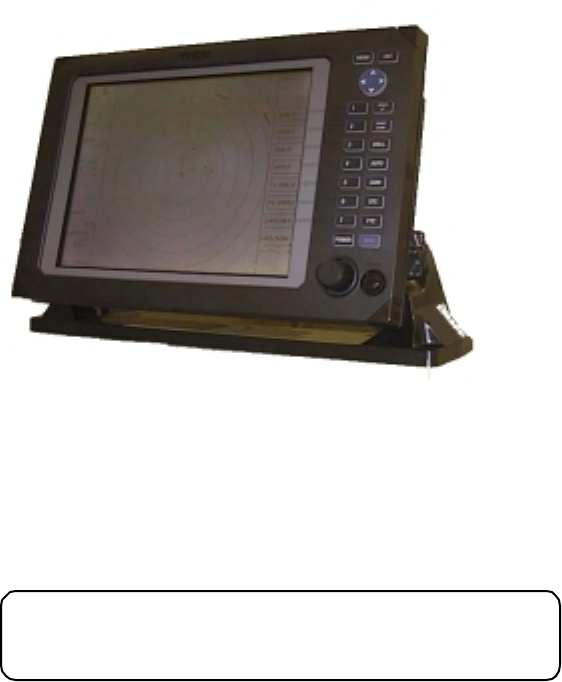
RA40C/RA41C/RA42C
Marine Radar
Instruction Manual
1st Edition
• Read this manual before using the
equipment.
Kthi l
Index
A
Adjustment
Distance ............................... 75
Angle.................................... 75
Tuning ................................. 76
Antenna height ..................... 77
Automatic gain...................... 78
Automatic STC...................... 78
ALL PPI Screen .............................. 64
ALL PPI/PPI Screen........................ 65
B
Bearing scale ................................. 26
Brightness..................................... 29
Brightness of Panel ............... 29
Buzzer........................................... 71
C
Changing setting (CUSTOM)............ 68
Continual variable range (VAR RNG) 38,50
Course error (XTE) ......................... 28
Cross cursor (+).............................. 26
D
Display modes (MODE) ................... 38,52
E
EBL ............................................ 35,46
Bearing of EBL (EBL BRG) ..... 71
Echo Menu .................................... 56
F
False echoes .................................. 5
FL VRM, FL EBL ............................ 36,47
FTC ............................................ 33,57
G
Gain ............................................ 32,56
Guard zone (GZ)............................. 38,53
Guard zone mode (GZ MODE) 73
Guard zone level (GZ LVL)...... 73
H
Heading marker ............................. 6
Heading Off (HDG OFF) ......... 38,49
Heading blink (HM FLSH) ...... 71
Heading information (HEAD) .. 28
Hold (HOLD) .................................. 73
L
Language....................................... 73
M
Mark Line...................................... 51
Menu bar....................................... 45
Man Over Board (MOB)................... 34
MOB Screen .................................. 65
Monitor operation (DISPLAY)........... 73
N
Nav (Navigation) Menu.................... 52
Navigation screen........................... 28
North mark (NORTH M) .................. 6,71
O
Off-center (OFF-C) ..........................39,54
Option............................................87
P
Parallel cursor (///CSR)..................38,49
PPI Screen......................................62
PPI/NAV Screen .............................64
PPI/PPI Screen ...............................63
PPI/SEMI3D Screen........................63
Pulse table (P TABLE)......................71
R
Radar interference ..........................6
Radar screen..................................26,27
Range ............................................ 31
Range rings (RINGS) .......................38,50
Range ring interval.................50
Reverse screen ...............................42,66
S
Semi-3D.........................................43,63
Sleep (SLEEP).................................54
Speed (SPEED, SPD SET) ................73
ST'BY ............................................29
ST'BY NAV screen...........................71
STC ............................................32,57
Stern marker (STERN M).................71
Stretch (ST)....................................41,58
Switching the screen (SEL WIN) .......42,65
System check ................................66
T
Target (TARGET).............................51
Track (TRACK)................................41,58
Tune ............................................40,57
Tune meter ...................................26
V
VAR RNG .......................................38,50
VRM ............................................35,47
Unit of VRM (RM UNIT) ..........71
W
Way point (WAYP) ...........................28
Bearing of Way point (WP BRG)... 71
X
XTE ............................................28,44
Z
Zoom (ZOOM) .................................41,59
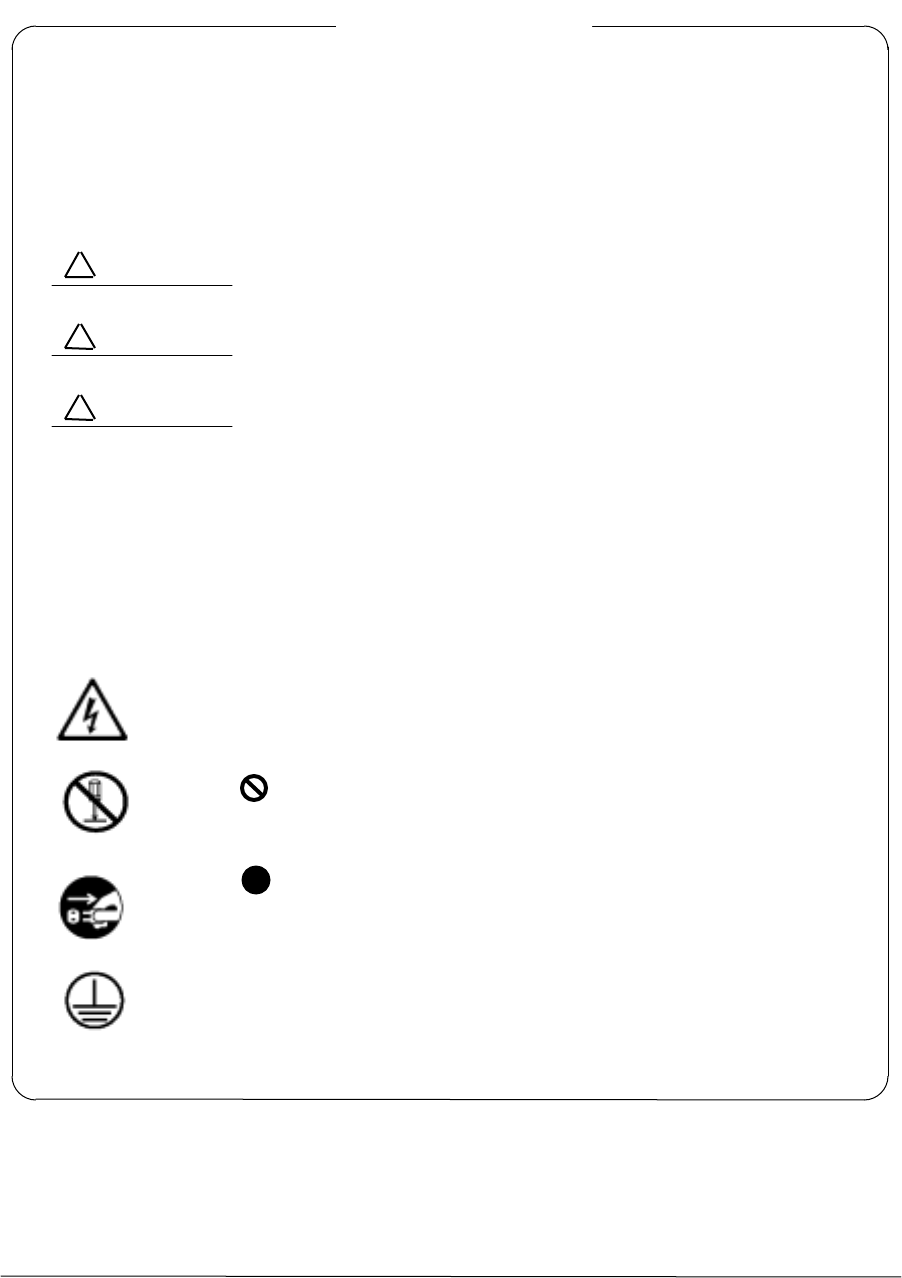
i
To prevent the risk of personal injury or damage to the equipment, the following
safety symbols are used to indicate safety-related information. Insure that you clearly
understand the meanings of the symbols BEFORE using the equipment.
Symbols Used in Manual
This indicates a very dangerous procedure that could result
in serious injury or death if not performed properly.
This indicates a hazardous procedure that could result in
serious injury or death if not performed properly.
This indicates a hazardous procedure or danger that could
result in light-to-severe injury, or that might damage the
equipment, if proper precautions are not taken.
Safety Symbols Used on Equipment
The following safety symbols are used inside or on the equipment near operation lo-
cations to provide information about safety items and operation precautions. Insure
that you clearly understand the meanings of the symbols and take the necessary pre-
cautions BEFORE using the equipment.
This indicates high voltages with a risk of serious electric shock if the part
is touched. NEVER touch the part with bare hands, etc.
The symbol prohibits the operation shown inside the symbol. (The ex-
ample in the left prohibits disassembly.)
The symbol indicates that the operation inside the symbol is potentially
hazardous. (The example on the left indicates that the plug should be held
when disconnecting it from the AC outlet.)
This indicates the ground (earth) terminal. If the equipment cannot be
grounded via the power cord, connect this terminal to ground. There is a
risk of serious electric shock if the equipment is not grounded.
RA40C/RA41C/RA42C
Marine Radar
Instruction Manual
21st Jul. 2000 (1st Edition)
Document: E-A40C/41C/42C-2-00
Safety Symbols
DANGER
!
WARNING
!
CAUTION
!

ii
•DO NOT OPEN THE COVER EXCEPT SERVICE
PERSONNEL. YOU MAY GET AN ELECTRIC SHOCK.
•SWITCH OFF SHIPS MAIN AND PULL OFF MOTOR
FUSE BEFORE MAINTENANCE.
ROTATING ANTENNA MAY HIT YOU.
• KEEP OFF DURING TRANSMISSION.
RADIATION LEVEL: 100W/m2 DISTANCE : 0.8m
RADIATION LEVEL: 10W/m2 DISTANCE : 8m
• DO NOT DROP COVER.
IT MAY HIT SOMEBODY.
• ••••••••••••••••••••••
•••••••••••••
• ••••••••••••••••••••••••
••••••••
•••••••••••••••••••••••••
• •••••••••••••••
••••• : 100W/m2 •• : 0.8m
••••• : 10W/m2 •• : 8m
• ••••••••••••••••••
•••••••••••
•DO NOT PAINT THE RADOME.
PERFORMANCE WILL DOWN.
• ••••••••••••••••••••
••••••••
WARNING and CAUTION for Scanner Unit and Antenna ;
!There is a risk of receiving electric shock if these parts are touched by
accident. Only qualified personnel should remove covers on these
parts.
"To avoid accidental antenna rotation, turn off ship’s main and pull off
out the motor fuse during repair inspect, or maintenance.
When repairing or inspecting the scanner unit wear a safety harness
and provide a secure platform so that there is no danger of falling even
when the vessel lists or when there is an unexpected incident such as
an earth quake.
#Do not approach the antenna while it is transmitting.
In addition, at inspection never look into the wave guide during trans-
mission.
$When remove the scanner cover etc., do not drop it. It may endanger
people below.
%Do not paint the RADOME. Antenna performance will be down.
For Safet
y
WARNING / • •
CAUTION / • •
•
•
•
•
•

iii
• SEE INSTRUCTION MANUALS BEFORE
CONNECTING POWER.
SAFETY INFORMATION IS WRITTEN IN.
• EARTH CONNECTION ESSENTIAL
BEFORE CONNECTING POWER.
YOU MAY GET AN ELECTRIC SHOCK.
• DO NOT OPEN THE COVER EXCEPT
SERVICE PERSONNEL.
HIGH VOLTAGE IS INSIDE.
YOU MAY GET AN ELECTRIC SHOCK.
• •••••••••••••
••••••••••••
••••••••••••••
• ••••••••••••••
•••••••••
••••••••••••
• •••••••••••••
••••••••••
••••••••••••••
••••••
WARNING for Display Unit ;
!See instruction manuals before connecting power. Safety information is
written in.
"Earth connection essential before connecting supply.
There is a risk of serious electric shock if the equipment is not
grounded.
#There is a risk of receiving electric shock if these parts are touched by
accident.
Only qualified personnel should remove covers on these parts.
WARNING / • •
•
•
•
iv
Installation
Radio laws dictate that this radar may only be installed by properly licensed personnel.
Licensing
You must obtain a license as prescribed by the Radio Law to operate this unit.
To Customers
* To use this equipment effectively, the operation and maintenance procedure in this manual
must be followed properly. Note that this equipment is only a navigational instrument hav-
ing no warrant for navigation safety. Non-execution of fundamental navigation require-
ments such as the ship location check or lookout is not allowed.
* If some abnormality occurs in this equipment, immediately turn off the equipment POWER
switch and the radar main switch in the power distribution board and notify our mainte-
nance section or dealer.
* This instrument uses oscillator and LCD backlight. They are easy to be broken. Do not
subject the instrument to excessive force or drop it.
* The mercury (Hg) is used in LCD backlight. When you discard your radar, it is due to laws
or regulations of your nations.
Contents
For safety
CHAPTER 1 OVERVIEW .................................................................... 1
1.1 Introduction.................................................................................................1
1.2 Organization of This Manual....................................................................... 1
CHAPTER 2 USING RADAR FOR THE FIRST TIME.............................. 2
2.1 What is a radar ? .........................................................................................2
2.2 Characteristics of Radar Wave .................................................................... 3
2.3 Terms Specific to Radars............................................................................. 6
CHAPTER 3 INSTALLATION............................................................... 10
3.1 Checking Contents of Your Package ........................................................... 10
3.2 Checking Power Supply Voltage.................................................................. 11
3.2.1 Power Supply Requirement....................................................................12
3.2.2 Fuse Replacement ..................................................................................12
3.3 Determining Place of Installation................................................................12
3.3.1 Scanner unit........................................................................................... 12
3.3.2 Display unit ............................................................................................12
3.3.3 Shifting away from obstacles ................................................................. 13
3.4 Installing Scanner Unit ............................................................................... 14
3.5 Installing Antenna Unit............................................................................... 15
3.6 Installing Display Unit................................................................................. 16
3.7 Connecting Cables....................................................................................... 17
3.7.0 Interconnecting cable (RA40C Radome
scanner)............................................17
3.7.1 Interconnecting cable (RA41C Radome scanner) ..................................17
3.7.2 Interconnecting cable (RA42C Open scanner)....................................... 20
3.7.3 Grounding wire....................................................................................... 21
3.7.4 Power supply cable .................................................................................22
3.8 Adjustment .................................................................................................. 22
3.9 Connecting External Equipment to Display Unit .......................................23
3.10 Countermeasure for Electromagnetic Interference .................................. 23
3.11 When Discarding Your Radar.................................................................... 24
CHAPTER 4 FUNCTIONS AND NAMES ............................................... 25
4.1 Key layout .................................................................................................... 25
4.2 Rear panel.................................................................................................... 26
4.3 Radar screen (Single screen) ....................................................................... 26
4.4 Radar screen (Dual screen) .........................................................................27
4.5 Radar screen (All PPI screen) ......................................................................27
4.6 Radar screen (All PPI/PPI screen) ............................................................... 28
4.7 Navigation screen ........................................................................................ 28
CHAPTER 5 OPERATION ................................................................... 29
Basic operation of Radar ...................................................................................29
5.1 Powering On and Off.................................................................................... 29
5.2 Adjusting brilliance of screen and key-backlight........................................29
5.3 Basic Operations ......................................................................................... 30
5.3.1 Powering On and Off...............................................................................30
5.3.2 Transmitting ...........................................................................................30
5.3.3 Adjusting brilliance of screen and key-backlight...................................31
5.3.4 Changing Distance Range (RANGE UP, RANGE DOWN) .......................31
5.3.5 Automatic adjustment (AUTO) ...............................................................31
5.3.6 Sensitivity adjustment (GAIN) ................................................................ 32
5.3.7 Removing sea clutter (STC)..................................................................... 32
5.3.8 Removing rain and snow clutter (FTC)................................................... 33
5.3.9 Man Over Board (MOB) ..........................................................................34
5.4 Functions of Soft Keys .................................................................................35
5.4.1 Bearing measurement (EBL1).................................................................35
5.4.2 Bearing measurement (EBL2).................................................................35
5.4.3 Distance measurement (VRM1) ..............................................................35
5.4.4 Distance measurement (VRM2) ..............................................................36
5.4.5 Measuring the angle between two points (FL EBL2)..............................36
5.4.6 Measuring the distance between two points (FL VRM2)........................36
5.4.7 Changing the group of Soft Keys(NEXT).................................................37
5.4.8 Erasing heading maker temporarily (HDG OFF)....................................38
5.4.9 Using parallel cursors (///CSR).............................................................38
5.4.10 Establishment of the indication of the RANGE RINGS (RINGS)..........38
5.4.11 ON/OFF of variable range function (VAR RNG) ...................................38
5.4.12 Changing display modes (MODE).........................................................38
5.4.13 Guard Zone (GZ) ...................................................................................38
5.4.14 Off Center (OFF-C)................................................................................39
5.4.15 Setting of the SLEEP function(SLEEP) .................................................40
5.4.16 Tuning adjustment (TUNE)...................................................................40
5.4.17 Echo expansion (ST) .............................................................................41
5.4.18 Displaying locus of target (TRACK) ......................................................41
5.4.19 Enlarging selected areas (ZOOM) .........................................................41
5.4.20 Increasing sensitivity (S/L)...................................................................42
5.4.21 Switching the screen (SEL WIN)...........................................................42
5.4.22 Changing the color of screen (PICTURE)..............................................42
5.4.23 Change to PPI screen (PPI)....................................................................43
5.4.24 Change to SEMI3D/PPI screen (SEMI3D)............................................43
5.4.25 Change to PPI/PPI screen (PPI/PPI).....................................................43
5.4.26 Change to PPI/NAV screen (PPI/NAV) .................................................44
5.4.27 Change to ALL PPI screen (ALL PPI).....................................................44
5.4.28 Change to ALL PPI/PPI screen (ALL PPI2)............................................44
5.5 MENU Operation..........................................................................................45
- List of MENU.................................................................................................45
5.5.1 Mark Menu..............................................................................................46
5.5.1.1 Bearing measurement (EBL1) ............................................................46
5.5.1.2 Determining the distance (VRM1) ......................................................47
5.5.1.3 Bearing measurement (EBL2) ............................................................47
5.5.1.4 Determining the distance (VRM2) ......................................................47
5.5.1.5 Measuring the distance or angle between two points ( FL EBL2, FL VRM2 )
....................................47
5.5.1.6 Measuring the angle between two points (FL EBL2)..........................48
5.5.1.7 Erasing heading maker temporarily (HDG OFF) ...............................49
5.5.1.8 Using parallel cursors (///CSR) ........................................................49
5.5.1.9 Establishment of the indication of the RANGE RINGS (RINGS) .......50
5.5.1.10 Variable range function ( VAR RNG ) ...............................................50
5.5.1.11 Output the position data of Cursor (TARGET).................................51
5.5.1.12 Follow the Distance and Bearing marker on the cursor (+MK LINE) 51
5.5.2 Nav (Navigation) Menu ............................................................................ 52
5.5.2.1 Changing display mode (MODE).......................................................52
5.5.2.2 Guard Zone (GZ) ................................................................................ 53
5.5.2.3 Shifting display in specific direction (OFF-C).................................... 54
5.5.2.4 Setting of the SLEEP function(SLEEP) .............................................. 54
5.5.3 Echo Menu................................................................................................56
5.5.3.1 Sensibility adjustment (GAIN) ........................................................... 56
5.5.3.2 Removing sea clutter (STC)................................................................57
5.5.3.3 Removing rain and snow clutter (FTC)..............................................57
5.5.3.4 Adjusting receiver tuning (TUNE) ...................................................... 57
5.5.3.5 Echo expansion (ST)........................................................................... 58
5.5.3.6 Displaying locus of target (TRACK)....................................................58
5.5.3.7 Enlarging selected areas (ZOOM) ......................................................59
5.5.3.8 Increasing sensitivity (S/L) ................................................................ 60
5.5.4 SETUP Menu .......................................................................................... 61
5.5.4.1 Initiating the screen display (WINDOW)............................................61
- Limitation of screen operation.....................................................................62
- Screen modes and Operations .....................................................................62
(a) PPI Screen ......................................................................................... 62
(b) PPI/SEMI3D Screen.......................................................................... 63
(c) PPI/PPI Screen .................................................................................. 63
(d) PPI/NAV Screen ................................................................................ 64
(e) ALL PPI Screen .................................................................................. 64
(f) ALL PPI/PPI Screen............................................................................ 65
(g) MOB Screen....................................................................................... 65
5.5.4.2 Switching screens on PPI/PPI screen (SEL WIN) ..............................65
5.5.4.3 Changing the color of screen (PICTURE) ........................................... 66
5.5.4.4 Fault Diagnosis by Self Check (SYSTEM CHECK)............................. 66
5.5.4.5 Changing the content of the setting (CUSTOM) ................................ 68
5.5.4.5.1 Changing the settings of soft keys (KEY ASSIGN).........................69
5.5.4.5.2 Changing the content of settings 1(PRESET1) .............................. 71
5.5.4.5.3 Changing the content of settings 2 (PRESET2) ............................. 73
5.5.4.5.4 Changing the content of settings (ADJUSTMENT) .........................75
(1) Adjusting distance (TIMING ADJ) ...................................................75
(2) Adjusting angle (HEAD ADJ) ...........................................................75
(3) Adjusting tuning circuit (TUNING CAL) ..........................................76
(4) Adjusting antenna height (ANTENNA).............................................77
(5) Setting GAIN circuit (GAIN) .............................................................78
(6) Setting STC circuit (STC).................................................................78
CHAPTER 6 MAINTENANCE AND INSPECTION................................... 79
CHAPTER 7 TROUBLESHOOTING......................................................81
7.1 Fault Diagnosis by Self-check .....................................................................81
7.2 Inspecting Each Part ...................................................................................82
CHAPTER 8 PRODUCT SPECIFICATIONS........................................... 83
8.1 General..........................................................................................................83
8.2 Scanner Unit .................................................................................................85
8.3 Display Unit ..................................................................................................85
8.4 External Interface ........................................................................................ 86
8.5 Standard set ................................................................................................. 87
8.6 Options ......................................................................................................... 87
8.7 External dimensions and weight ................................................................. 87
8.8 External connection and function ............................................................... 87
APPENDIX
1. RA40C GENERAL SYSTEM DIAGRAM
2. RA41C GENERAL SYSTEM DIAGRAM
3. RA42C GENERAL SYSTEM DIAGRAM
4. RA40C INTERCONNECTION DIAGRAM
5. RA41C/42C INTERCONNECTION DIAGRAM
6. OUTLINE DRAWING DISPLAY UNIT
7. RA40C OUTLINE DRAWING SCANNER UNIT
8. RA41C OUTLINE DRAWING SCANNER UNIT
9. RA42C OUTLINE DRAWING SCANNER UNIT
10. FLUSH MOUNT PROCEDURE
11. INDEX
RA40C TEMPLATE OF SCANNER MOUNTING HOLES (ACTUAL SIZE)
RA41C TEMPLATE OF SCANNER MOUNTING HOLES (ACTUAL SIZE)

1
CHAPTER 1 OVERVIEW
1.1 Introduction
The RA40C/41C/42C represents a compact, high-performance color marine radar
that delivers a peak power output of 2 kW(RA40C) or 4 kW(RA41C/42C) from the an-
tenna and uses an 10-inch color liquid crystal display.
In addition to a microcomputer, it incorporates a video signal processing LSI and a
newly developed LSI chip exclusively designed for radars, thus providing versatile func-
tionality and high performance.
Features
1. A thin display unit incorporating a liquid crystal display.
2. Easy operation using only a few keys and menu screens.
3. A position of key and its function can be set in position ( Selectable soft func-
tion key).
4. Easy operation by the rotary knob.
Gain, STC, FTC, EBLs, VRMs etc. can be controlled by the rotary knob.
5. A short and a long range echo can be seen at a time ( Dual range radar).
6. Semi-3D screen display for easy identification of targets in noise.
7. Capable of continuous distance range changes (Continual variable range).
8. Waterproof construction of display allows installation at any desired location.
1.2 Organization of This Manual
This manual provides a wide range of information necessary to operate the
RA40C/41C/42C
radar ranging from the basic knowledge on radars to the methods of operating, installing,
and maintaining the radar. The manual also provides rather detailed technical informa-
tion on how to adjust video display to obtain clear images. You are requested to read this
manual thoroughly from beginning to end in order to understand the various functions of
the radar so you can take full advantage of its advanced functions. If you are using a
radar for the first time, refer to the basic data on radars in CHAPTER 2.
This manual consists of the following chapters:
USING RADAR FOR THE FIRST TIME ...................... CHAPTER 2
INSTALLATION ...................... CHAPTER 3
FUNCTIONS AND NAMES ...................... CHAPTER 4
OPERATION ...................... CHAPTER 5
INSPECTION AND MAINTENANCE ...................... CHAPTER 6
TROUBLESHOOTING ...................... CHAPTER 7
PRODUCT SPECIFICATIONS ...................... CHAPTER 8
If you are an experienced user of radars, skip CHAPTER 2 and begin from CHAPTER
3.
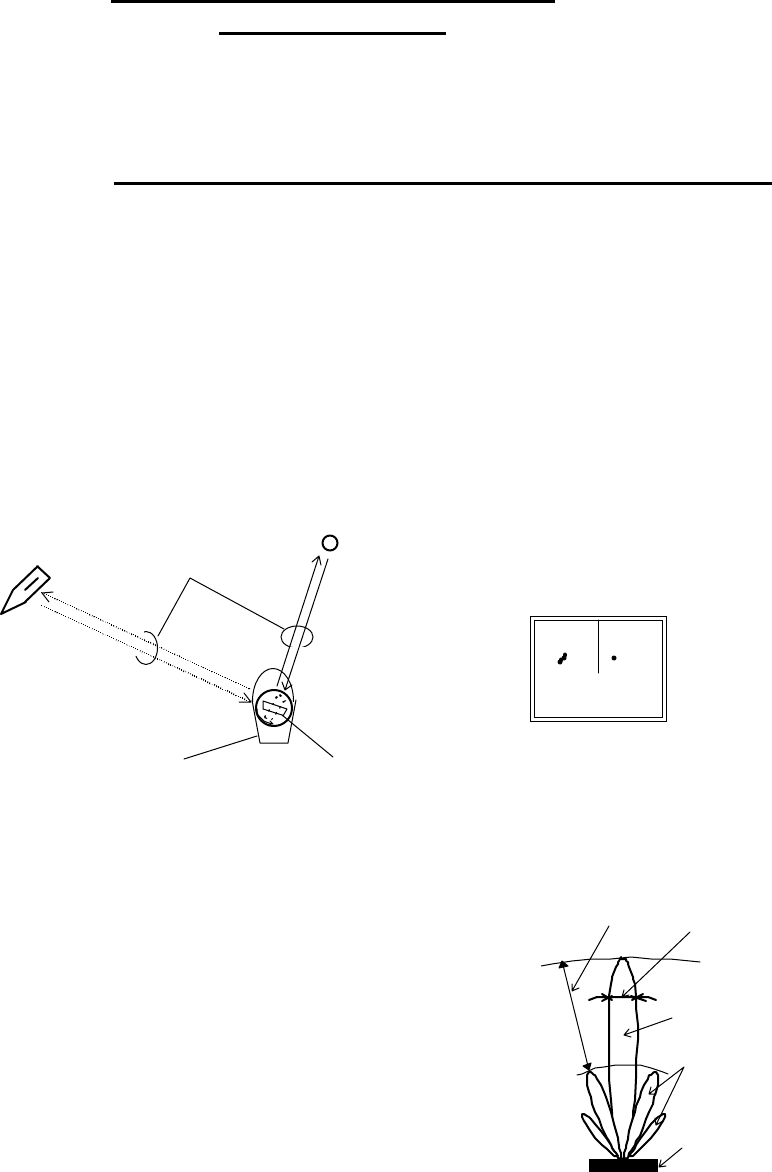
2
CHAPTER 2. USING RADAR FOR
THE FIRST TIME
This chapter describes basic information on radars and explains technical terms used
in radar operation for those who is using a radar for the first time.
2.1 What is a radar ?
A marine radar is one of the navigation equipment installed on a ship. It emits a radio
wave in very high frequency called a microwave from its antenna and receives the reflected
radio wave from objects on the sea (e.g., other ships, buoys, and lands). The received radio
wave is converted into an electric signal which is displayed on a display screen to indicate
the presence of such objects. Although it is very difficult to find other ships or the destina-
tion coast with human eyes at night or in thick fog, a radar helps you detect objects on the
sea helping you avoid danger when sailing. The antenna turns 360 degrees as it radiates
waves, allowing you to grasp ambient conditions around your ship at a glance.
The radio wave radiated from the antenna is called a pulse wave and the radar performs
transmission and reception alternately. Several hundred to several thousand pulse waves
generally are transmitted while the antenna rotates one turn.
Antenna
There are many types of antennas generally used for a
radar. For example, these include a parabolic antenna and
a slotted-array antenna. The performance of the antenna
determines that of the radar. The dominant factors are the
antenna's beam width and side lobe level. The narrower
the beam width, the higher the resolution of the angle
direction. The lower the side lobe level, the fewer the effect
of a false echo.
Side lobe
A beam in one direction in which the strongest
radio wave is radiated from the antenna is called the
main lobe and beams in other directions are called
"side lobes". The side lobe level refers to the differ-
ence in level between the largest side lobe and the
main lobe.
Buoy
Other ship Radar wave
Your ship Antenna (Rotating)
Radar display
Fig.2-1 What is a radar?
Beam width
Side lobe
level
Main beam
Side lobe
Antenna
Fig.2-2 Antenna pattern
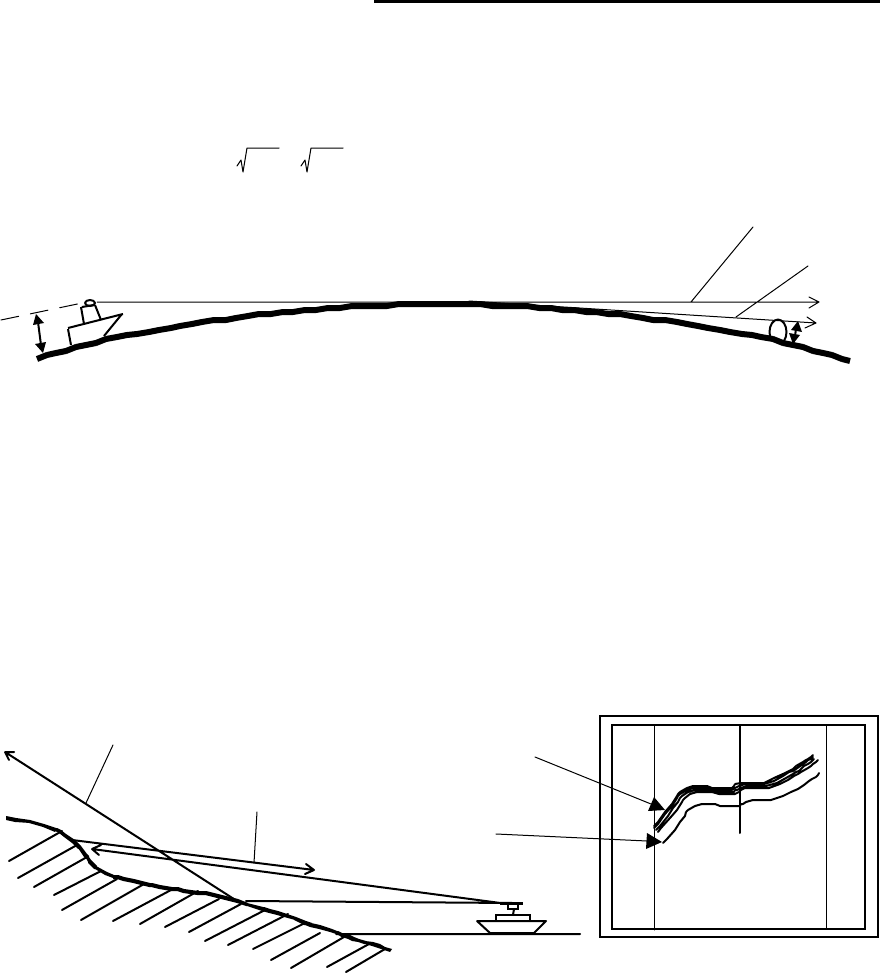
3
Beam width
A beam width is defined as the width of the main lobe at an angle where the radi-
ated power is halved as measured from the position from which the strongest radio
wave is radiated.
2.2 Characteristics of Radar Wave
Radio waves from the radar propagate while bending slightly along the terrestrial sur-
face. This characteristic varies dependent on the density of the atmospheric air. The sight
distance D of a radar generally is said to be approximately 6% longer than the optical sight
distance and is calculated using the equation below :
D (NM) = 2.22 ( h1 + h2 ) where, h1= antenna height in meters
h2= target height in meters
Fig.2-3 Radar wave
Targets difficult to display on screen
The intensity of the reflected wave from a target depends on the distance, height,
and size of the target, as well as its material and shape. Targets constructed with
FRP, wood, or other low-reflectance materials or those that have a small incident angle
are difficult to display on a screen. Therefore, FRP and wooden ships, sandy beaches,
and sandy or muddy shallows all are difficult to catch and require attention when
monitoring on the screen. Especially, coast lines on the radar image appear to be pre-
sent more apart from the ship than they are actually located. Therefore, it is important
not to misinterpret the available data.
Shadow zones of radar
Radar waves are characteristic in that they propagate straight ahead. Therefore,
if the ship's smokestack or mast is located near the antenna or there is a tall ship or
mountain at the side of the ship, such an object generates a shadow behind it. In this
Apparent coastline
Actual(invisible)
coastline
Invisible
Visible
3
1
HU
Fig.2-4 Targets difficult to display on screen
h1 h2
Line of sight
Radar Radio
Wave
Earth
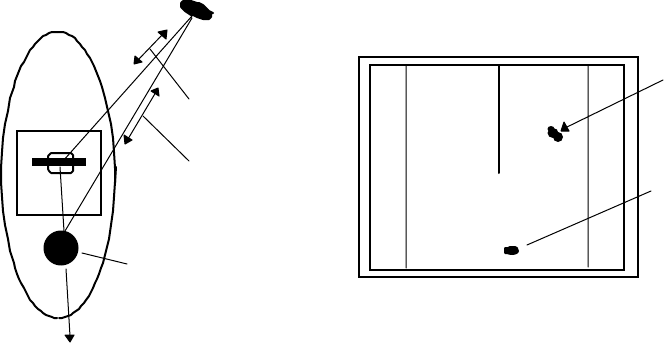
4
case, some objects produce a complete shadow and some produce a partial shadow. In
an extreme case, the shadow of an object may extend to a position far away and can-
not be displayed on the screen at all. Since these shadows can be discovered when in-
stalling an antenna, the problem can be avoided by changing the place of antenna in-
stallation to minimize the shadow. Targets in shadow zones are difficult to display on
the screen.
False echoes
A false echo of an actually nonexistent object may sometimes appear on the
screen when sailing. The following explains the cause of each of such phenomena.
A. Ghost echoes
It sometimes happens that one large object near the ship appears at two different
bearings. One is the actual echo and other is a ghost echo generated as the wave is re-
reflected from the ship's own smokestack or mast. The former appears at the correct
distance and bearing on the screen and the latter appears behind the smokestack or
mast. This type of false echo is also generated by re-reflection of waves from bridges
and quay walls other than the ship itself.
B. Multiple echoes
If there is a large vertical reflecting plane near the ship as in the case when your
ship passes alongside a large ship, the wave is repeatedly reflected back and forth
between your ship and the other object. For this reason, two to four images appear on
the screen at equal intervals in the same bearing. A false echo that is generated by
such multiple reflections is called multiple echoes. In this case, an image appearing at
the nearest position is the real echo. Multiple echoes disappear as the ship moves
away from the reflecting object or its bearing changes. Therefore, it is not difficult to
determine the correct image.
Target
Direct reflection
path
Secondary
reflection path
Mast etc.
Real echo
Ghost echo
Direction of ghost echo
3
1
HU
Fig.2-5 False echoes of radar (Ghost echoes)
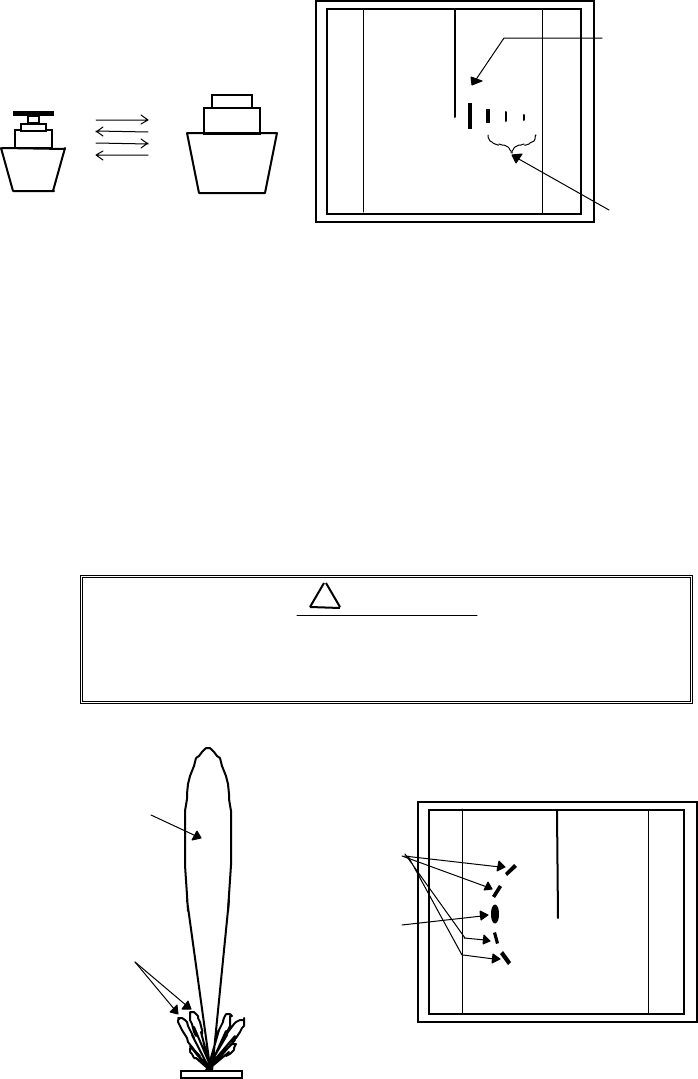
5
C. False echoes caused by side lobe
The radiant beam emitted from an antenna contains side lobes in directions other
than that of the main beam. Since the side lobe level is low, it in no way affects distant
targets. However, if there is a strong reflecting target near the ship, it sometimes ap-
pear as a circular-arc false echo on the screen.
When located near large targets such as land, the
ship's mast, etc. sometimes appears as a false
echo of circular-arc shape.
3
1
HU Real echo
Multiple
echoes
Fig.2-6 False echoes of radar (Multiple echoes)
3
1
HU
Antenna
Main beam
Side lobes
Real echo
False sidelobe
echoes
Fig.2-7 False echoes of radar (Caused by side lobe)
CAUTION
!
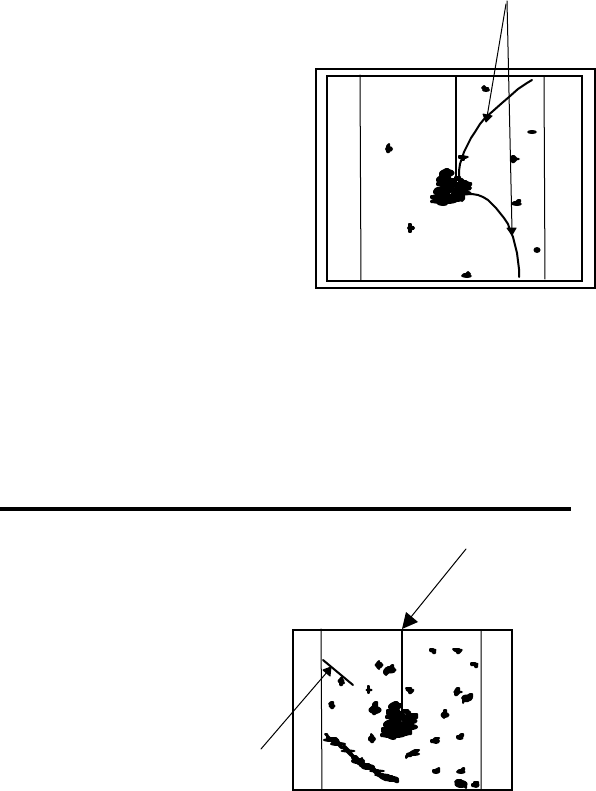
6
D. Distant false echoes caused by duct phenomenon
Depending on meteorological conditions, duct phenomenon sometimes occurs in
temperature inverting layers of air. In such a case, the wave propagates erratically
reaching a location surprisingly far away from the ship. In this case, a target present
at a distant location more than the radar's maximum distance range appears on the
screen presenting a false echo that can be misunderstood to be present nearer than
the actual position. This phenomenon is attributed to the fact that since echo from the
distant target arrives late, it gets out of the pulse repetition frequency and is displayed
on the screen as an echo in the next frequency. If the target distance changes as you
switch over the distance range, you can determine that it is a false echo.
Radar interference
If a radar operating in the same frequency exists near
your ship, interference noise may appear on the screen
that is caused by transmitted waves from that radar. This
interference appears in various ways. In most cases, how-
ever, it appears as spiral or radial patterns.
The RA40C/41C/42C radar has a function to elimi-
nate interference. Use of this function helps you minimize
interference.
2.3 Terms Specific to Radar
HM (Heading Marker)
This is a line-shaped marker used to indi-
cate the advancing direction of your ship.
North Mark
This marker indicates the north direction.
It is a short line approximately 1/6 of the
screen size.
3
1
HU
Radar inrterference
Fig.2-8 Radar interfer-
ence
0.75
0.25
HU
HM(Heading Marker)
North Mark
Fig.2-9 Heading Marker and
North Mark
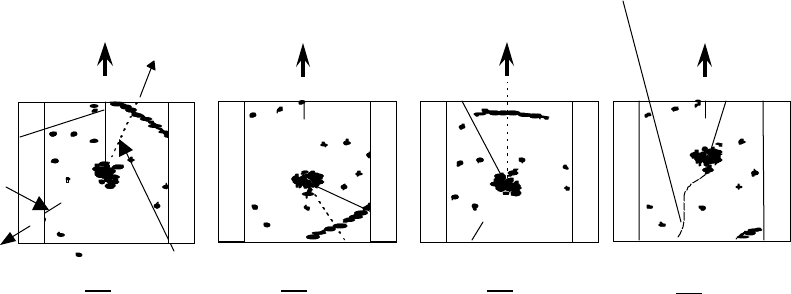
7
Display modes
This refers to a radar's display modes. There are four display modes depending on the
direction in which the top of the screen faces with respect to the ship.
Head Up (HU)
In this mode, the ship's heading always indicates the upward direction of the
screen. This mode lets you know the relative positions of your ship and other ships or
land.
North Up (NU)
In this mode, the north direction always indicates the upward direction of the
screen, allowing you to compare your ship position with a marine chart as you navi-
gate.
Course Up (CU)
The ship's heading in a course-up mode always indicates the upward direction of
the screen as the bearing toward the destination. In this mode, the ship can be ma-
neuvered to sail the shortest distance to the destination by steering it in such a way
that its heading marker always directs to the upward direction of the screen. If the
ship drifts due to tidal current, care must be taken because the fixed targets move to
other positions.
True Motion (TM)
In this mode, the ship is displayed as if it is moving on a marine chart while the
fixed targets such as islands and seashores are fixed in position. When the ship
reaches a certain position on the screen (approx. 2/3 of screen size), the ship is placed
back to the opposite side on the screen. (The top of the screen faces north.)
Note: Navigation equipment such as a gyrocompass or magnet compass must be con-
nected to your radar system before it can be operated in NU, CU, and TM modes.
(Refer to Section 3.9 for details on how to connect your radar to navigation equip-
ment.)
Ship's
Heading
North
Scheduled
course
HM
EBL
North
mark
HU NU CU TM
Ship's locus
(not displayed on screen)
North
North Scheduled
course
0.75 0.75 0.75 0. 25
TM
0.25
CU
0.25
NU
0. 25
HU
0.75
Fig.2-10 Display modes
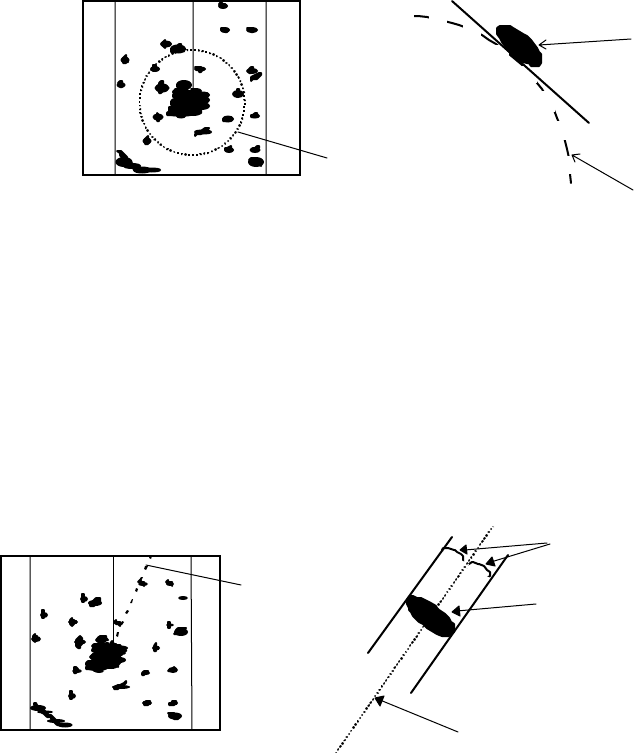
8
VRM (Variable Range Marker)
This is a circular-shaped marker whose size can be changed as desired. You can use
this marker when you want to examine the distance of an echo from your ship.
When measuring the distance of an echo from your ship, be sure to measure at a
point close to the center of the echo image on the screen.
EBL (Electronic Bearing Line)
This is a marker shaped like a straight line segment that can be changed to any direc-
tion centering around the ship position. Use this marker to examine the advancing direc-
tion of your ship and its relative angle with an echo. When measuring the angle of an echo,
position the marker at the center of the echo.
VRM
Echo
0.75
0.25
HU
VRM
Fig.2-11 VRM
0.75
0.25
HU EBL Echo
EBL
Equal intervals
Fig.2-12 EBL
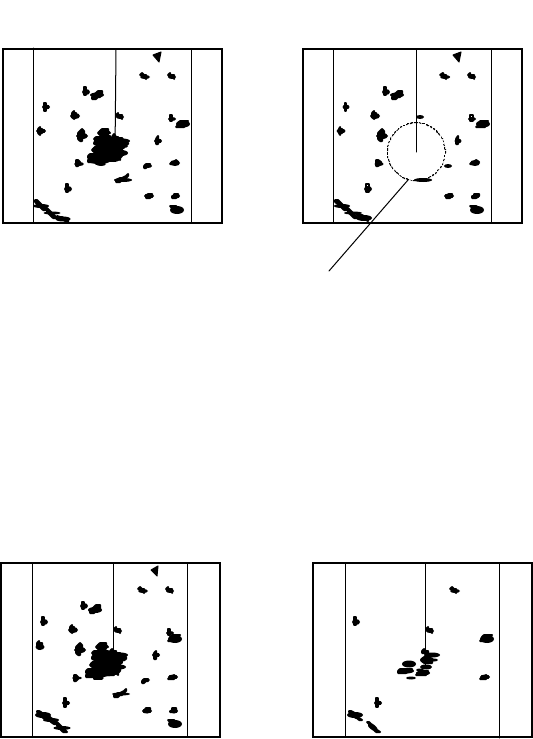
9
STC (Sensitivity Time Control)
Since echo signals received by the radar are strong when they are coming from a short
distance, it is difficult to compare signal strength between each reflected signal. To over-
come this difficulty, signal strength is adjusted in such a way that the received signal levels
coming from a short distance are lowered and those from a long distance are raised. This
function should prove useful when there are large reflected waves from sea surfaces during
rough weather.
FTC (Fast Time Constant)
When it rains or snows, fine noise may appear over the entire screen, making it diffi-
cult to identify echoes. In such a case, echo images on the screen can be made easily distin-
guishable by adjusting FTC.
0.75
0.25
HU
STC OFF STC ON
0.75
0.25
HU
Echo is suppressed
around center
Fig.2-13 STC
0.75
0.25
HU
FTC OFF FTC ON
0.75
0.25
HU
Small noises
are reduced.
Fig.2-14 FTC
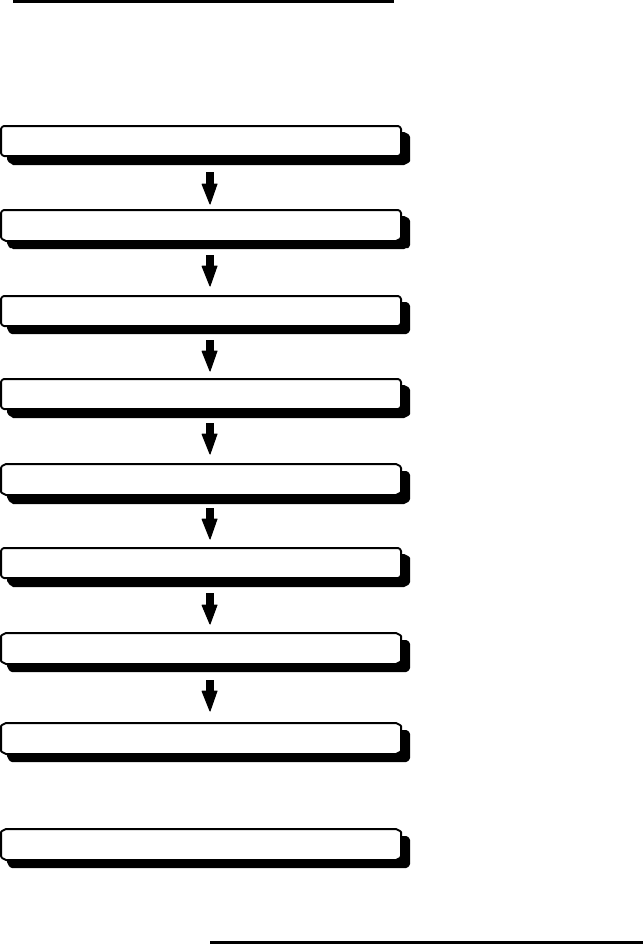
10
CHAPTER 3. INSTALLATION
This chapter describes procedures for installing the RA40C/41C/42C radar in your
ship and precautions to be observed during installation. Follow the procedure below to in-
stall the radar.
3.1 Checking Contents of Your Package
First, unpack your package and see if all of the following items are included.
RA40C RA41C RA42C
Item Q'TY Q'TY Q'TY
Display unit 1 (RF719A) 1 (RF719A) 1
(RF719A) Scanner unit 1 (RB714A) 1 (RB715A) 1
(RB716A) Display cover 1 1 1
Fuse 2 2 4
Interconnecting cable 1 (10 m) 1 (10 m) 1 (10 m)
Power supply cable 1 (2 m) 1 (2 m) 1 (2 m)
M10 hexagonal bolt 4 sets 4 sets 0
M12 hexagonal bolt 0 0 4 sets
Carbon brush 0 0 2
Checking contents of your package
Checking power supply voltage
Determining place of installation
Installing scanner unit
Installing display unit
Connecting cables
Adjustment
Connecting external equipment
When discarding Your radar
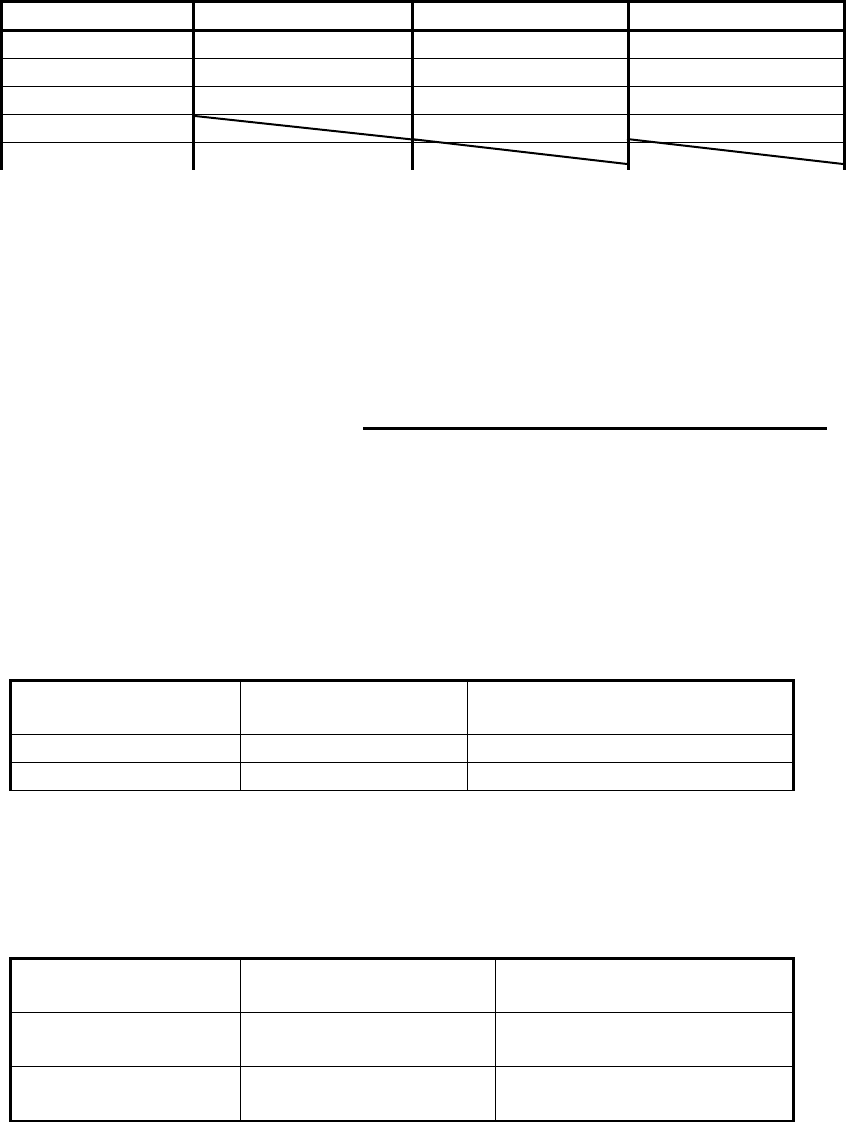
11
The package contains a 10m interconnecting cable as an accessory. Longer cable is
also available as an option as listed in Tab.3-1.
Tab.3-1 Optional Interconnecting Cable
In addition to the above components included with your package, the following items
are also required. Please prepare them separately.
Item QTY Remarks
Tapping screw or M5 bolt and nut 6 sets To install display unit
Grounding wire 1 Earth line for display unit
Grounding wire and crimp terminal 1 set Earth line for scanner unit
3.2 Checking Power Supply Voltage
3.2.1 Power Supply Requirements
For the RA40C/41C/42C radar to be operated normally, the power supply (battery)
detailed in Tab.3-2 is required. Note also that if the battery is discharged, its voltage may
fluctuate greatly, causing the radar to malfunction. When start up the radar system or start
transmitting, an additional rush current is required on the power line. Carefully check the
power supply system including wiring by using a circuit tester.
Tab.3-2 Power Supply Requirements
*A.C. power cannot be used
3.2.2 Fuse Replacement
For the RA40C/41C/42C radar to be operated safely, proper rating fuses must be
used. Tab.3.3 and Tab.3.4 are fuse rating tables for RA40C/41C and RA42C. Check them
and replace to the fuse in the package.
Tab.3-3 Supply Voltage to Fuse Table for RA40C/41C
Tab.3-4 Supply Voltage to Fuse Table for RA42C
RA40C RA41C RA42C
Cable length Product No. Product No. Product No.
15m 242J160680B 24Y159099B 24Y159169B
20m 242J160680C 24Y159099C 24Y159169C
25m 24Y159099D 24Y159169D
30m 242J160680D
Supply voltage
used Maximum current Allowable range of voltage
DC12V 5A 10.2-41.6V
DC24V 2.5A 10.2-41.6V
Supply voltage
used Main Fuse Motor Fuse
DC12V 8A/250V or 125V *
(6.3• x 32mm) T3.15A/250V or 125V *
(5• x 20mm)
DC24V 8A/250V or 125V
(6.3• x 32mm) T3.15A/250V or 125V
(5• x 20mm)
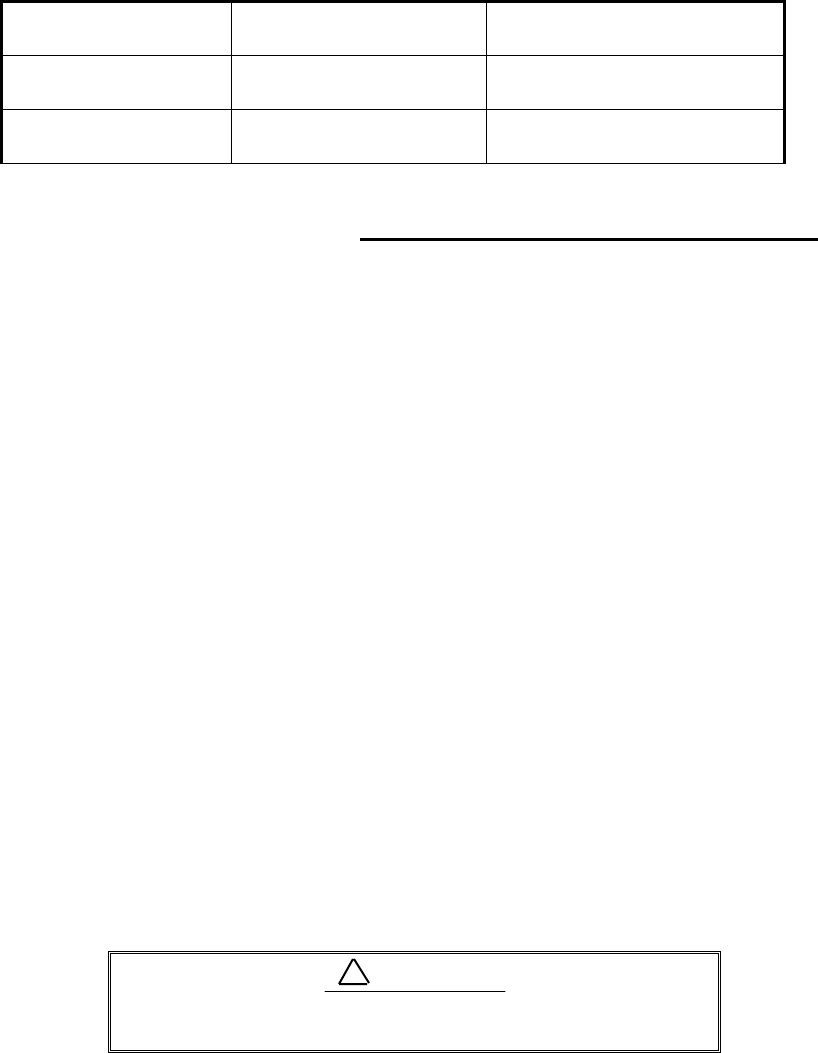
12
•••Note: Marked * fuses are in the set as standard.
3.3 Determining Place of Installation
3.3.1 Scanner unit
A radar's target detection capacity varies greatly depending on the fitted position of the
scanner. An ideal fitting position is a location high above the ship's keel line where there is
no obstacle all around the scanner. In an actual ship, such an ideal location is limited by
various factors. Therefore, consider the following suggestions when you determine the place
to install the scanner:
(a) Install scanner at a position as high as possible.
The higher the installation position, the longer the radio ranging distance.
Install the scanner at a position as high as possible after considering the ship's
hull structure and radar maintainability.
(b) Install scanner away from smoke-stack and mast
If the scanner is installed at the same height as the smoke-stack or mast,
radar waves may be blocked, creating shadow zones or generating false echoes.
Therefore, do not install the scanner at such a position.
(c) Install scanner forward away from obstacle.
To avoid creating shadow zones or generating false echoes, install the scan-
ner at a position nearer to the ship's bow away from obstacles. When installing
the scanner on a mast, position it in front of the mast. (If obstacles cannot be
avoided for the ship's structural reasons, refer to "Shifting away from obstacles"
described Page 13.)
(d) Do not install the scanner near hot or heat-generating items.
Do not install the scanner at a position where it may be subjected to smoke
or hot air from smokestacks or heat from lamps.
(e) Install the scanner away from antennas of other equipment.
Install the scanner as much away from the antennas of a direction finder,
radio transceiver, etc. as possible.
To eliminate the interference, install the scanner
away from the antenna of radio transceivers.
(f) Make the cable length as short as possible.
Keep the distance from the scanner to the display unit within the standard
cable length of 10 m. If you use longer cable for unavoidable reasons, limit the
cable length to a maximum of 30 m for RA40C and 100 m for RA41C/42C.
3.3.2 Display unit
The display unit can be installed on desktop, wall surface, or ceiling. Determine the
place to install the display unit that is convenient for navigation and radar operation after
considering the following suggestions:
Supply voltage
used Main Fuse Motor Fuse
DC12V 10A/250V or 125V
(6.3• x 32mm) 5A/250V or 125V
(5•x 20mm)
DC24V 8A/250V or 125V *
(6.3• x 32mm) T3.15A/250V or 125V *
(5• x 20mm)
!CAUTION
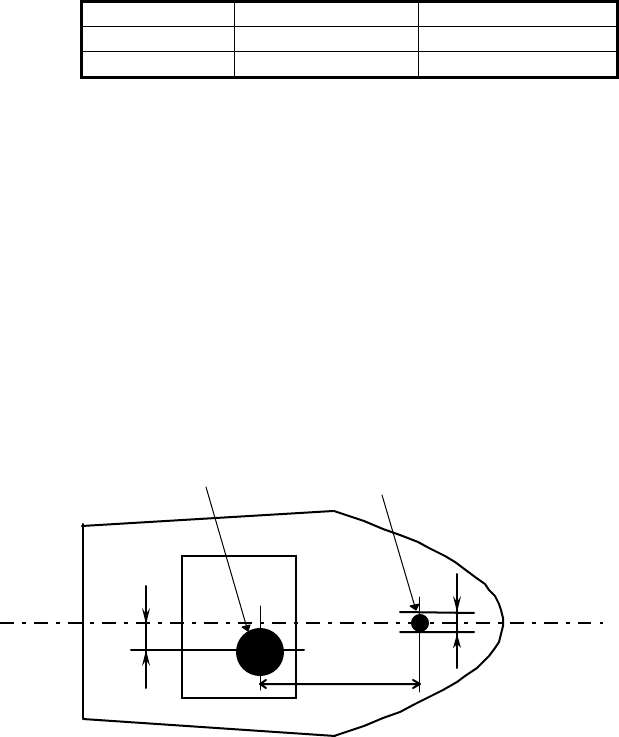
13
(a) A place where you can see the ship's bow when you raise your face from the
radar screen.
(b) A place where there is no direct sun-light to avoid display temperature up.
(c) A place where there is good ventilation and minimum vibration.
(d) A place where the display unit is apart more than the minimum safe dis-
tance from a magnet compass as listed in Tab.3-5 below.
Tab.3-5 Minimum Safe Distance from Magnetic Compass
3.3.3 Shifting away from obstacles
!
!!
! Shifting from keel line
By shifting the scanner position from the keel line to the starboard side of
the ship, it is possible to move shadow zones to the port side which makes it
possible to keep clear vision in the bow direction. The distance to be shifted can
be obtained by calculation depending on the distance from the scanner to obsta-
cles using the following equation:
Ls=0.4R+D/2 [m] (when R<15m)
Ls=0.025R+D/2 [m] (when R>=15m)
where Ls = distance to be shifted from keel line
D = diameter of obstacle on keel line
R = distance from scanner to obstacle
"
""
" Obtaining sufficient dip angle
Raise the scanner position so that there is a sufficient dip angle θ available
between the line of sight from the scanner to the obstacle and the horizontal
line. By raising the dip angle above 5°, it is possible to prevent mid- and long-
distance shadow zones. The radar cannot detect objects below the line of sight.
Master compass Steering compass
Scanner unit 2.0m 1.4m
Display unit 2.0m 1.4m
Ls
R
D
Scanner Unit Obstacle
Keel line
Fig.3-1 Shifting from keel line

14
Horizontal line
Line of sight
θ
Fig.3-2 Obtaining sufficient dip angle
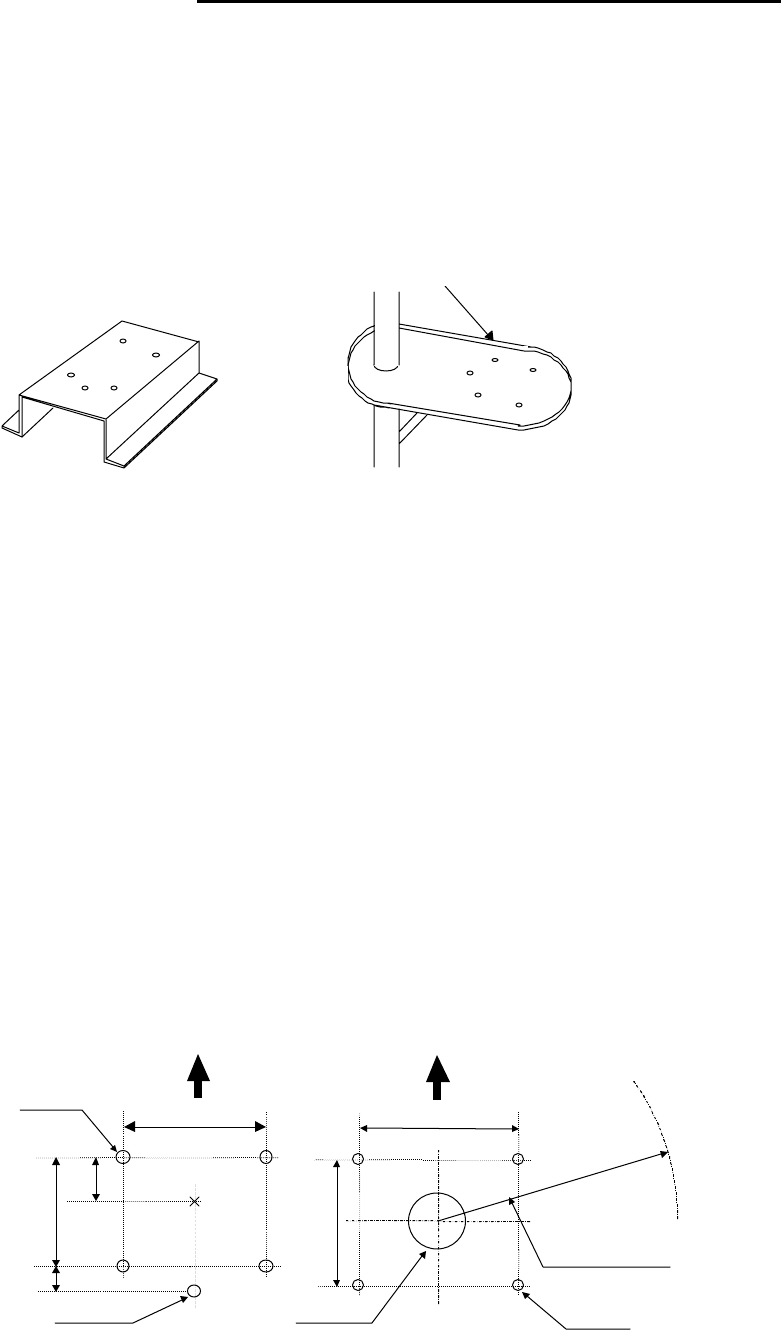
15
3.4 Installing Scanner Unit
When you have decided the place of installation, install the scanner unit. If a mount
base like the one shown below is available, it may be easier to install the scanner. If such a
mount base is not available in your ship, you may install the scanner directly to the roof,
etc. In such a case, pay attention to the water drain tube located at the bottom of the scan-
ner unit during installation.
Note : When the radar mast or mounting bracket has a curvature of more than 2mm, repair
it or use spacers.
Referring to Fig.3-4, open holes in diameter of 12 mm (0.47 in.) at five locations in the
mount base and use these holes to fix the scanner unit to the mount base with hexagonal
bolts. (Use the template included with this manual.) The bolts included with your radar
equipment will suffice for mount base thickness of 9 to 14 mm (0.35 to 0.55 in.). If the
mount base is thicker or thinner than this, prepare bolts listed in Tab.3-6.
Use sealing of silicon when you prevent the bolts from becoming loose. Radome may be
broken if you use locking putty.
Do not use an edge that might trap water.
Fig.3-3 Mount base
Center
214
170
12φ × 4
Unit:mm
65
Forward
(8.43 in.)
(2.56 in.)
(0.47 in.)
35
(1.38in.)
For air tube
(6.69 in.)
15φ (0.59 in.)
199
(7.83 in.)
Forward
185
(7.28 in.) Rotation Radius
R550 (3 ft antenna)
R700 (4 ft antenna)
14φ × 4
(0.55 in.)
Cable inlet
100φ (3.97 in.)
RA41C
Radome scanner RA42C
Open scanner
Fig.3-4 Hole positions for mounting scanner
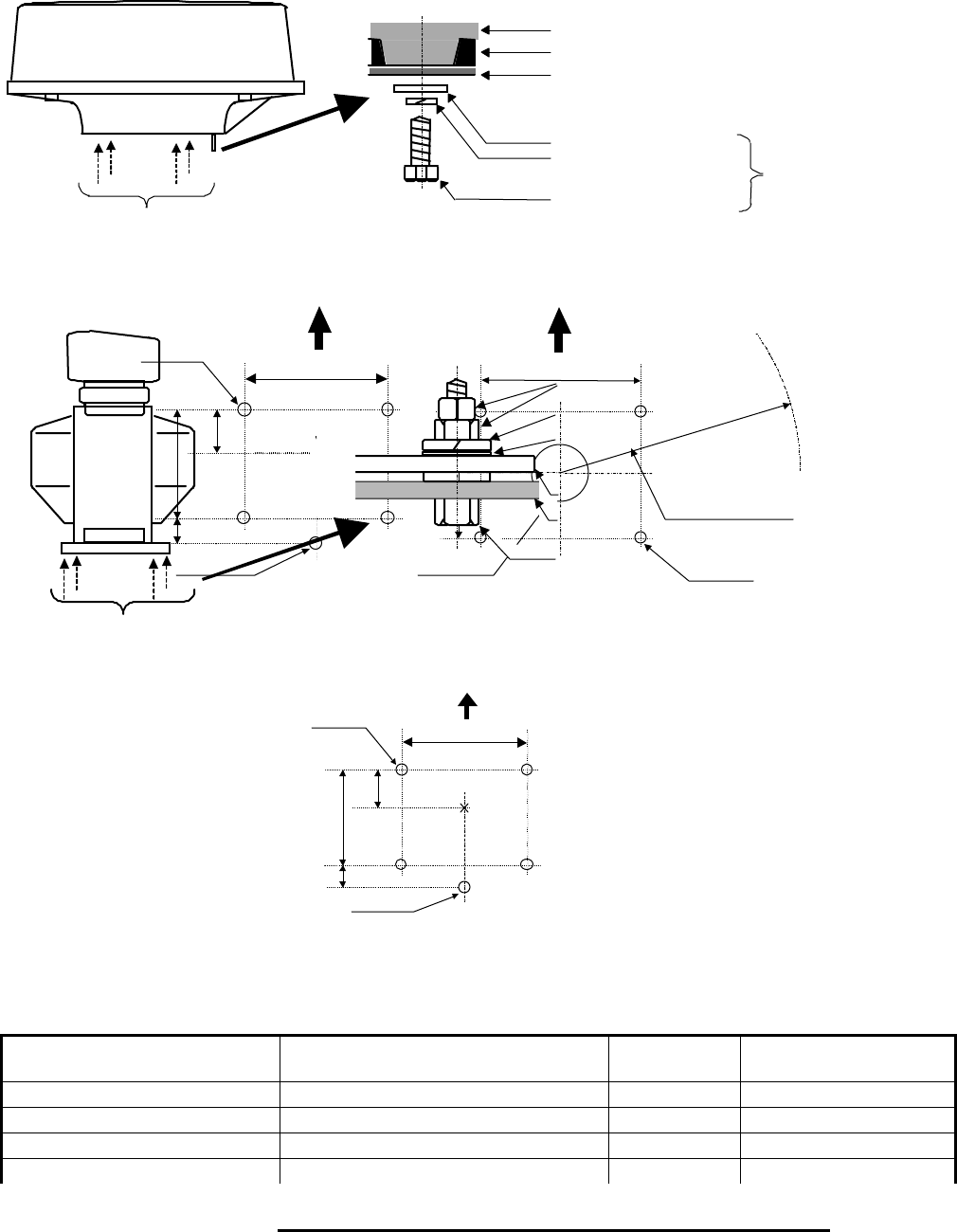
16
Tab.3-6 Bolts for Mounting Scanner Unit
3.5 Installing Antenna Unit
Center
140
140
12φ × 5
60
Forward
(5.51 in.)
(2.36 in.)
(0.47 in.)
30
(1.18in.) For air tube
(5.51 in.)
••••••RA40C • Radome scanner
Center
214
170
12φ × 4
Unit:mm
65
Forward
(8.43 in.)
(2.56 in.)
(0.47 in.)
35
(1.38in.)
For air tube
(6.69 in.)
15φ (0.59 in.)
199
(7.83 in.)
Forward
185
(7.28 in.) Rotation Radius
R550 (3 ft antenna)
R700 (4 ft antenna)
14φ × 4
(0.55 in.)
Cable inlet
100φ (3.97 in.)
RA41
Radome scanner RA42
Open scanner
Fig.3-4 Hole positions for mounting scanner
Fix four screws
Mount base
Washer
Spring washer
M10 Hexagonal bolt
Radome(bottom)
Chassis
Included
Fix four screws
RA40C/41C Radome scanner
RA42C Open scanner
Double nuts
Spring washer
Washer
M12 Hexagonal bolt
Mount base
Scanner base
Fig.3-5 Fixing Scanner Unit
Thickness of
mount base Bolts necessary to
fix radome scanner Material Remarks
1-4mm(0.04-0.16 in.) M10/M12 × 15 (1.5mm pitch) Stainless
4-9mm(0.16-0.35 in.) M10/M12 × 20 (1.5mm pitch) Stainless
9-14mm(0.35-0.55 in.) M10/M12 × 25 (1.5mm pitch) Stainless Included with radar
14-19mm(0.55-0.75 in.) M10/M12 × 30 (1.5mm pitch) Stainless
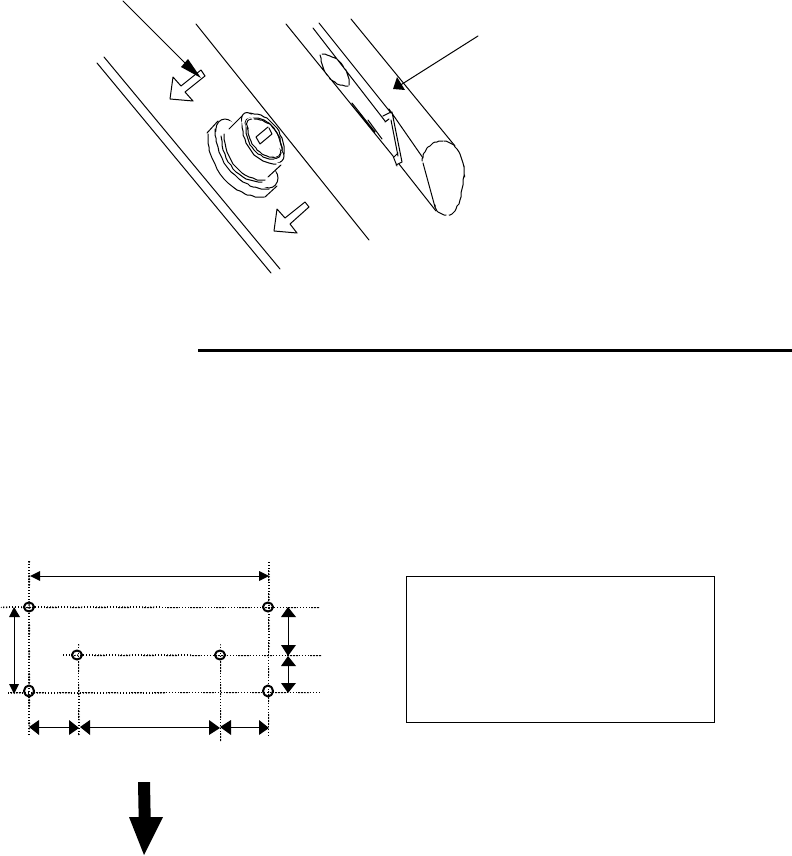
17
Remove the protective cap covering the rotary coupler on the top of the scanner. Match
the antenna radiation direction to direction of the arrow markings on the rotation base and
fix the antenna in position using the four M8 accessory bolts.
3.6 Installing Display Unit
After you have finished installing the scanner unit, install the display unit in the same
way. Choose the proper bolt length according to the thickness of the surface on which you
are going to install the display unit. Hole diameter is different using bolts from using tap-
ping screw. When using tapping screw, open holes in adequate holes. When using bolts and
nuts, open holes in diameter of 6 mm (0.24 in.). When you have opened holes, install the
pedestal part first and then the display unit.
Note : When you install the display by flush mount, refer to appendix "OUTLINE DRAWING".
Slide off four triangle corner cover, and fix the display unit to the panel with screws. After
fixing the display unit, put on corner covers to the corner of the display unit. See APPENDIX.
360
84
Fitting hole
(14.17 in.)
(3.31 in.)
Hole diameter
6mm : Bolts and Nuts
Adequate : Tapping screws
Recommended screw
M5 or equivalent
Unit : mm
47 (1.85 in.)
37 (1.46 in.)
60
(2.36 in.)
240
(9.45 in.)
60
(2.36 in.)
Forward
Fig.3-6 Hole positions for display unit
Antenna radiation surface
Arrow

18
Avoid a display from operating under direct sun-
light. It becomes high temperature at inside of dis-
play and display may be broken.
!WARNING

19
3.7 Connecting Cables
Lay cables firmly in place by following the instructions below.
Note1: Do not bind the cable for the radar collectively with cables of other
equipment (especially power supply cable).
Note2: Leave clearance near the inlet of the display so you can remove the dis-
play unit easily. This facilitates installation and maintenance of the dis-
play unit. (Refer to Appendix.)
Note3: Because the cable has a connector fitted on the display and scanner side,
if it is necessary to pass cable through a narrow path, fix the scanner-side
connector vertically using vinyl tape before passing cable through the
path.
Note4: Lay cable along the ship's hull or wall surface and attach it in place at
intervals of about 40 cm.
3.7.0 Interconnecting cable (RA40C Radome scanner) (See Fig.3-8-1)
!Ensure that the radar is off. Connect the cable to the receptacle labeled "SCANNER"
on the rear panel of the display unit.
"Next, remove the upper part of the radome from the scanner unit. Avoid bumping it
against the antenna by lifting vertically. (There are three fixing screws.)
#Remove the tape fixing the antenna.
$Remove the shield cover located on the astern side. (There are three fixing screws.)
%Remove the cable clamping plate and rubber ring, pass cable through the introduc-
tion opening, put the rubber ring from both ends of it, and clamp the cable to the
scanner unit with screws via the fixing plate. Plug the connector fitted to the cable
into the X1 connector on the PCB.
&Replace the aluminum cover. At this time, attach a cable shield onto a ditch with
the aluminum cover. However, be careful that the cable will not be caught up be-
tween the main unit and cover.
•• ' Replace the upper part of the radome. Be careful not to bump it against the antenna
in
the same way as when removing it. Make sure that the cover is fitted in the correct
direc-
tion as shown in Fig.3-7-1. The upper and lower parts of the radome each have
three
markings indicating screw positions. Align the upper and lower positions as you
mount
the radome.
3.7.1 Interconnecting cable (RA41C Radome scanner) (See Fig.3-8-2)
!Ensure that the radar is off. Connect the cable to the receptacle labeled "SCANNER"
on the rear panel of the display unit.
"Next, remove the upper part of the radome from the scanner unit. Avoid bumping it
against the antenna by lifting vertically. (There are four fixing screws.)
#Remove the tape fixing the antenna.
Fixing screws
Ship's
heading
Logo seal on
side wall
Fig.3-7-1 Fitting Cover (RA40C)
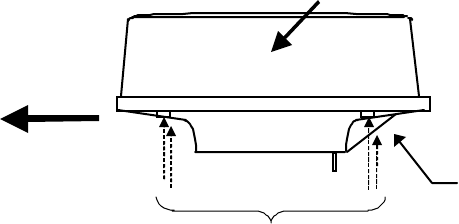
20
$Remove the shield cover located on the astern side. (There are four fixing screws.)
%Remove the cable clamping plate and rubber ring, pass cable through the introduc-
tion opening, put the rubber ring from both ends of it, and clamp the cable to the
scanner unit with screws via the fixing plate. Connect 7-pin connector to X11 and
9-pin connector to X12 of PCB.
&Replace the aluminum cover. At this time, attach a cable shield onto a ditch with
the aluminum cover. However, be careful that the cable will not be caught up be-
tween the main unit and cover.
'Replace the upper part of the radome. Be careful not to bump it against the an-
tenna in the same way as when removing it. Make sure that the cover is fitted in the
correct direction as shown in Fig.3-7-2. The upper and lower parts of the radome
each have four markings indicating screw positions. Align the upper and lower po-
sitions as you mount the radome.
Ship's
heading
Logo seal on
side wall
Fix four screws
Cable inlet
Fig.3-7-2 Fitting cover (RA41C)
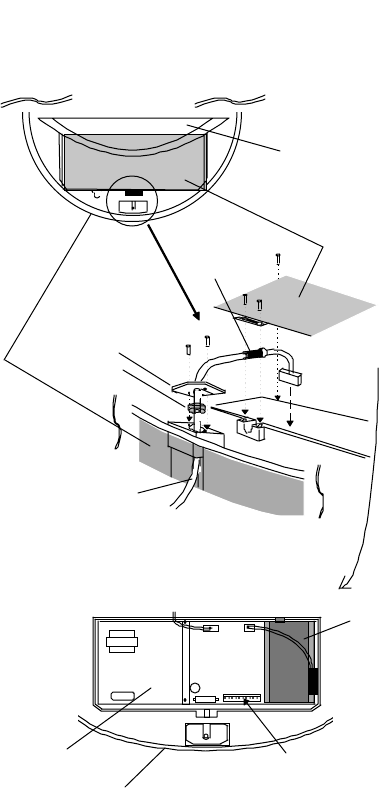
21
A
ntenna
Stern side Shield cover
Cable shield
Radome (bottom)
Fixing plate
Rubber ring
Interconnecting cable
Fix connector on
PCB(X1)
X1 (Connect here)
Radome (bottom)
PCB
Inner shield
Fig.3-8-1 Fitting interconnecting cable (RA40C)
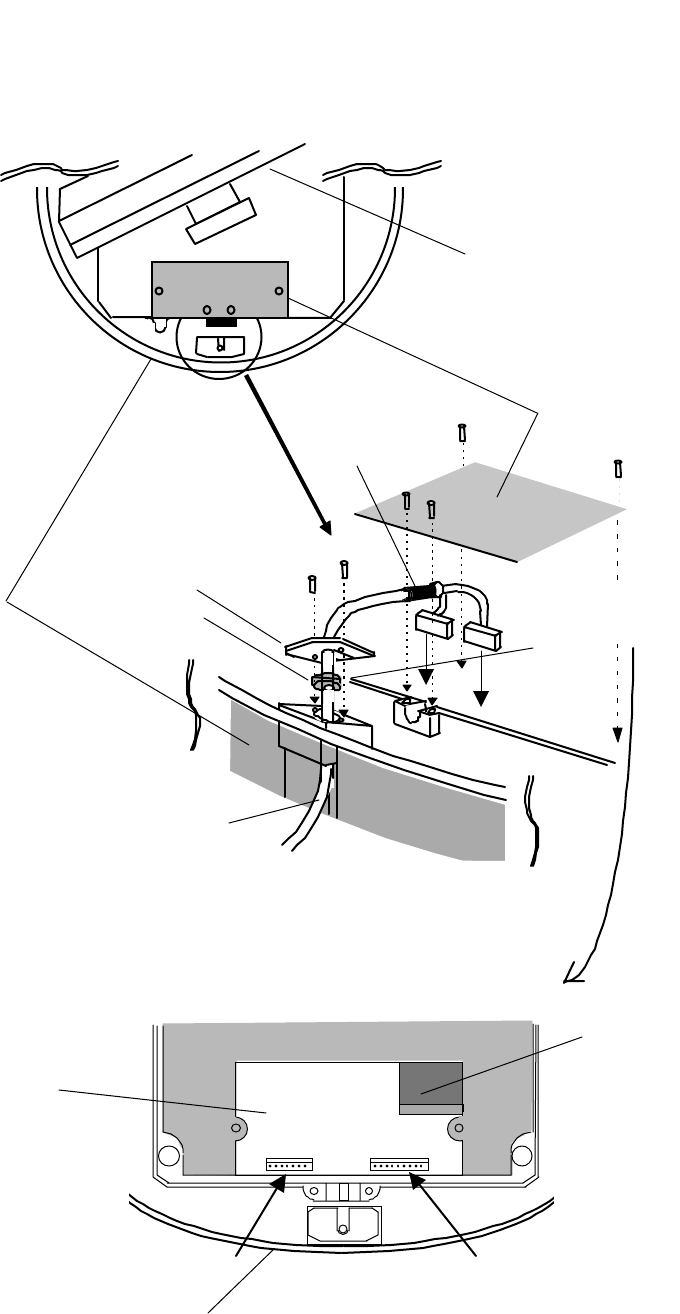
22
Fix connector on
PCB(X11, X12)
Antenna
Stern side Shield cover
Cable shield
Radome (bottom)
Fixing plate
Rubber ring
Interconnecting cable
X12 (Connect here)
Radome (bottom)
PCB
Inner shield
X11 (Connect here)
Fig.3-8-2 Fitting interconnecting cable (RA41C)
23
3.7.2 Interconnecting cable (RA42C Open scanner) (See Fig.3-9)
!Ensure that the radar is off. Connect the cable to the receptacle labeled "SCANNER"
on the rear panel of the display unit.
"Use a T-wrench to remove the back covers of scanner unit.
#Remove the two bolts securing the transceiver; pull out the transceiver after removing
two connectors.(to Motor(X1), to Heading switch (X2))
$Remove the four bolts securing the fixing plate at the cable entrance.
%Remove the metal fixing plate, rubber seal and washer that secure the cable. Pass the
cable through as shown in the diagram below; replace the above items and tighten the
bolts.
&Return the transceiver to its original position and secure it with the removed bolts.
'Connect 7-pin connector to X11 and 9-pin connector to X12 of PCB. And connect two
connector that removed at #.
(Refit the scanner covers.
Take care not to pinch the cable when refitting the cover.
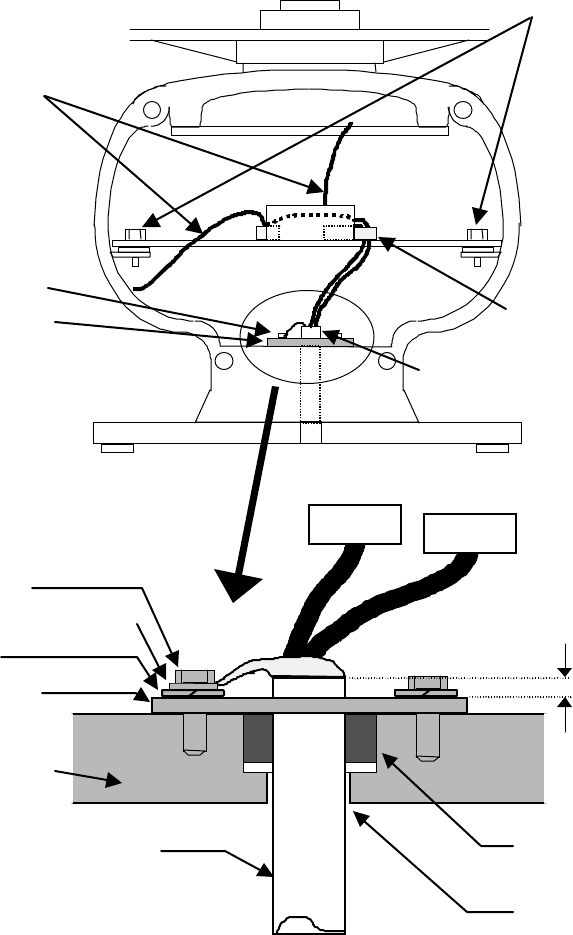
24
TR unit fixing bolts
Remove connector
Fixing bolt
Fixing plate
Inter-connection cable
Clumper
5-10 mm
Fixing bolt
Cable shield terminal
Washer
Fixing plate
Scanner unit
Inter-connection cable Rubber
Cable inlet
Fig.3-9 Fitting interconnecting cable
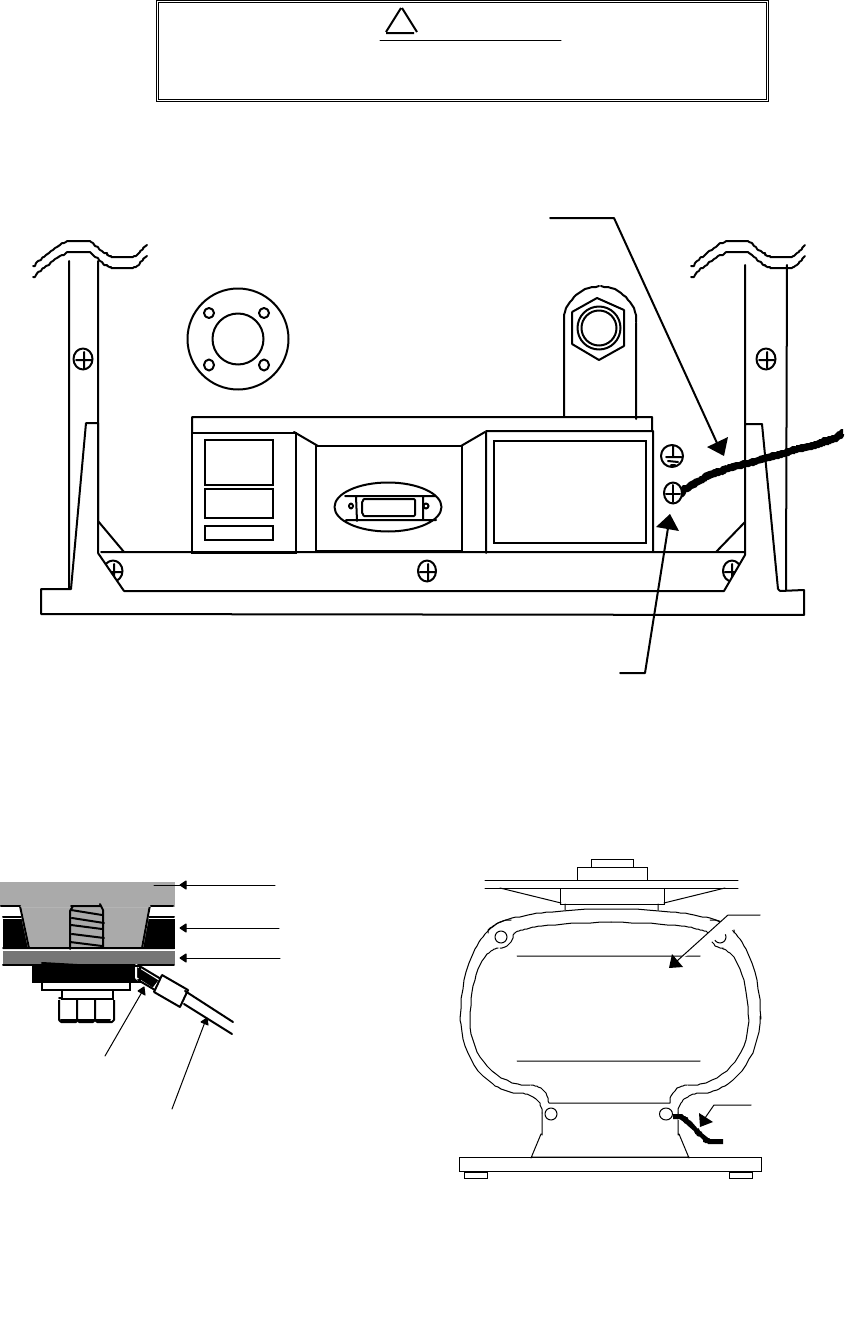
25
3.7.3 Grounding wire
Connect grounding wire before connecting power
supply cable. Leakage current is too high.
Connect grounding wire from the grounding terminal on the rear panel of the display
unit to the ship's hull as shown below.
Connect grounding wire from one of the bolts you have attached when installing the
scanner unit to the ship's hull as shown in Fig.3-11. (The crimp terminal and grounding
wire are not included with the radar equipment.)
SCANNER POWER
OPTION
Grounding terminal
Grounding wire
Fig.3-10 Grounding display unit to earth
Mount base
Radome
(
bottom
Chassis
→
→→
→
To shi
p
's hull
Crim
p
terminal
Grounding wire
Radome scanner
Groundin
g
wire
→
→→
→To shi
p
’s hull
Scanner cover
O
p
en scanner
!WARNING
Fig.3-11 Grounding scanner unit to earth
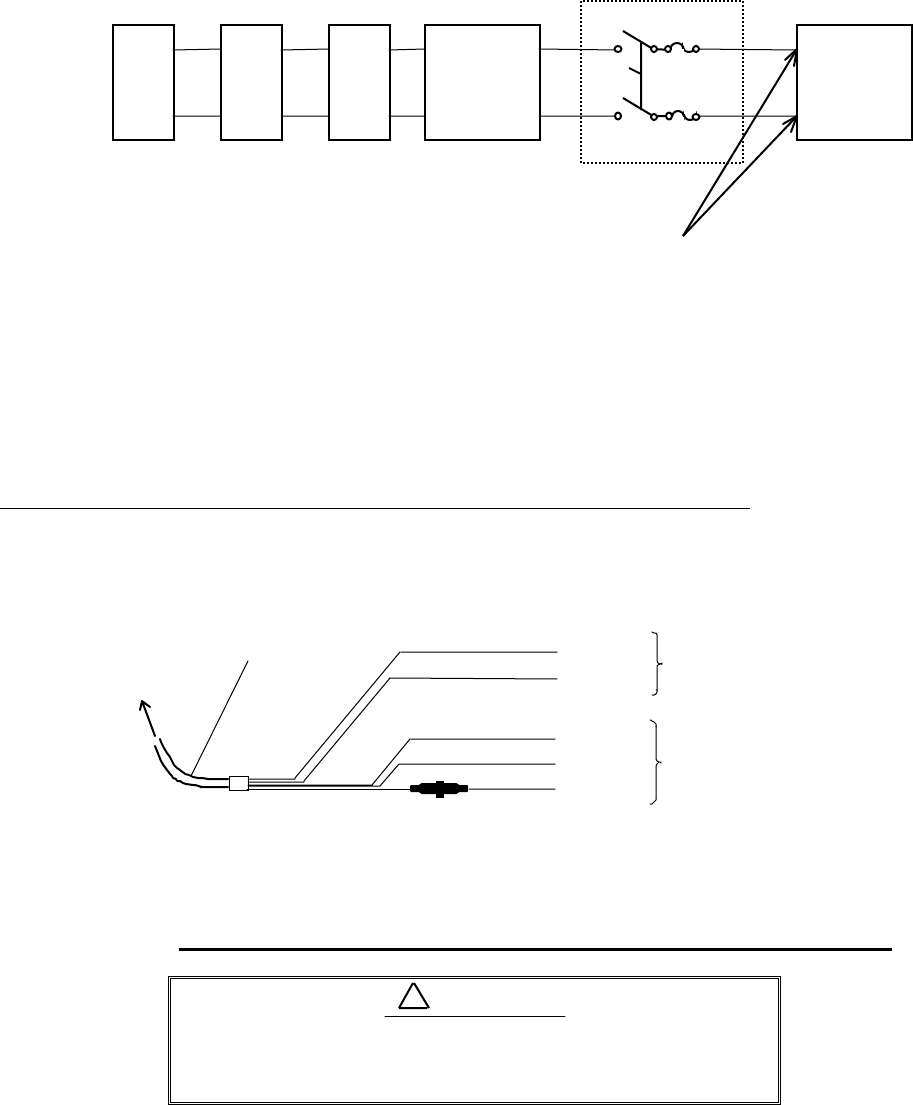
26
3.7.4 Power supply cable
Power is fed through a knife switch ( or circuit breaker) and protective fuses, as shown
in below.
WARNING: Do not apply over 41.6V to Radar
or Radar may be broken.
Fit the power supply cable (included with your radar) to the receptacle labeled "POWER"
on the rear panel of the display unit. And connect to power supply as followings. (When you
do not connect external equipment, put tape on red and green wire.)
Place the Fuse and connection part where there is no water splash and dry area.
When extend the power supply cable, use a suitable cable as below.
Ship's Power Voltage Cable conductor Cable max. length
cross section
12Vdc 3.5 mm23 m
6.0 mm25 m
24Vdc 2.0 mm26 m
3.5 mm210 m
3.8 Adjustment
Be sure to operate the following adjustment. If this
is not adjusted properly, the radar picture does not
display true image.
When you have finished installing the scanner and display units and connecting cables,
turn on the power to the display and scanner units and check to see if they operate nor-
mally without problem. Then make adjustments as detailed below and check to see if the
units operate normally again.
White
Black
Gray
Green
Red
Power supply cable
To dis
p
la
y
unit
DC+
DC-
Ground
NMEA-
NMEA+ To external
equipment
To power supply
Fig.3-12 Power supply cable
!CAUTION
Generator Switchboard Charger Storage
Battery
12/24V
Main switch panel
(Knife Switch with
Fses)
Radar Display
Unit
DC voltage
reference points
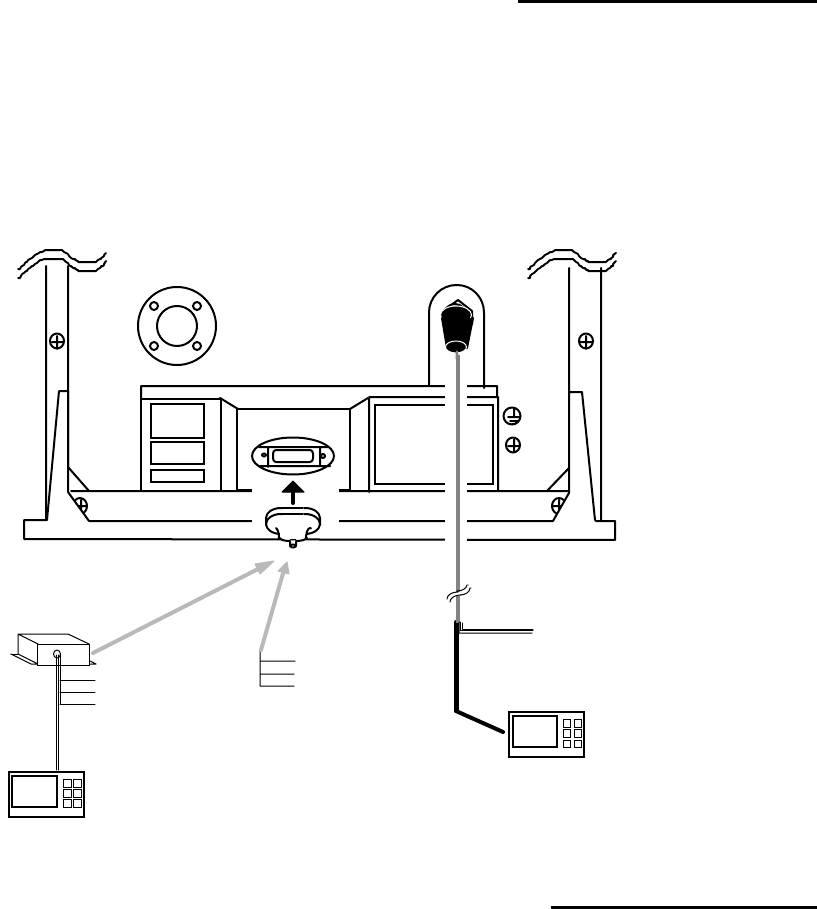
27
! TUNING Refer to Adjusting tuning circuit in 5.5.4.5.4
" HEADING DIRECTION Refer to Adjusting angle in 5.5.4.5.4
# DISTANCE Refer to Adjusting distance in 5.5.4.5.4
3.9 Connecting External Equipment to Display Unit
The display unit has two channels of NMEA input. One is standard in power cable. The
other is necessary to connect optional parts (Junction box with OPTION cable).
OPTION connector is located at display’s rear panel for connecting external equipment
such as a GPS, LORAN, or gyro compass. You must have an Junction box with OPTION ca-
ble. (Refer to CHAPTER 8 (4) External interface.)
Note: SIN/COS and MOB signals cannot be used on Junction Box.
Junction box with OPTION cable (Order No. RZ704A)
3.10 Countermeasure for Electromagnetic Interference
RA40C/41C/42C radar provides shields in the units and the inter-unit connection ca-
ble. When the radar, however, is closely installed to radio equipment such as VHF trans-
ceiver, UHF transceiver, etc., or the radar and/or radio equipment are not sufficiently
grounded to the hull or ship's earth, the radar may happen to cause EMI trouble.
Followings are general procedures for reducing EMI due to radars. When installing ra-
dars, refer to them, and also check the radio equipment EMI trouble with operating the ra-
dar and radio equipment.
SCANNER PO WER
OPTION
OPTION cableJunction box*note
POWER cable
External NMEA equipment
External NMEA equipment
Green :NMEA-
Red :NMEA+
To power supply
Other radar,
slave monitor,
External buzzer,
Gyro I/F
Other radar,
slave monitor,
External buzzer,
Gyro I/F,
SIN/COS.
MOB(NMEA out)
Fig.3-13 Connecting external equipment to display unit
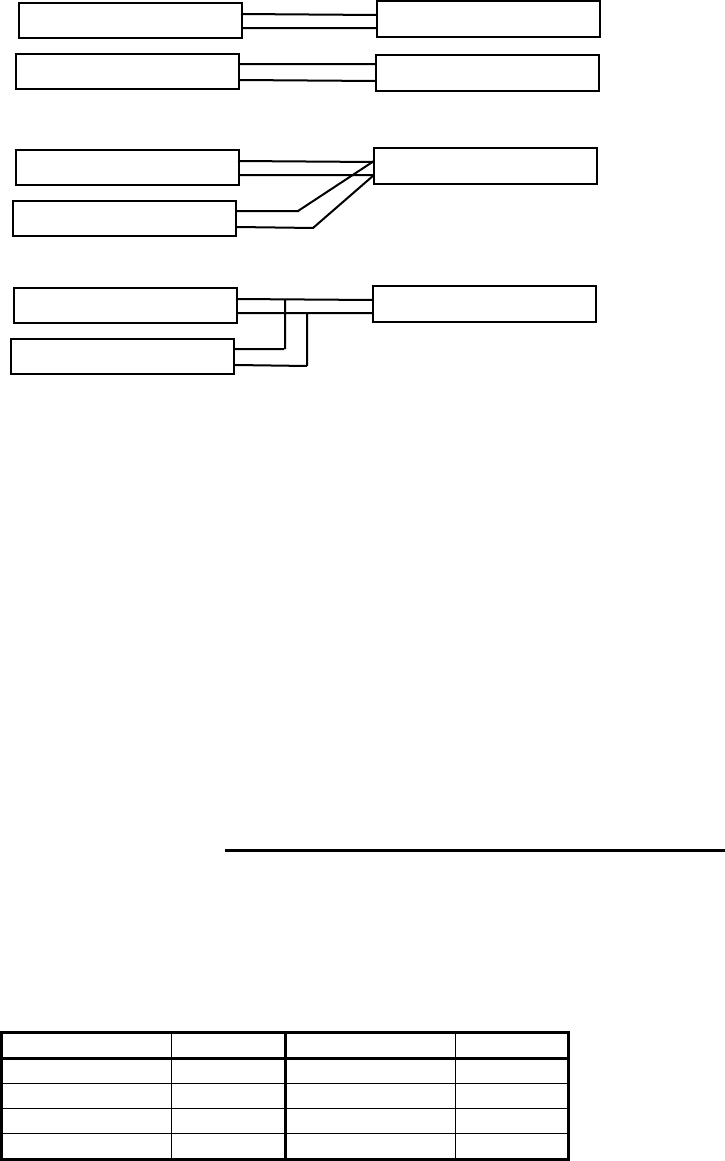
28
(1) Installation Place of Radar
The display unit, scanner unit and inter-unit connection cable should be located
apart from the main unit, feeder, antenna coupler and antenna of radio equipment as
far as possible.
Especially, proper installation of the feeder, antenna coupler and antenna of radio
equipment is very important to improve EMI trouble.
(2) Laying Power Supply Cables
Following connections A and B are recommended to reduce conduction noise gener-
ated from radar. Connection C should not be used.
Connection A
(Very Good)
Connection B
(Good)
Connection C
(Bad)
(3) Grounding
All equipment should be firmly grounded at the earth nearest hull with copper plates
or braided wires.
Improvement Procedure for EMI
(1) Confirm grounding on the radar and radio equipment. However, some equipment, on
which grounding is not always necessarily, have a possibility of EMI improving when
taking off their grounding. Try to take off grounding.
(2) Confirm power supply cable connections and modify to the connection A or B above.
(3) Try to shift the display unit and inter-unit connection cable of radar to be apart from
radio equipment.
(4) Try to shift the feeder of radio equipment to be apart from each units and the inter-
unit connection cable of radar.
(5) Try to shift the antenna coupler and antenna of radio equipment to be apart from
the scanner unit and inter-unit connection cable of radar.
3.11 When Discarding Your Radar
When discarding your RA40C/41C/42C radar, consult the distributor to get informa-
tion on precautions to be followed. Tab.3-7 below lists the primary component materials of
the RA40C/41C/42C radar for your reference.
Tab.3-7 Component Materials
Scanner unit Material Display unit Material
Radome AES Front panel ABS
Chassis A5052P Rear panel ADC12
Base ADC12 Pedestal ABS+PC
Antenna A5052P
RADAR
RADIO EQUIPMENT
SHIP'S SUPPLY
SHIP'S SUPPLY
RADAR
RADIO EQUIPMENT
SHIP'S SUPPLY
RADAR
RADIO EQUIPMENT
SHIP'S SUPPLY
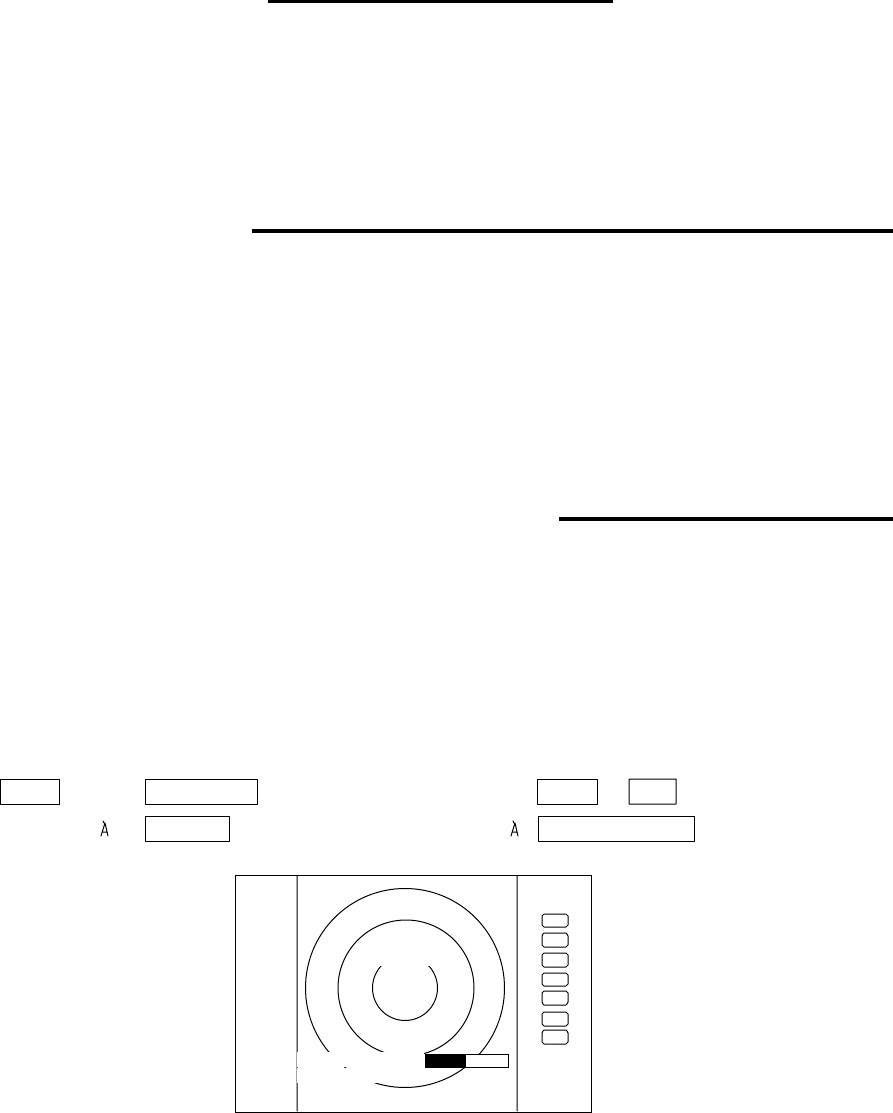
29
CHAPTER 5. OPERATION
Basic operation of radar
The RA40C/41C/42C radar has several fixed-function keys on the front panel. These
functions can be controlled by simply pressing the key. Also, special functions can be
customized to soft-keys by user-setting. The followings explain the operation of each keys.
5.1 Powering On and Off
(1) Powering On
Press the "POWER" key. Buzzer sounds "pi" and starts the radar system.
Screen brilliance is set to the level that of the radar system has been powered off.
(2) Powering off
Keep pressing the "POWER" key more than 3 seconds, then the radar system will
power off.
5.2 Adjusting brilliance of screen and key-backlight
(1) Press the "BRILL" key. (Bar and figure indicating brilliance, and figure indicating key-
backlight appear on the screen.)
(2) Adjust each items with the control knob. Items can be selected by up-down cursor.
(3) When the adjustment is finished, press either the "BRILL" key or the "ENT" key to exit
from the adjustment screen. (Pressing some other key after adjustment will lead to the
function of the pressed key.)
BRILL -→Control knob (Adjustment of brilliance) ----→ BRILL or ENT
→Up/Down (Selection of brilliance, key-backlight) →Other function key Move to other functions
.75
.25
HU
BRILLIANCE 50
ST’BY
+
KEY BACKLIGHT 4
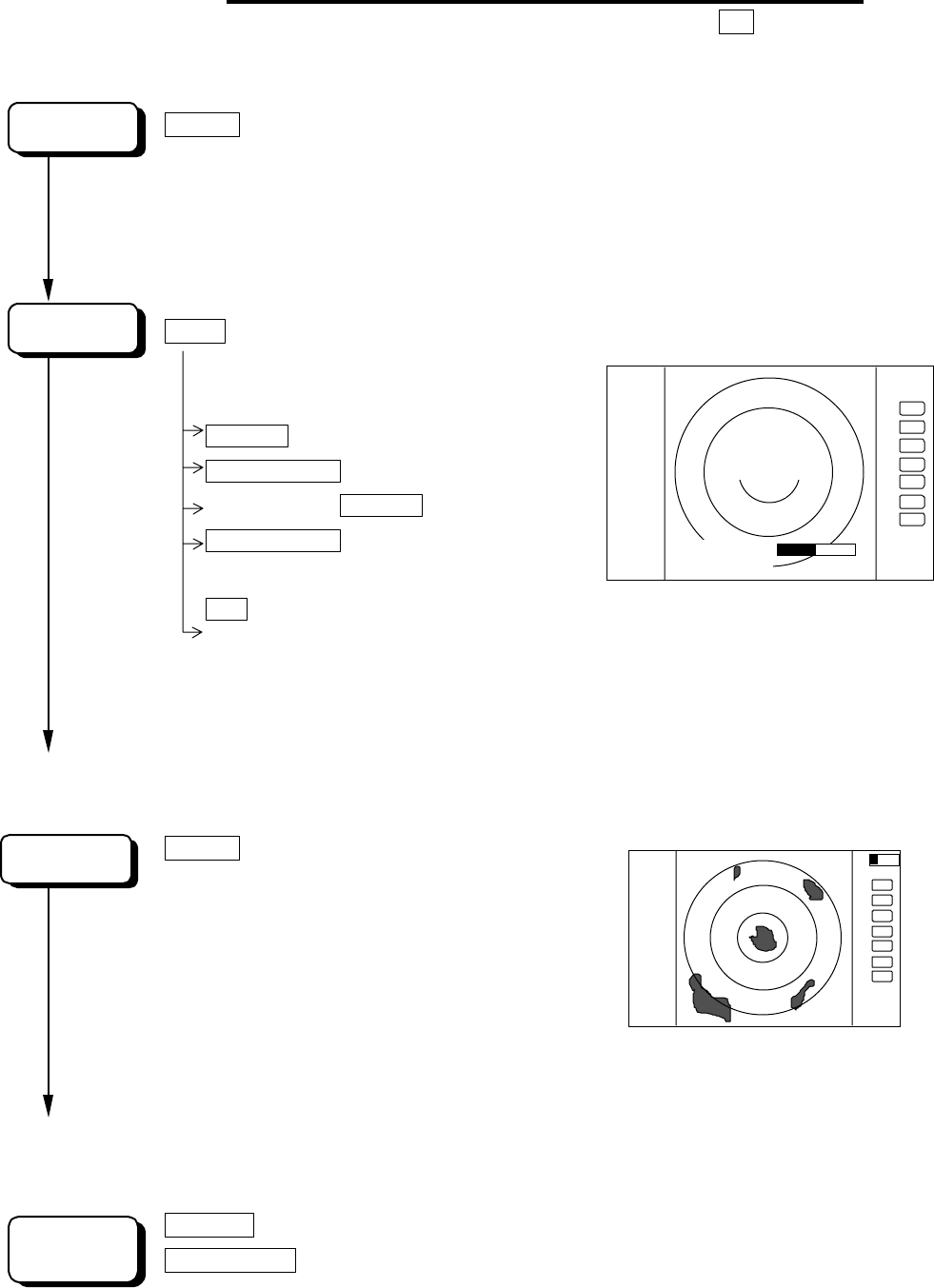
30
5.3 Basic Operations
xxx = keys to press
5.3.1 Powering On and Off
POWER Press "POWER"key to power on.
2 minutes timer and "RADAR OFF" are displayed.
Keep pressing "POWER" key to power off.
Press the "BRIL" key.
BRILL Control bar is indicated on the screen.
brilliance Up/Down Select brilliance.
Control knob Adjust brilliance with knob.
key backlight Up/Down Select key backlight.
Control knob Adjust key backlight with
knob.
ENT Press "ENT"key to return.
Radar turns into "ST'BY"mode when 2 minutes timer is finished and
"ST'BY" is displayed.
5.3.2 Transmitting
POWER Press "POWER" key to
operate, radar picture
appears on the screen.
Another press "POWER" key,
radar turns to stand-by
mode.
Keep pressing "POWER" key more than 3 seconds, radar
turns to power off.
RANG UP or Pressing "RANGE UP" key produces a long-distance range,
RANGE DOWN "RANGE DOWN" key a short-distance range.
.75
.25
HU
BRILLIANCE 50
1:58
RADAR OFF
+
KEY BACK L IGHT 4
AT
D‚V‚T
D‚Q‚T
‚g‚t
+
SCREEN
POWER ON
START
CHANGE
RANGE
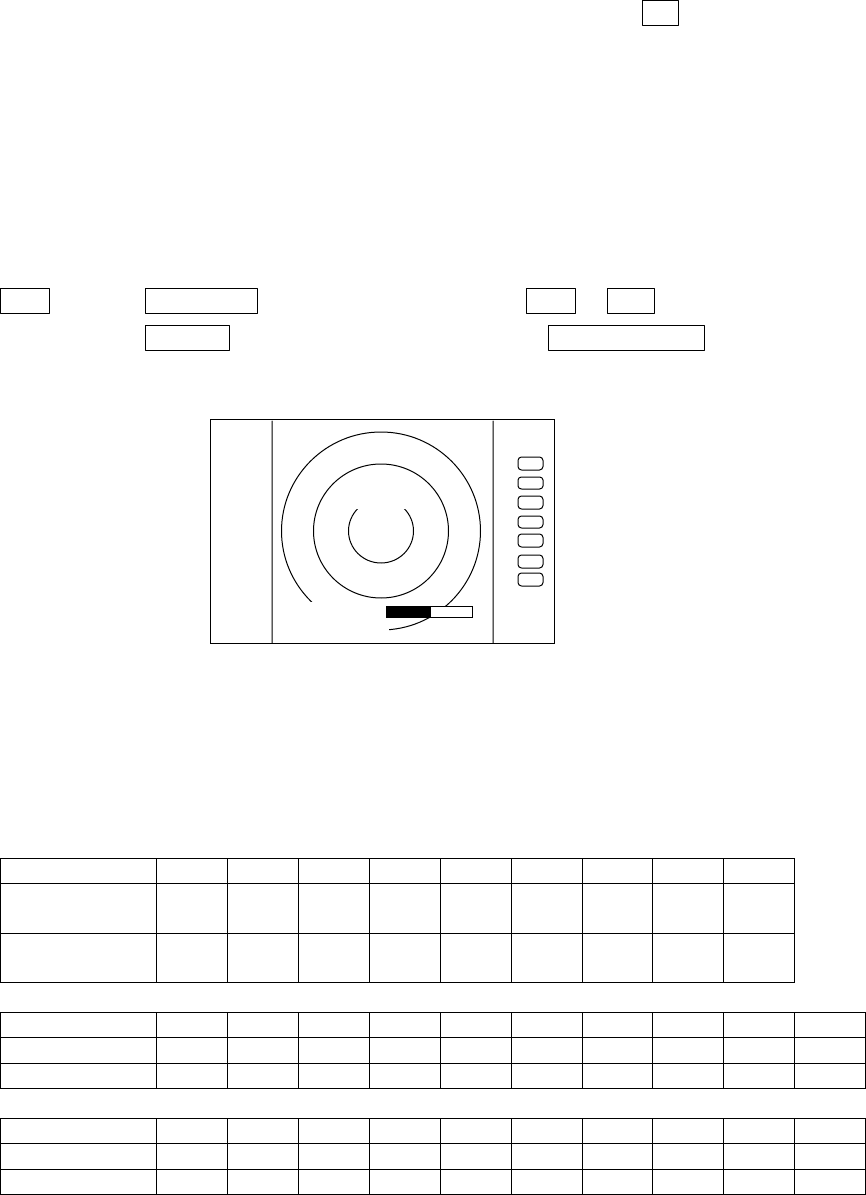
31
5.3.3 Adjusting brilliance of screen and key-backlight
xxx = keys to press
(1) Press the "BRILL" key. (Bar and figure indicating brightness, and figure indicating back-
light appears on the screen.)
(2) Select brilliance or key-backlight with the up-down cursor.
(3) Adjust each item with the control knob.
(4) When the adjustment is finished, press either the "BRILL" key or the "ENT" key to exit
from the adjustment screen. (Pressing some other key after adjustment will lead to the
function of the pressed key.)
BRIL → Control knob (Adjustment of brilliance) → BRIL or ENT
→ Up/Down (Adjustment of brightness, panel) → Other function key Shift to other functions
5.3.4 Changing Distance Range (RANGE UP, RANGE DOWN)
Pressing "RANGE UP" key produces a long-distance range, and "RANGE DOWN" key a
short-distance range.
••RADOME SCANNER (RA40C)
RANGE 0.125 •0.25 0.5 0.75 1.5 3 6 12 24
Number of
rings
222366666
Range ring
interval
0.062
5
0.125 0.25 0.25 0.25 0.5 1 2 4
RADOME SCANNER (RA41C)
RANGE 0.125 0.25 0.5 0.75 1.5 3 6 12 24 36
Number of rings2223666666
Range ring interval 0.0625 0.125 0.25 0.25 0.25 0.5 1 2 4 6
OPEN SCANNER (RA42C)
RANGE 0.125 0.25 0.5 0.75 1.5 3 6 12 24 48
Number of rings2223666666
Range ring interval 0.0625 0.125 0.25 0.25 0.25 0.5 1 2 4 8
5.3.5 Automatic adjustment (AUTO)
AUTO adjusts the GAIN, STC and FTC automatically.
If the "AUTO" key is pressed while GAIN, STC, or FTC are under manual settings, they
will all be switched to AUTO or HBR(Harbor) mode.
Pressing "AUTO" key, AT1, AT2 and HBR changes in turn. Pressing STC key, all
. 75
. 25
HU
BRILLIAMCE 50
ST’BY
+
KEY BACKLIGNT 4
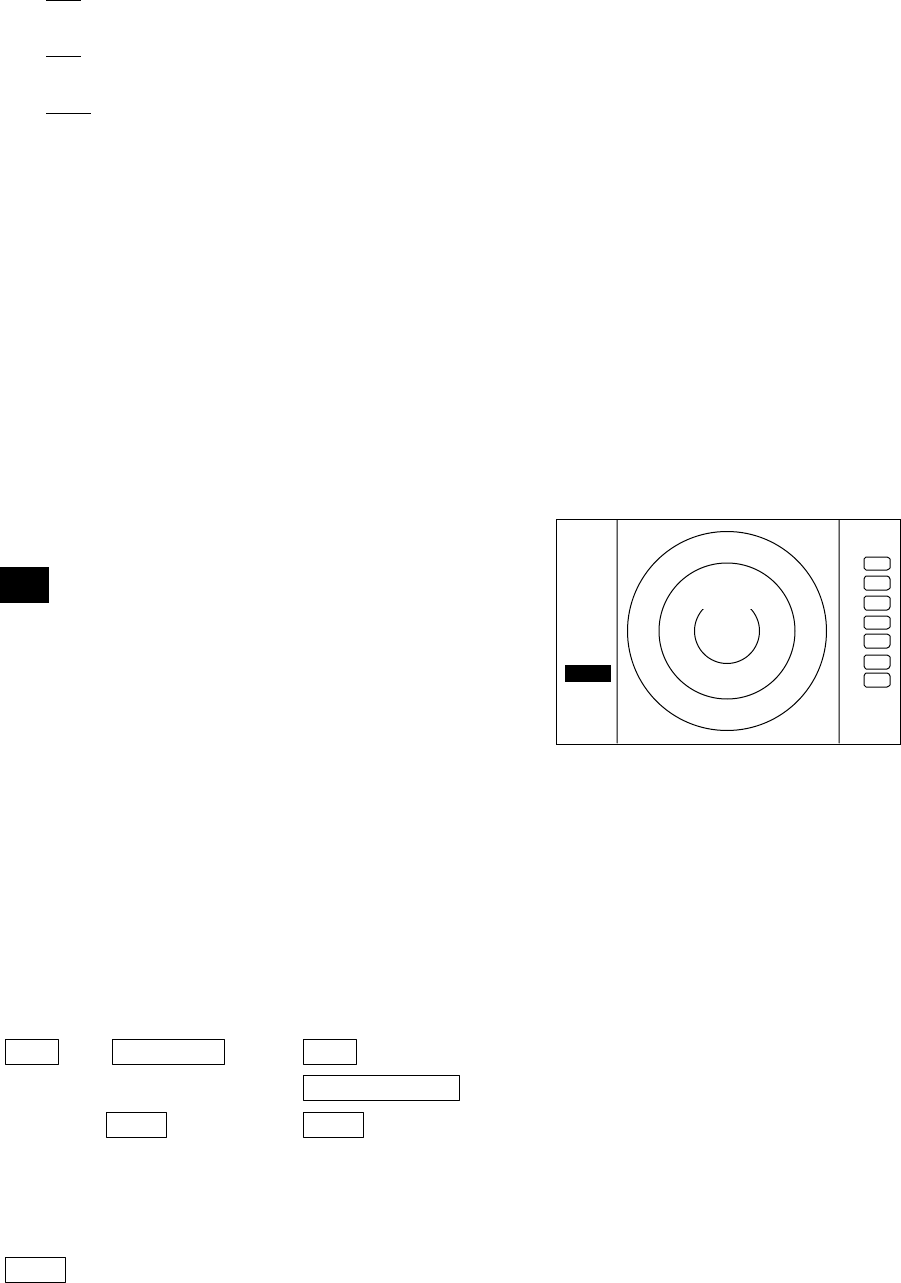
32
controls return to manual state.
AT1 Use when find navigation way in much echo such as port area, narrow channel,
small islands area. The control condition is similar to slightly down GAIN.
AT2 Use at open sea to suppress the sea clutter. The control condition is similar to
high GAIN.
HBR Use at in a bay area, inlet, or a harbor. The control condition becomes manual
STC by
using the value established HARBOR of ADJUST menu.
Note) Refer to "Setting STC circuit(STC)" in section 5.5.4.5.4(6).
Note) When you select HBR mode, FTC will be switched to MANU mode.
* What happens if GAIN, STC, and FTC keys are pressed during AUTO operation?
1) If GAIN key is pressed, Only GAIN enters a manual state.
2) If FTC key is pressed, Only FTC enters manual state.
3) If STC key is pressed, STC, GAIN, and FTC enter manual state.
5.3.6 Sensitivity adjustment (GAIN)
(1) When the "GAIN" key is pressed, the GAIN
display on the left side of the screen will be
reversed as
G 35 and the adjustable state will be entered.
(2) When the control knob is turned, the figure will
be shifted within a range of 0 and 99, and the
sensitivity can be manually adjusted. When
the "AUTO" key is pressed, all (GAIN, STC and
FTC) will enter an AUTO state.
(3) After the adjustment is finished, press the
"GAIN" key to exit from the adjustment state. If
some other function key is pressed, shift to
that function will take place.
(a) To make adjustments by MANUAL (When the GAIN key is pressed under AUTO operation,
shift to a manual operation will take place.)
GAIN → Control knob → GAIN -------------------------The adjustment state is ended.
µθ
>Other function key •------Shift to other functions
µθ>AUTO µθ>AUTO ------------------------GAIN, STC, and FTC are set at AUTO and the
adjustment state is ended.
(b) To switch from the MANUAL state
AUTO -------------------------------------------------------------------------Set GAIN, STC and FTC at AUTO
5.3.7 Removing sea clutter (STC)
. 75
.25
HU
G 50
ST’BY
+
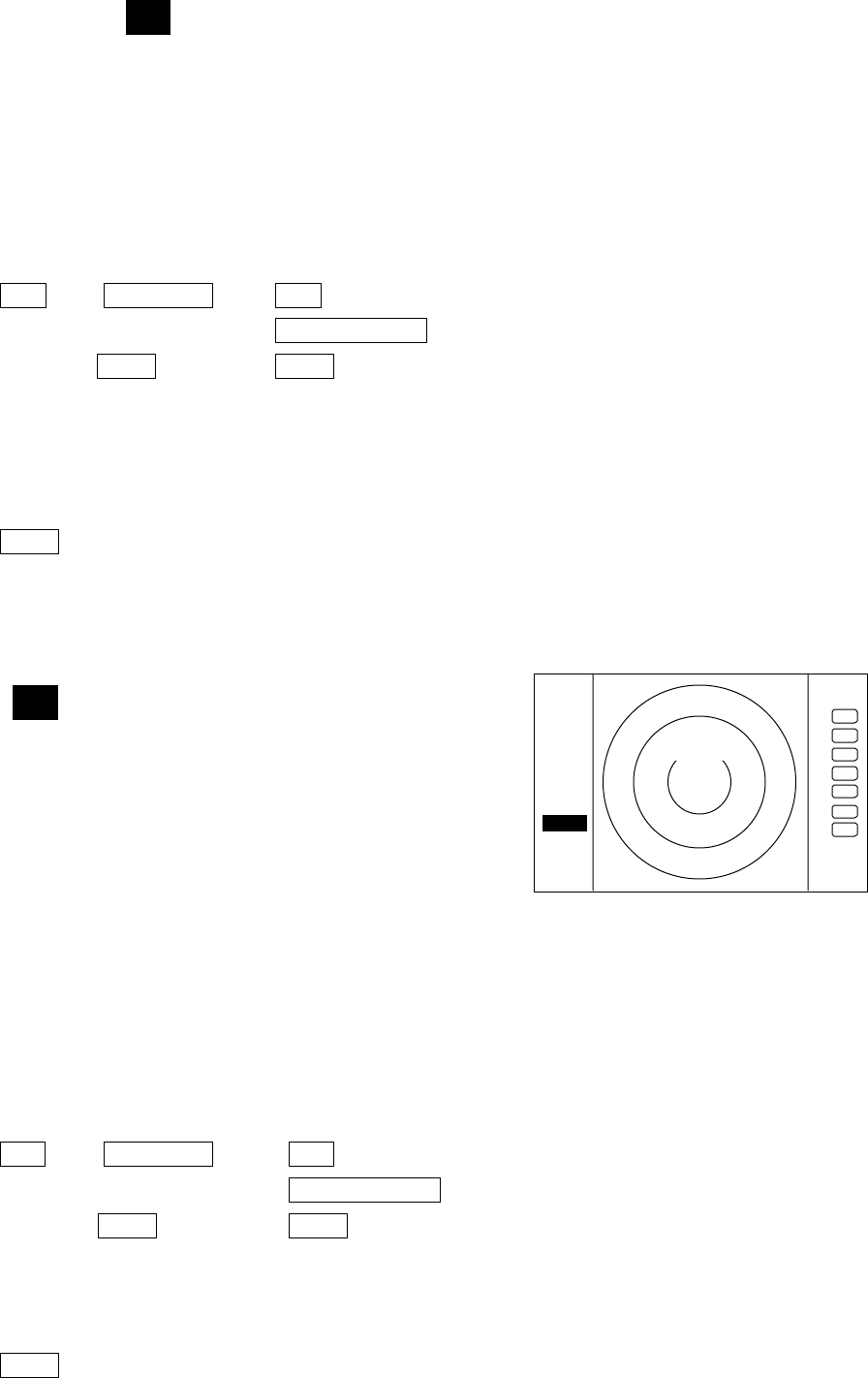
33
(1) When the "STC" key is pressed, the STC display on the left side of the screen will be
reversed as S 35 and the adjustable state will be entered.
(2) When the control knob is turned, the figure will be shifted within a range of 0 and 99,
and the STC can be manually adjusted. When the "AUTO" key is pressed, all (GAIN,
STC and FTC) will enter an AUTO state.
(3) After the adjustment is finished, press the "STC" key to exit from the adjustment state.
If some other function key is pressed, shift to that function will take place.
(a) To make adjustments by MANUAL (When the STC key is pressed under AUTO operation,
shift to a manual operation will take place.)
STC → Control knob → STC ----------------------------The adjustment state is ended.
→Other function key •--------Shift to other functions
→ AUTO → AUTO --------------------------STC, GAIN, and FTC are set at AUTO and the
adjustment state is ended.
NOTE) When you select MANU mode, GAIN and FTC will be switched to MANU mode, too.
(b) To switch from the MANUAL state
AUTO -------------------------------------------------------------------------Set STC, GAIN and FTC at AUTO
5.3.8 Removing rain and snow clutter (FTC)
(1) When the "FTC" key is pressed, the FTC display
on the left side of the screen will be reversed as
F 500 and the adjustable state will be entered.
(2) When the control knob is turned, the figure will
be shifted within a range of 0 and 99, and the
sensitivity can be manually adjusted. When
the "AUTO" key is pressed, all (GAIN, STC and
FTC) will enter an AUTO state.
(3) After the adjustment is finished, press the
"FTC" key to exit from the adjustment state. If
some other function key is pressed, shift to
that function will take place.
(a) To make adjustments by MANUAL (When the FTC key is pressed under AUTO operation,
shift to a manual operation will take place.)
FTC → Control knob → FTC -------------------------The adjustment state is ended.
µθ
>Other function key -------Shift to other functions
µθ>AUTO µθ>AUTO ------------------------GAIN, STC, and FTC are set at AUTO and the
adjustment state is ended.
(b) To switch from the MANUAL state
AUTO -------------------------------------------------------------------------Set GAIN, STC and FTC at AUTO
. 75
.25
HU
F 50
ST’BY
+
34
5.3.9 Man Over Board (MOB)
Pressing the MOB key will send the own ship's position data to the external equipment
through NMEA port with "WPL" format. There is no change on the screen.
To check the MOB position data, select "MOB" from the "WINDOW" menu in the "SETUP".
The position of MOB and current position will be displayed on the screen. If press the "MOB"
key while watching the MOB screen, MOB data will be cleared and return to previous screen.
If press other keys, MOB data will be remained and return to previous screen.

35
5.4 Functions of Soft Keys
xxx •keys to press
•Outline of soft keys
Any function can be optionally allocated to the key upon which numbers 1-7 are indicated. A
maximum of 4 groups of functions can be allocated to each soft key, and switching between
those functions is conducted by the "NEXT" key.
5.4.1 Bearing measurement (EBL1)
(a) Bearing measurement by EBL1
(1) When "EBL1" key is pressed, electric bearing line (EBL1) appears and the angle from the
direction of the ship’s head which is set at 0 °will appear in a reverse display at the lower left
of the screen(Note).
(2) Use the control knob to place the direction cursor on the target, and read the angle.
(3) After the setting
i) If "EBL1" key is pressed, the setting is completed.
ii) If "other function" key is pressed, the function will be shifted to that of the pressed key
with the setting condition still in effect.
note: 1 xxx.x φ indicates EBL1.
EBL1 → Control knob → EBL1 EBL1 is displayed and the process is finished.
µθ>Other function key EBL1 is displayed and the function is shifted.
µθ>EBL1 EBL1 is turned off.(b)
(b) To turn off the EBL1
When the "EBL1" key is pressed twice, EBL1 disappears. (EBL1 OFF)
Note: Refer to "5.5.1.1 Bearing measurement (EBL1)".
5.4.2 Bearing measurement (EBL2)
The operation is the same as EBL1. Refer to the EBL1 operation. The "EBL2" will appear
in a reverse display at the lower right of the screen
5.4.3 Distance measurement (VRM1)
(a) Distance measurement by VRM1
(1) When "VRM1" key is pressed, variable range marker (VRM1) appears and the distance in
a reverse display appears at the lower left of the screen.
(2) Place the marker on the front edge of the target with the control knob and read the
distance.
(3) After the setting
i) If "VRM1" key is pressed, the setting is completed.
ii) If "other function" key is pressed, the function will be shifted to that of the pressed key
with the setting condition still in effect.
note: 1 xxx.x NM indicates VRM1.

36
VRM1 → Control knob → VRM1 VRM1 is displayed and the process is finished.
µθ>Other function key VRM1 is displayed and the function is shifted.
µθ>VRM1 VRM1 is turned off.(b)
(b) To turn off the VRM1
When the "VRM1" key is pressed twice, VRM1 disappears. (VRM1 OFF)
Note: Refer to "5.5.1.2 Determining the distance (VRM1)".
5.4.4 Distance measurement (VRM2)
The operation is the same as VRM1, refer to VRM1 operation. The "VRM2" will appear in
a reverse display at the lower right of the screen
5.4.5 Measuring the angle between two points (FL EBL2)
Note: VRM2 and EBL2 do not follow the OFF-C function while floating.
Note: Refer to "5.5.1.5 Measuring the distance or angle between two points ( FL EBL2, FL
VRM2 )".
(a) Setting a reference point for measurement of the angle.
(1) Press "FL EBL2" key. “SET START POINT” is displayed and a small cross mark appears.
FL EBL2 → FL EBL2 is turned ON and
(Select FL EBL2) the small cross mark appears.
(2) Use the left-right and up-down cursor keys to place the small cross mark on one of the
two echoes whose angle will be measured, and press the "ENT" key.
Up/Down & Left/Right → ------ ENT Criterion of the reference point is set.
(Place the cross cursor on an echo)
(b). Measuring
Perform the operations in the above mentioned and "measuring the angle(EBL2)", and
place the EBL2 on another echo.
EBL2 is displayed on the screen based on the placed fixed cross cursor.
" 2 xxx.x°" which is displayed at the lower right will be the angle between the two
points.
5.4.6 Measuring the distance between two points (FL VRM2)
Note: Refer to "5.5.1.5 Measuring the distance or angle between two points ( FL EBL2, FL
VRM2 )".
(a) Setting a reference point for measurement of the angle.
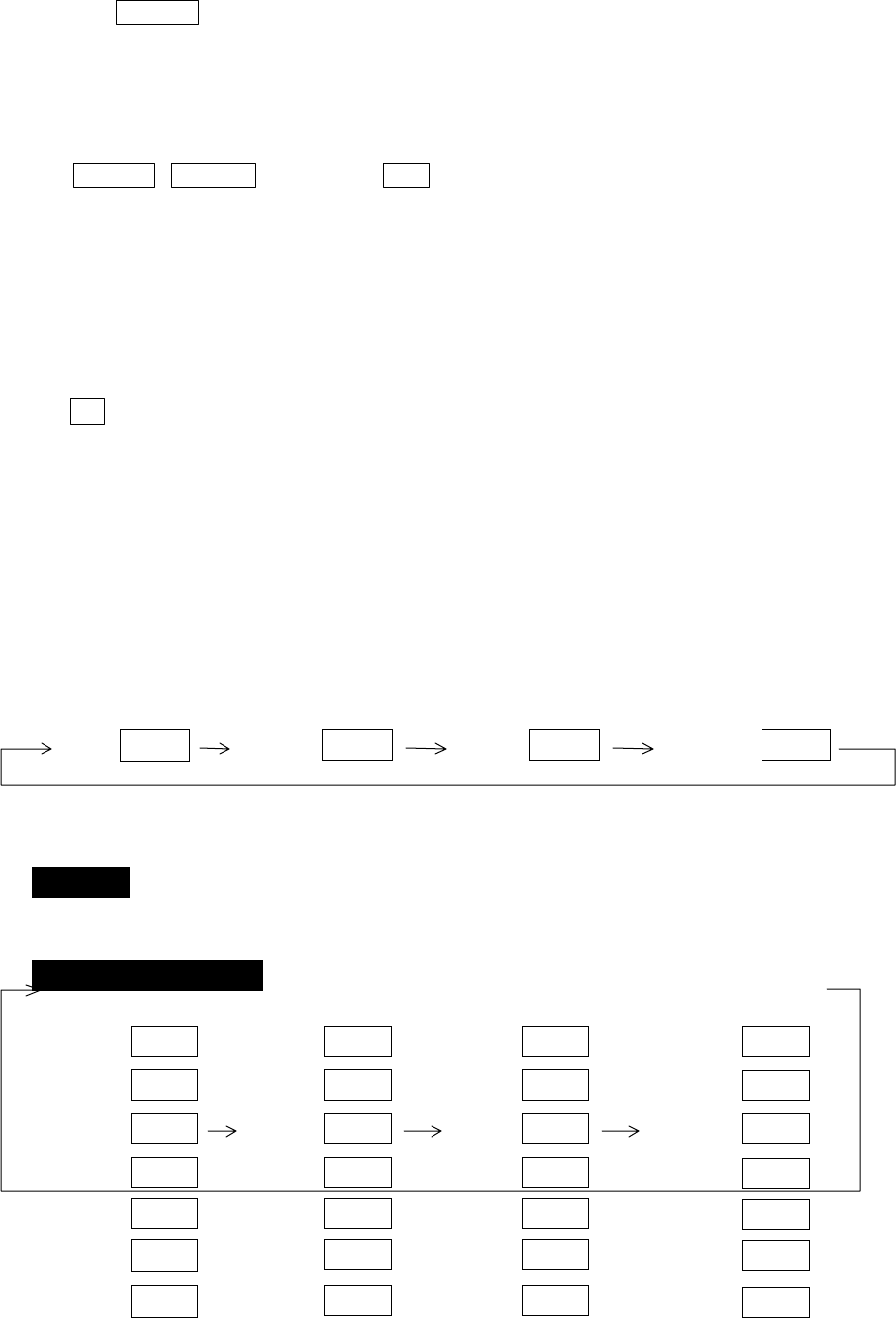
37
(1) Press "FL VRM2" key. “SET START POINT” is displayed and a small cross mark appears.
FL VRM2 → FL VRM2 is turned ON and
(Select FL VRM2) the small cross mark appears.
(2) Use the left-right and up-down cursor keys to place the small cross mark on one of the
two echoes whose angle will be measured, and press the "ENT" key.
Up/Down & Left/Right → ------ ENT Criterion of the reference point is set.
(Place the cross cursor on an echo)
(b) Measuring
Perform the operations in the above mentioned and "measuring the distance(VRM2)", and
place the VRM2 on another echo.
VRM2 is displayed on the screen based on the placed fixed cross cursor.
" 2 xx. xNM" which is displayed at the lower right will be the distance between the two
points.
5.4.7 Changing the group of Soft Keys (NEXT)
Any function can be optionally allocated to the key upon which numbers 1-7 are indicated.
A maximum of 4 groups of functions can be allocated to each soft key, and switching between
those functions is conducted by the "NEXT" key.
The "NEXT" key switches between allocated function groups on the soft key which numbers
1-7 are indicated.
Εϖερψ τιµε πρεσσινγ τηε ∀ΝΕΞΤ∀ κεψ, function groups changes to another groups included
pressing "NEXT" key. The function groups can also be changed at the "KEY ASSIGNMENT"
function in the "CUSTOM" menu of the "SETUP" with left-right cursor key.
Operation_
_Soft Key Setting Example_
SET1 SET2 SET3 SET4
7 7 7NEXT NEXT NEXT 7NEXT
1
3
4
5
2
1
3
4
5
2
1
3
4
5
2
6 6 6
EBL1
VAR RNG
TRACK
TARGE
VRM1
EBL2
FL EBL2
FL
GZ
VRM2
RINGS
ST
ZOOM
SLEEP
TUNE
SEL WIN OFF-C PICTURE
7 7 7
NEXT NEXT NEXT
1
3
4
5
2
6
PPI
PPI/PP
PPI/NAV
ALL
PPI/3D
ALL
7NEXT
38
The function can be changed at the "KEY ASSIGNMENT" function in the
"CUSTOM" menu of the "SETUP".

39
5.4.8 Erasing heading maker temporarily (HDG OFF)
Press the “HDG OFF” key. The heading marker is not displayed as long as you hold it down.
5.4.9 Using parallel cursors (///CSR)
Press the “///CSR” key. Parallel cursors will appear on the screen. As you move EBL, the
parallel cursors also move.
To cancel the "///CSR" function, press "///CSR" key once more.
Note: Refer to "5.5.1.8 Using parallel cursors (///CSR)".
5.4.10 Establishment of the indication of the RANGE RINGS (RINGS)
Press the “RINGS” key. Range Rings will appear on the screen. To cancel the "RINGS"
function, press "RINGS" key once more.
Note: Refer to "5.5.1.9 Establishment of the indication of the RANGE RINGS (RINGS)".
5.4.11 ON/OFF of variable range function (VAR RNG)
Usually the range changes in steps as 0.5--0.75--1.5--3.0--....., but using this function will
enable a consecutive change such as 0.5--0.6--0.7--0.8--..... .
Press the “VAR RNG” key. The VAR RNG function becomes valid and VAR will be displayed
at the upper left of the screen (beside MODE). To cancel the "VAR RNG" function, press "VAR
RNG" key once more.
The range changes continuously with the up-down cursor while the VAR RNG function is
on, and it changes in steps with the "RANGE UP" or "RANGE DOWN" keys.
If pressing other keys, return to the normal state from continuously range change state.
5.4.12 Changing display modes (MODE)
(1) Select MODE from the pull-down display items using the up-down cursor keys, and press
the "ENT" key.
(2) When the HU/HS/NU/CU/TM sign is displayed beside the MODE item, select display mode
with the up-down cursor keys and press the "ENT" key.
(3) The setting will be completed when the "ENT" key is pressed after the selection. (NOTE1,2)
Press the "MODE" key, the display mode will change on every pressing to HU, HS, NU, CU,
TM in order. The mode select at the upper of the screen is indicated. However, a setting will be
needed for the ship’s speed if TM is selected. Also, a heading or a course information is
necessary for NU, CU and TM.
νοτε: ΤΜ ισ ϖαλιδ ονλψ ον ΠΠΙ σχρεεν. Τηε µοδε ωιλλ χηανγε το ΝΥ ον τηε οτηερ σχρεεν
αυτοµατιχαλλψ.
Note: Refer to "5.5.2.1 Changing display mode (MODE)".
5.4.13 Guard Zone (GZ)

40
A function that sets a guard zone of any distance and any angle range, creating alarm tone
when either echoes above a certain level exist (IN MODE) or no echoes exist(OUT MODE).
When GZ is operated with soft keys, guard zone settings and ON/OFF settings can be
conducted, but the mode (IN or OUT) is to be set in the menu.
Note: Refer to "5.5.2.2 Guard Zone (GZ)".
(1) When the "GZ" key is pressed, the present mode setting will be displayed on the left side of
the screen as GZ IN. A small cross cursor for setting the guard zone will be displayed at the
screen center while "SET CENTER POINT" is displayed at the bottom, activating a guard zone
setting state.
(2) Use the up-down/left-right cursor keys to move the cross cursor to the center of the warning
zone to be set, and press the "ENT" key.
(3) From the cross cursor position set in (2) above as the center, expand the guard zone in the
direction of the distance with the up cursor key and in the direction of the angle with the
right cursor key, thus making the form of a fan. To make the warning zone smaller, operate
the down cursor key (in the direction of the distance) and the left cursor key (in the direction
of the angle).
(4) After the setting the guard zone, finish by pressing the "ENT" key.
Press the GZ key twice to cancel the guard zone function.
GZ → Up/Down & Left/Right → ENT → Up/Down & Left/Right → ENT Setting completed
ξ(Setting the center of GZ) (Setting the scope of GZ)
µθ> GZ -------------------------------------------------------------------------------------------------------- Canceling GZ
•Stop the alarm tone
Press the "MENU" key or "ENT" key during the alarm tone sounds, alarm tone will stop.
νοτε: Set the mode (IN or OUT) at the "GZ MODE" of the "PRESET2" function in the
"CUSTOM" menu of the "SETUP"
Set the alarm level (IN or OUT) at the "GZ LVL" of the "PRESET2" function in the
"CUSTOM" menu of the "SETUP"
5.4.14 Off Center (OFF-C)
Displaying the location specified by the cross cursor as the ship's location
Note: Refer to "5.5.2.3 Shifting display in specific direction (OFF-C)".
(1) When the "OFF-C" key is pressed, OFF-C is displayed at the upper right and "SET OFF
CENTER POINT" at the bottom of the screen, and setting is ready to be entered.
(2) Move the cross cursor with the cursor keys to move the ship to the intended location, and
press the "ENT" key. The ship's location will be displayed as the cursor's location. OFF-C is
displayed at the upper right , which indicates that the "OFF-C" state is entered.
(3) To cancel "OFF-C"•function, press the "OFF-C" key.
(a) To conduct the setting

41
OFF-C → Up/Down & Left/Right → ENT ---------------- Conduct Off Center to exit the adjustment state.
Note: VRM2 and EBL2 do not follow the OFF-C function while floating.
The function operates on PPI screen only.
(b) To cancel the setting
OFF-C ---------------------------------------------------The "OFF-C" display at the upper right disappears and function
returns to the ordinary state from the Off Center state.
5.4.15 Setting of the SLEEP function(SLEEP)
This function sends a 30-second-transmissions during pre-fixed hours. After a
transmission, a power-saving mode is entered with the screen in ST'BY state (the scanner-OFF
state) and the LCD backlight turned off. This action is repeatedly executed.
Usage example, set a guard zone and have the warning signal automatically confirmed every
prefixed period.
Press the "SLEEP" key. Every pressing the key, "SLEEP" function will be set as 5-minutes,
10-minutes, 15-minutes, or off.
When a transmission is conducted after setting a SLEEP mode, a ST'BY state is entered
and the backlight turns off after a 30-second-transmission. (Power-saving mode). Two minutes
before the fixed time the backlight turns on and the 2-minute timer starts. Then, at the fixed
time another 30-second-transmission begins. This series of actions are repeated. If any one key
is pressed during the course of this action, the SLEEP function will be canceled.
Note: Refer to "5.5.2.4 Setting of the SLEEP function(SLEEP)".
(1) Setting procedure
SLEEP → (Select 5min.) → ENT → POWER ---→ 30-second-transmission every 5 min.
µ transmission ON
SLEEP → (Select 10min.) → ENT → POWER --→30-second-transmission every 10 min.
µ transmission ON
SLEEP →(Select 15min.) → ENT → POWER --→30-second-transmission every 15 min.
µ transmission ON
SLEEP →(Select OFF) --------------------------------------- SLEEP function is turned OFF
Setting completed
5.4.16 Tuning adjustment (TUNE)
(1) When the "TUNE" key is pressed, the TUNE display on the upper-right side of the
screen will be reversed as 35 and the adjustable state will be entered.
(2) When the control knob is turned, the figure will be shifted within a range of 0 and

42
99, and the receiver tuning can be manually adjusted.
(3) After the adjustment is finished, press the "ENT" key to exit from the adjustment
state. If some other function key is pressed, shift to that function will take place.
TUNE → Control knob → --------------- TUNE •or ENT The adjustment
state is ended.
(tuning adjustment) µ-> --------------- Other function key • Shift to other
functions
Note: Use the "MENU" to return auto-tuning state.
Note: Refer to "5.5.3.4 Adjusting receiver tuning (TUNE)".
5.4.17 Echo expansion (ST)
Expanding the echo to the direction of the distance.
When the "ST" key is pressed, "ST1" is displayed on the left side of the screen and the state
of echo expansion is entered. This changes the picture to display echoes expanding in the
direction of the distance. Two types of echo expansion exist, which are alternated as follows ,
every time this key is pressed.
Note: Refer to "5.5.3.5 Echo expansion (ST)".
ST1 → ST2 → OFF
•Expansion rate ST1 < ST2 •
Note: The "OFF" state is not displayed on the screen and the "ST2" display disappears.
5.4.18 Displaying locus of target (TRACK)
When the "TRACK" key is pressed, "TK 15SEC" is displayed on the left side of the screen and
track mode is entered. 15S indicates the length of the track, and displays a maximum of 15-
second-long sailing track.
Note: Refer to "5.5.3.6 Displaying locus of target (TRACK)".
Every time this key is pressed, the course length switches as follows.
15 sec → 30 sec → 1 min → 3 min → 6 min → CONT → OFF
Note: The "OFF" state will not displayed on the screen and the "TK xx " display will disappear.
5.4.19 Enlarging selected areas (ZOOM)
The video image centering around the cross cursor is doubled as it is displayed on the
screen.
Press the "ZOOM" key to "ZOOM" ON. A small cross cursor for setting and "SET ZOOM
POINT" are displayed at the screen center and at the bottom respectively, and the magnification
point is to be set. Use cursor keys to move the cross cursor to the point to be magnified, press

43
the "ENT" key and the setting is completed. The area around the cross cursor is displayed in 2x
magnification, with blinking "ZOOM" displayed at the screen upper right, indicating that a
ZOOM display is being conducted.
To cancel the ZOOM function, press the "ZOOM" key again or change the range scale.
Note: Refer to "5.5.3.7 Enlarging selected areas (ZOOM)".
ZOOM → Up/Down & Left/Right → ENT -------------------- ZOOM setting
(Move cross cursor)
µθ> (Select OFF) → ZOOM ------------------ZOOM canceled
Note1: VRM2 and EBL2 do not follow the ZOOM function during a floating state.
Note2: Normal screen returns when you change the range scale.
Note3: ZOOM function is unusable in 3D/PPI screen.
Note4: ZOOM function is unusable in OFF-C.
Note5: Center of ZOOM can be set any desired position within the set range.
5.4.20 Increasing sensitivity (S/L)
The pulse width is automatically changed as you change the range. However, if you want
to increase sensitivity, you can choose sensitivity from two pulse lengths. The short pulse
(SHORT) gives you sharp images with high distance resolution. The long pulse (LONG) provides
high sensitivity and shows targets in large size for easy identification although distance
resolution is reduced.
Press the "S/L" key to select the Pulse length(LONG or SHORT). The pulse length changes
L(Long) and S(Short) alternately.
Note: Refer to "5.5.3.8 Increasing sensitivity (S/L)".
S/L → (Select SHORT) → Set to short pulse
µθ> or (Select LONG) → Set to long pulse
5.4.21 Switching the screen (SEL WIN)
Switching to the desired screen for activation on a 2-screen display(PPI+PPI).
When change the range, or adjust the GAIN, STC, or FTC, or control the VRM, EBL, select the desired
screen first.
ex.) To be used for switching the range on the PPI+PPI screen.
When the "SEL WIN" key is pressed, the range of the selected screen will be displayed in
reverse, indicating that the screen is active.
Note: Refer to "5.5.4.2 Switching screens on PPI/PPI screen ( SEL WIN )".
SEL WIN → (Select right screen) → Right
screen activated
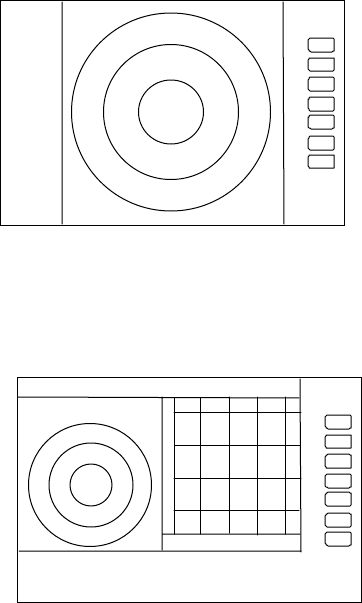
44
µθ> or (Select left screen) → Left
screen activated
If VRM1 is controlled on the screen that is oposit from current VRM1 displayed screen,
VRM1 is moved and displayed to activated screen. The EBL1, EBL2, and VRM2 is the same
manner.
5.4.22 Changing the color of screen (PICTURE)
The LCD display is affected by weather and day / night environment conditions. In some
cases, you may find the LCD display is easier to view when the entire color of screen is changed.
Press the "PICTURE " key, a day display will appear if night display has been selected, and a
night display if day display selected.
Note: Refer to "5.5.4.3 Changing the color of screen (PICTURE)".
5.4.23 Change to PPI screen ( PPI )
Press the "PPI" key, the screen will change to PPI
screen.
Use to change the screen from other modes to PPI.
5.4.24 Change to SEMI3D/PPI screen ( SEMI3D )
Press the "SEMI3D" key, the screen will change to
SEMI3D/PPI screen.
Use to change the screen from other modes to
SEMI3D/PPI.
Note: All controls, such as EBLs, VRMs effects both screen.
The ZOOM, OFF-C, FL EBL2, and FL VRM2 could not
be used on this mode. The "SEMI3D" screen displays
the center as ship's heading always.
5.4.25 Change to PPI/PPI screen ( PPI/PPI )
.
75
.25
HU
+
PPI screen
.75 .25 HU S
{
280 320 000 040 080
SEMI3D/PPI screen
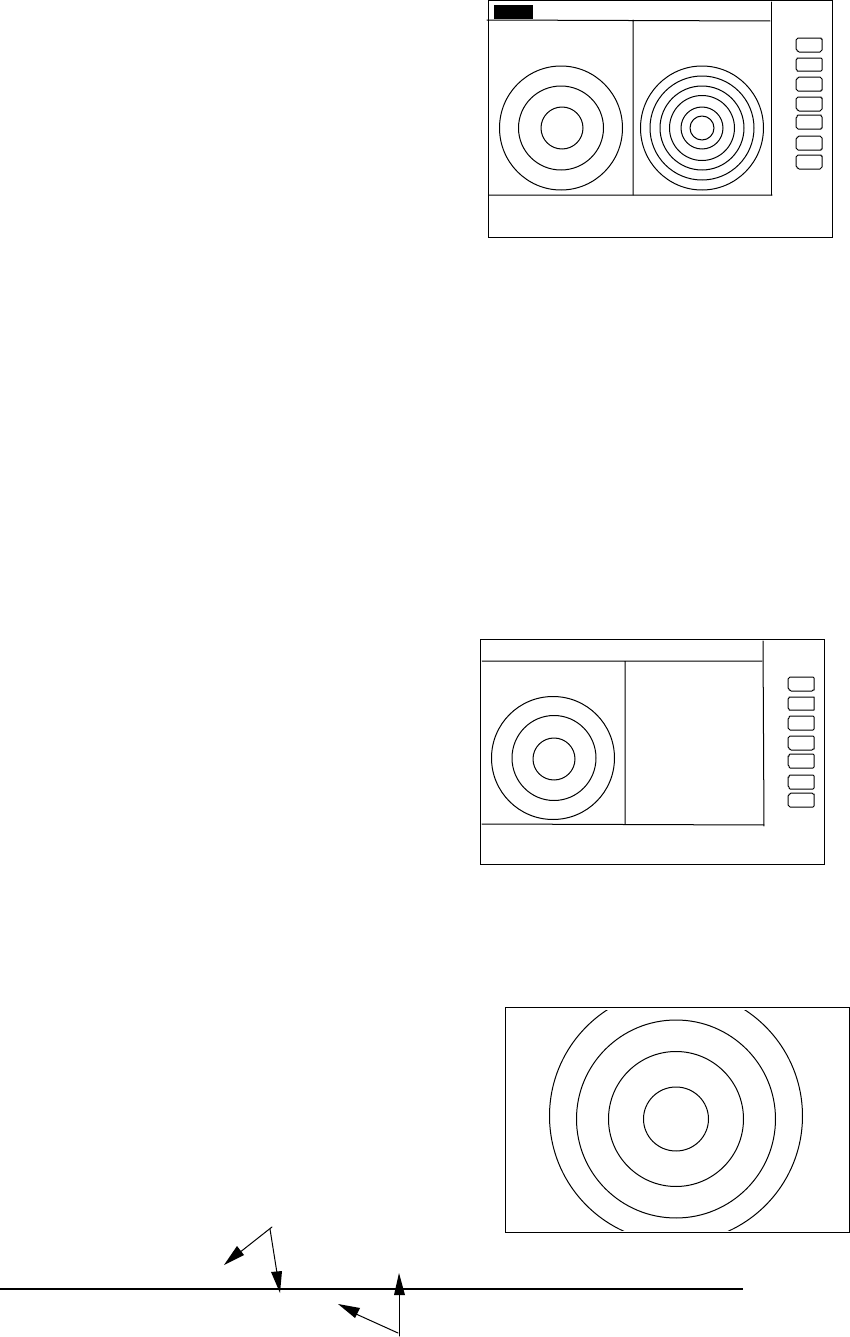
45
Press the "PPI/PPI" key, the screen will change to
PPI/PPI screen. Use to change the screen from other
modes to PPI/PPI.
Note:
(1) The radar picture is refreshed with two scanning
interval for each screen. Right screen picture is
holded during refreshing left screen, left screen
holded during refreshing right screen.
LEFT screen /---------/********/---------/********/---------/******** time→
→→
→
RIGHT screen ********/---------/********/---------/********/---------/
(2) The ZOOM, OFF-C, FL EBL2, and FL VRM2 could not be used on this mode.
(3) The range, GAIN, STC, FTC, GZ can be used independently for selected window with "SEL
WIN".
Selected window is that the range displayed in reverse character. Please refer to "SEL WIN".
(4) The cross cursor can be controlled on selected window.
5.4.26 Change to PPI/NAV screen ( PPI/NAV )
Press the "PPI/NAV" key, the screen will change to
PPI/NAV screen.
Use to change the screen from other modes to
PPI/NAV.
Note:
The ZOOM, OFF-C, FL EBL2, and FL VRM2 can not be
used on this mode.
5.4.27 Change to ALL PPI screen ( ALL PPI )
Press the "ALL PPI" key, the screen will change to ALL
PPI screen.
Use to change the screen from other modes to ALL PPI.
Note:
(1) The range, rings interval, display mode are displayed on
the upper left of the screen.
(2) Return to PPI screen mode pressing a key except MENU,
range UP or DOWN, or POWER key.
5.4.28 Change to ALL PPI/PPI screen ( ALL PPI2 )
.75 .25 HU S 24 6
{
G 55/35
S 35/AT
F 35/AT
PPI/PPI screen
.
75
.25 HU s
+
NAV DISPLAY
WAY P 123.4°
6.8NM
COURSE 2.38NM
XTE <<<<
HDG 267.3°T
SPD 12.8‚j‚s
TEMP 20.8°C
DEPTH 58.3M
LAT/LON
34
° 08. 22N
138
° 02 .53E
PPI/NAV screen
.
75
.25
HU
+
ALL PPI screen
refreshing radar picture
holding previous picture
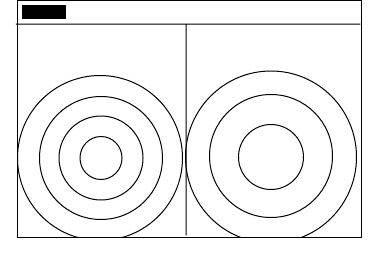
46
Press the "ALL PPI2" key, the screen will change to
ALL PPI/PPI screen.
Use to change the screen from other modes to ALL
PPI/PPI.
Note:
(1) The range, rings interval, display mode are displayed
on the upper left of each screen.
(2) Return to PPI/PPI screen mode pressing a key except
MENU, range UP or DOWN, or POWER key.
(3) The radar picture is refreshed with two scanning
interval for each screen. Right screen picture is holded during refreshing left screen, left
screen holded during refreshing right screen. When your ship navigates in high speed, use
PPI screen to get fast refreshing picture.
.75 @
.25 HU S .25 .125
{
ALL PPI/PPI screen
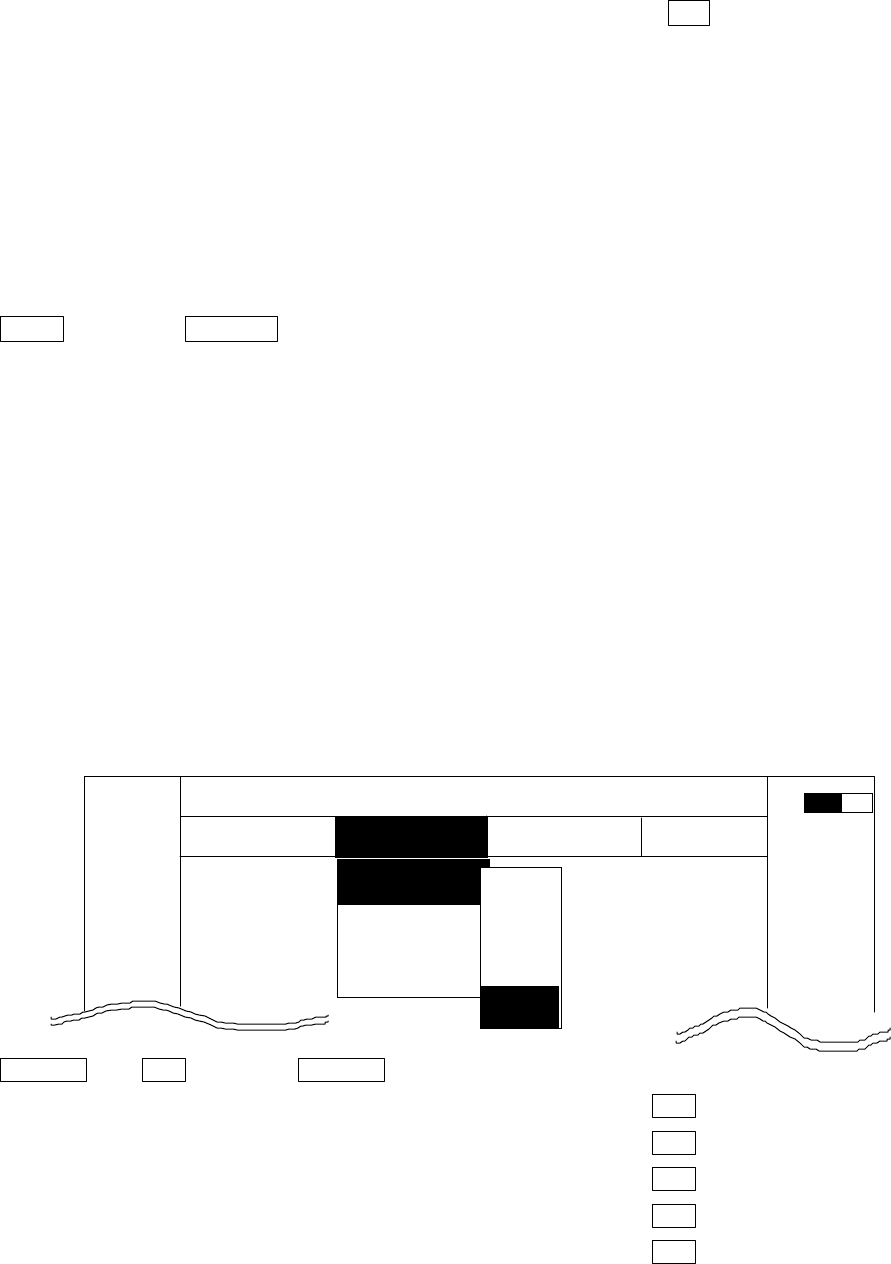
52
5.5.2 Nav (Navigation) Menu xxx = keys to press
Radar functions for navigation aid are in this menu.
•Common operations for the NAV menu
(Up to the point when "NAV" menu is selected from the main menu)
Press the "MENU" key and select "NAV" from the displayed 4 main menus using the left-right
cursor. (The contents of the selected MENU will appear on a pull-down display in accordance
with the movement of the left-right cursor.)
MENU →Left/Right
(Select NAV)
Further explanation about the NAV menu will be conducted on the assumption that this
"common operation for the NAV menu" has already been completed.
5.5.2.1 Changing display mode (MODE)
(1) Select MODE from the pull-down display items using the up-down cursor key, and press
either the "ENT" key.
(2) When the MODE sign is displayed beside the MODE item, select a mode with the up-down
cursor keys and press the "ENT" key.
(3) The display mode indicates upper-left on the screen.
UP/DOWN --> ••• --> UP/DOWN
•Select MODE• |--> (Select HU• --> ............ ••• •••Head up•
|--> (Select HS• --> ............ ••• •••Head set•
|--> (Select NU• --> ............ ••• •••North up•
|--> (Select CU• --> ............ ••• •••Course up•
--> (Select TM• --> ............ ••• ••(True motion)
Note1: Navigation equipment (gyrocompass, magnet compass, or GPS) must be connected to
your radar in NU, CU and TM modes.
Note2: In TM modes it is necessary to set as follow (1) or (2).
(1) Input of speed information from NMEA. (2) Set your ship’s speed manually.
Note3: TM works only on PPI screen, NU is used automatically for the other screens.
MARK
MODE >
GZ >
OFF-C >
SLEEP >
.75
.25
HU L NAV ECHO SETUP
NAVIGATION
>>>
0.23 NM
AT
HU
HS
NU
CU
TM
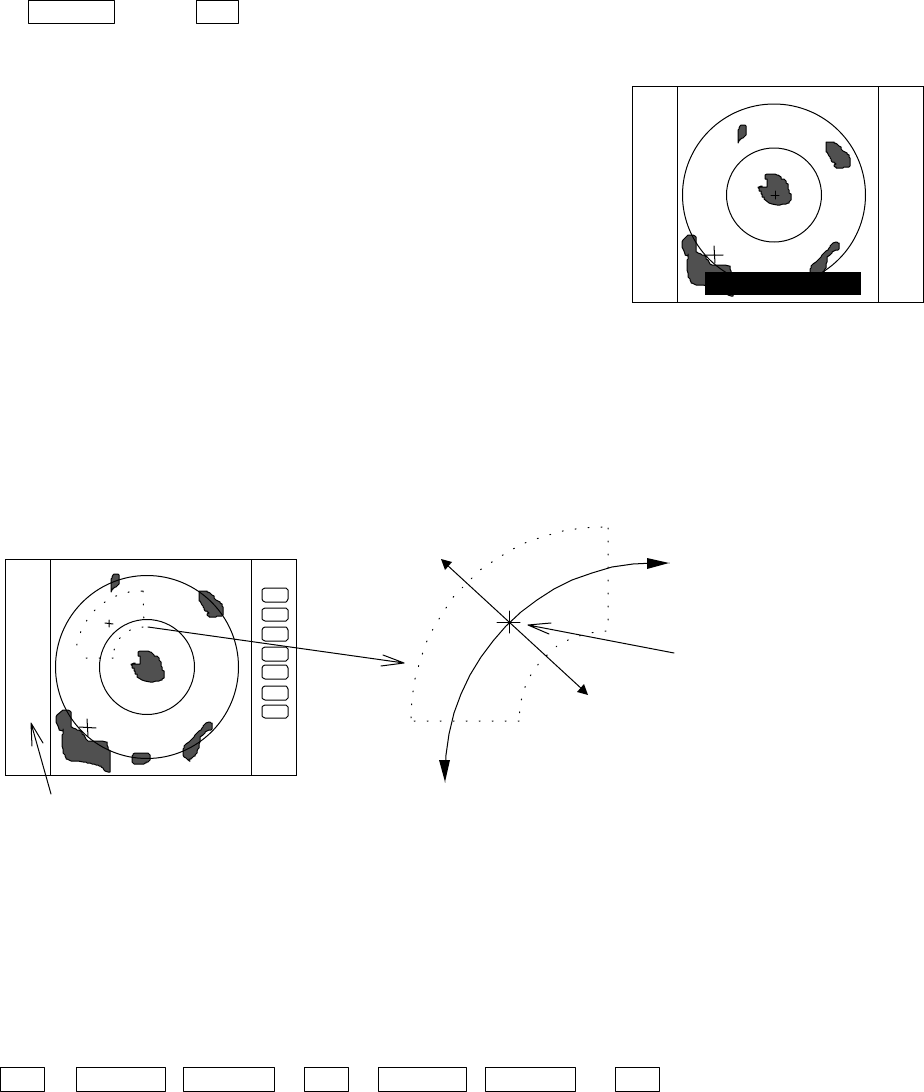
53
5.5.2.2 Guard Zone (GZ)
A function that sets a guard zone of any distance and any angle range, creating alarm tone
when either echoes above a certain level exist (IN MODE) or no echoes exist(OUT MODE).
Setting guard zone
(1) Select GZ from the pull-down display items using the up-down cursor keys, and press the
“ENT” key. ON/OFF sign is displayed beside the GZ item.
Up/Down --> ENT ------------------------------- ON/OFF sign is displayed.
(2) Select “ON” by “common operation for the GZ
menu”, and press the “ENT” key.
(3) The present mode setting will be displayed on the left
side of the screen as GZ IN. A small cross cursor for
setting the guard zone will be displayed at the screen
center while "SET CENTER POINT" is displayed at
the bottom, activating a guard zone setting state.
(4) Use the up-down and left-right cursor keys to move the cross cursor to the center of
the warning zone to be set, and press the "ENT" key.
(5) From the cross cursor position set in (4) above as the center, expand the guard zone as
follows.
(6) After the setting the guard zone, finish by pressing the "ENT" key.
To cancel the guard zone function, select “OFF” by
“common operation for the GZ menu”, and press
the “ENT” key.
ENT --> Up/Down &Left/Right --> ENT --> Up/Down &Left/Right •--> ENT ----------------Setting completed
(Setting the center of GZ) (Setting the scope of GZ) -----------------------------------------
GZ IN
SET CENTER POINT
The central position of the guard zone.
With this point as the center, the zone
can be expanded in the directions of
the distance and the angle with the
upper and right cursor keys
Expand with the right cursor key in
the direction of the angle. Use the
left cursor key to make the zone
Expand with the up cursor key in the
direction of the distance. Use the down
cursor key to make the zone smaller.
The mode (IN or OUT) is displayed when the state is
ON. Nothing is displayed when it is OFF.
GZ IN
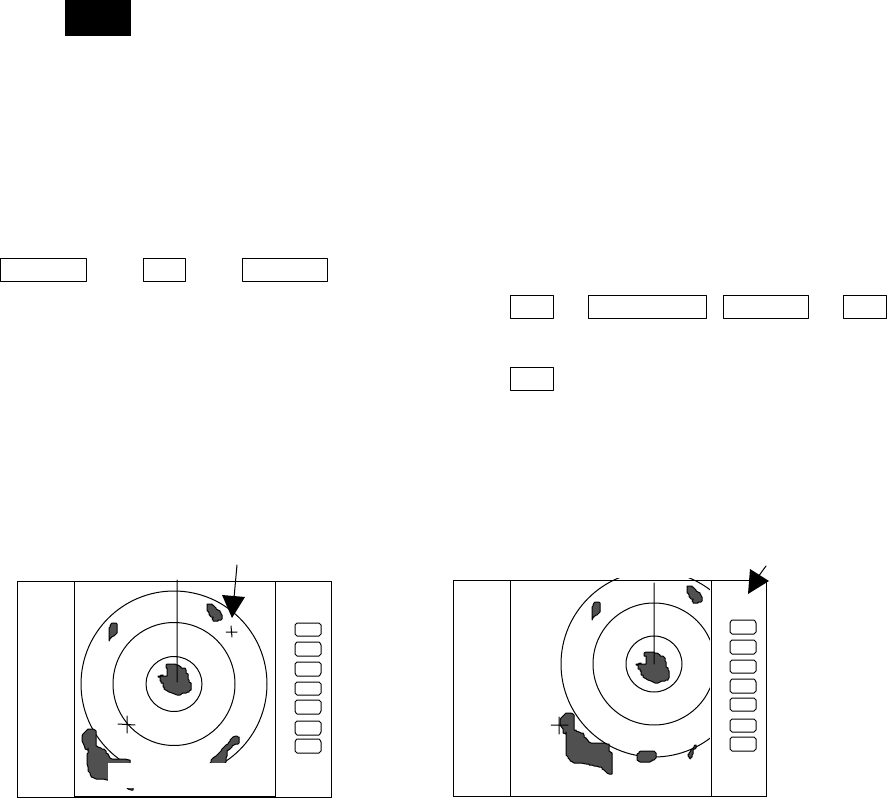
54
Stop the alarm tone
When the alarm sounds, press any key to stop. But the guard zone function is still
working, the alarm may sounds again. To "OFF" the guard zone function, select "OFF"
from GZ menu.
Note1: To switch the IN or OUT mode, refer to “Guard Zone Mode” in section 5.5.4.5.3 “Changing
the content of settings 2 (PRESET2)”
Note2: To set the guard zone level, refer to “Guard Zone LeveL” in section 5.5.4.5.3 “Changing the
content of settings 2 (PRESET2)”
5.5.2.3 Shifting display in specific direction (OFF-C)
Displaying the location specified by the cross cursor as the vessel's location.
(1) Select OFF-C from the pull-down display items using up-down cursor key, and press the
"ENT" key.
(2) When the ON/OFF sign is displayed beside the OFF-C item, select ON with the up-down
cursor keys and press the "ENT" key.
(3) OFF-C is displayed at the upper right and "SET OFF CENTER POINT" at the bottom of
the screen, and setting is ready to be entered. Move the cross cursor with the cursor
keys to move the ship’s to the intended location, and press the "ENT" key. The ship’s
location will be displayed at the cursor's location. The display at the upper right will be
normalized from the reverse state, which indicates that the "OFF-C" state is entered.
(4) To cancel “OFF-C” function, either select OFF in (2)
Up/Down --> ENT --> Up/Down
(Select OFF-C) |-->(Select ON) ENT --> Left/Right & Up/Down --> ENT Set
OFF-C
-->(Select OFF) ENT -----------------------------
Cancel OFF-C
Note: VRM2 and EBL2 do not follow the OFF-C function while floating.
The function operates only on PPI screen.
5.5.2.4 Setting of the SLEEP function(SLEEP)
This function sends a 30-second-transmissions during pre-fixed hours. After a
transmission, a power-saving mode is entered with the screen in ST'BY state (the scanner-OFF
.75
.25
HU
.75
.25
HU
SET OFF-C POINT
OFF-C
Move the cross cursor indicates "OFF-C" state is entered
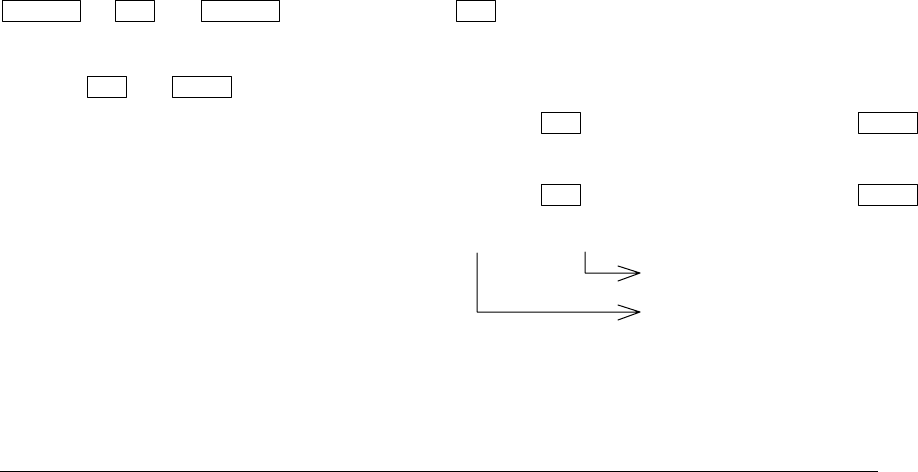
55
state) and the LCD backlight turned off. This action is repeatedly executed.
Usage example, set a guard zone and have the warning signal automatically confirmed every
prefixed period.
(1) Use the up-down cursor keys to select SLEEP from among the pull-down display items, and
press the "ENT" key.
(2) When the OFF/5min/10min/15min display has appeared beside the SLEEP item, select a
time to be set with the up-down cursor keys.
(3) Press the "ENT" key and the setting is completed. When the SLEEP function is to be
canceled, select OFF in (2).
When a transmission is conducted after setting a SLEEP mode, a ST'BY state is entered
and the backlight turns off after a 30-second-transmission. (Power-saving mode). Two
minutes before the fixed time the backlight turns on and the 2-minute timer starts. Then, at
the fixed time another 30-second-transmission begins. This series of actions are repeated. If
any one key is pressed during the course of this action, the SLEEP function will be canceled.
(a) Setting procedure
Up/Down →ENT →Up/Down -->Select OFF) →ENT -----------SLEEP function is turned OFF
(Select SLEEP) -->(Select 5min.) ------------------------------- →
ENT →POWER 30-second-transmission every 5 min.
-->(Select 10min.) →ENT →------------------------ POWER
30-second-transmission every 10 min.
-->(Select 15min.) →ENT → ----------------------- POWER
30-second-transmission every 15 min.
Transmission
Setting completed
(b) Action after setting
SLEEP setting•5min.• •Operation•
•
•(Under Tx• •(Under power-saving mode•• •
2min. timer in use••
(Under Tx•••
(Under power-saving mode•
0 sec. 30 sec. 3 min. 5min. 5and a half min. •Time used•
TX Start TX OFF Backlight ON Tx Start TxOFF •Action•
Countdown start
-- What happens if a key is pressed after a SLEEP mode setting?
If a transmission is conducted and a key is pressed after setting a SLEEP mode, power-
saving mode is entered 30 seconds after key is pressed.
-- What happens if a key is pressed during the SLEEP mode?
a) If a key is pressed during the power-saving mode, the SLEEP function is canceled and the 2-
minute timer starts.
56
b) If a key is pressed while the 2-minute timer is in use, or during transmission , the SLEEP
function is canceled.
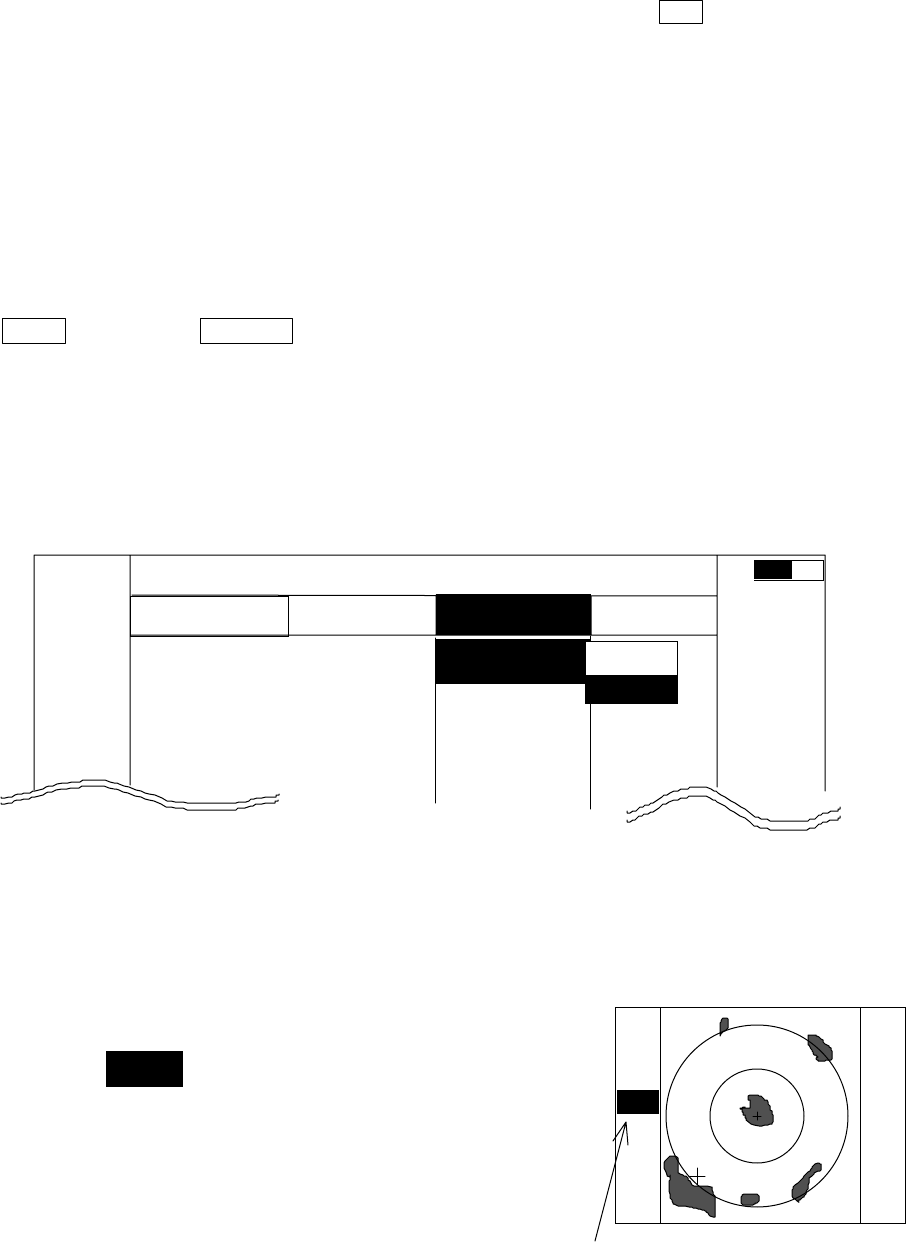
56
5.5.3 Echo Menu xxx •••keys to press
Adjustment options to be conducted on the echoes displayed on the screen
•Common operations for the ECHO menu (Up to the point when "ECHO" menu is selected
from the main menu)
Press the "MENU" key and select "ECHO" from the displayed 4 main menus using the left-
right cursor. (The contents of the selected MENU will appear on a pull-down display in
accordance with the movement of the left-right cursor.)
MENU •••---> Left/Right
(Select ECHO)
When the above-mentioned operations have been conducted, the items of the ECHO menu
are vertically displayed.
Further explanation about the ECHO menu will be conducted on the assumption that this
"common operation for the ECHO menu" has already been completed.
5.5.3.1 Sensibility adjustment (GAIN)
(1) Use the up-down cursor keys to select GAIN from among the pull-down display items, and
press either the "ENT" key or the right cursor key.
(2) Select MANU from the MANU/AUTO display beside the GAIN item using the up-down
cursor keys, and press the "ENT" key.
(3) The present state of GAIN is displayed in reverse on the
screen left as•G 35• and an adjustable state is entered.
When the control knob are operated in this state, the
figure alternates within a range of 0 and 99 and the GAIN
can thus be adjusted.
(4) The adjustment is completed by pressing the "ENT" key
after adjustment.
When AUTO action is to be entered, select AUTO in (2)
and press the "ENT" key to complete the setting.
G 56
The setting value is displayed during
MANUAL operation.
AT is displayed during AUTO operation.
(The same applies to STC, FTC and TUNE.)
MARK
.7 5
.2 5
H U L NAV ECHO
S
ET
U
P
ECHO
>>>
0.23 NM
GAIN >
STC >
FTC >
TUNE >
ST >
•MANU
•AUTO
AT
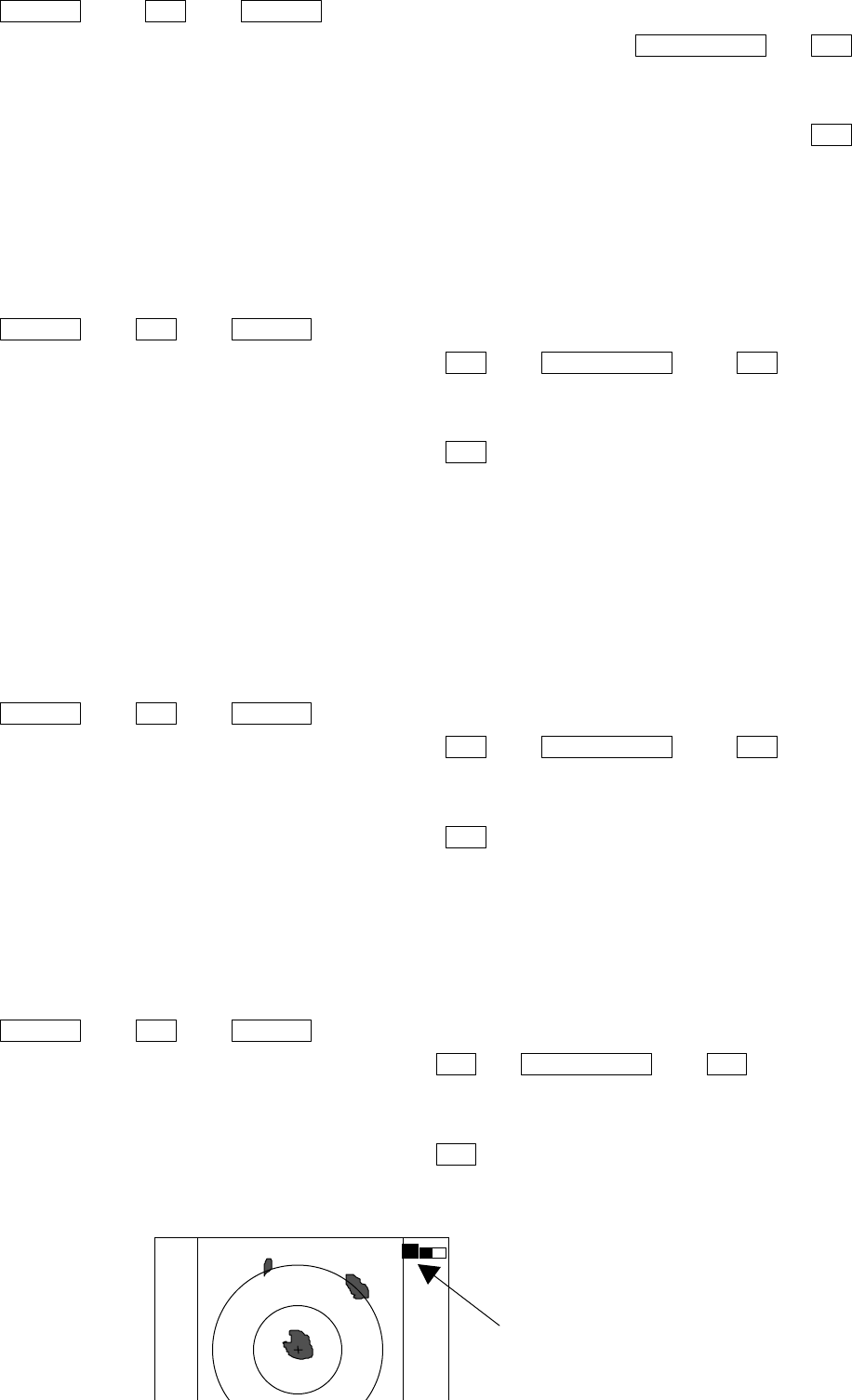
57
Up/Down --> ENT --> Up/Down
(Select GAIN) |->(Select MANU) --------------------> Control knob --> ENT
Set to MANU mode
| (GAIN adjustment)
|->(Select AUTO) ----------------------------------- --> ENT
Set to AUTO mode
5.5.3.2 Removing sea clutter (STC)
Refer to the section, “Sensibility adjustment (GAIN)”.
Up/Down --> ENT --> Up/Down
(Select STC) |->(Select MANU) --> ENT --> Control knob --> ENT Set to
MANU mode
| (STC adjustment)
|->(Select AUTO) --> ENT -----------------------------------
Set to AUTO mode
Note: When you select MANU mode, GAIN and FTC will be switched to MANU mode, too.
Note: When you select HARBOR mode, FTC will be switched to MANU mode.
5.5.3.3 Removing rain and snow clutter (FTC)
Refer to the section, “Sensibility adjustment (GAIN)”.
Up/Down --> ENT --> Up/Down
(Select FTC) |->(Select MANU) --> ENT --> Control knob --> ENT Set to
MANU mode
| (FTC adjustment)
|->(Select AUTO) --> ENT -----------------------------------
Set to AUTO mode
5.5.3.4 Adjusting receiver tuning (TUNE)
Refer to the section, “Sensibility adjustment (GAIN)”.
Up/Down --> ENT --> Up/Down
(Select TUNE) |->(Select MANU) --> ENT --> Control knob --> ENT Set to MANU
mode
| (TUNE adjustment)
|->(Select AUTO) --> ENT ------------------------------------
Set to AUTO mode
35
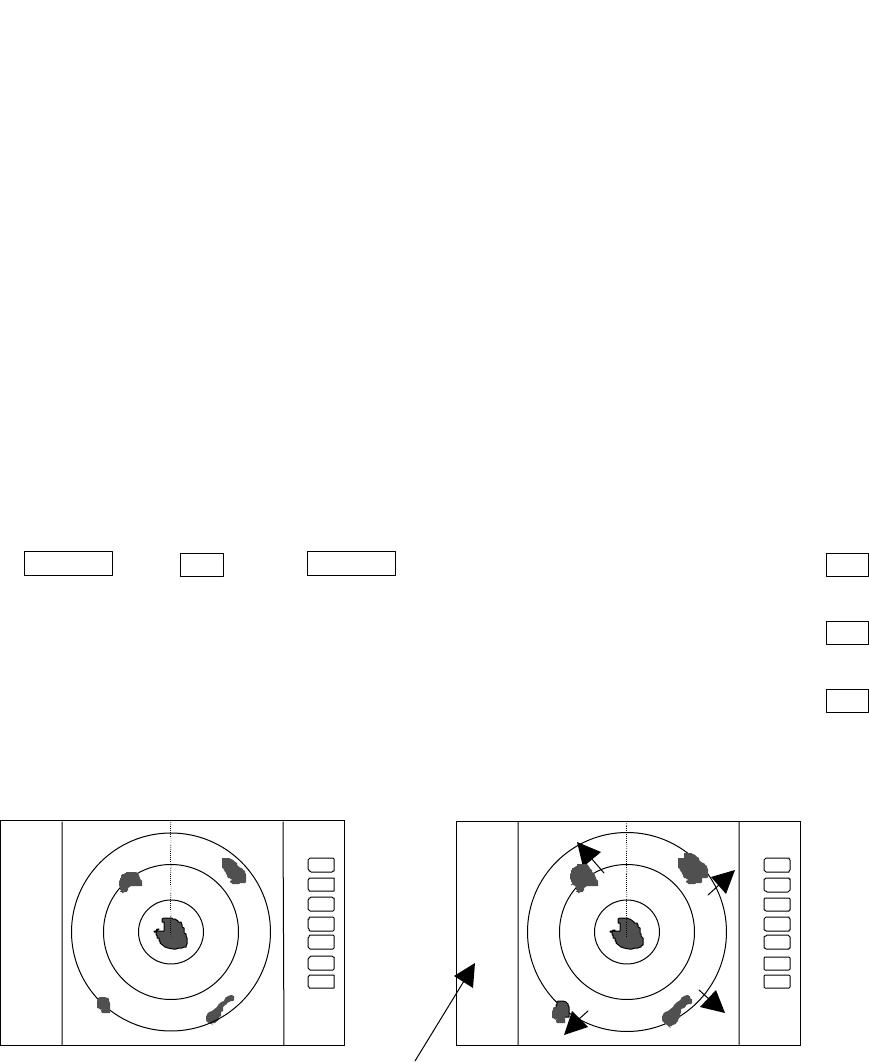
58
5.5.3.5 Echo expansion (ST)
Expanding the echo to the direction of the distance.
Two types of echo expansion exist, select ST1 or ST2 from the menu.
(1) Use the up-down cursor keys to select ST from among the pull-down display items, and
press the "ENT" key.
(2) Select ST1 or ST2 from the display beside the ST item using the up-down cursor keys,
and press the "ENT" key.
Up/Down --> ENT --> Up/Down -->••select ST1• ............... --> ENT
set ST1
|->••select ST2• ............... |-> ENT
set ST2
|->••select OFF• ............... |-> ENT
ST OFF
( expansion rate ST1<ST2 )
5.5.3.6 Displaying locus of target (TRACK)
(1) Use the up-down cursor keys to select TRACK from among the pull-down display items,
and press the "ENT" key.
(2) Select 15SEC, 30SEC, 1MIN, 3MIN, 6MIN, or CONT from the display beside the TRACK
item using the up-down cursor keys, and press the "ENT" key.
"TRK 15S" is displayed on the left side of the screen and track mode is entered. 15S
indicates the length of the track, and displays a maximum of 15-second-long sailing track.
.75
.25
HU
+
ST1
.75
.25
HU
+
The picture to display echoes
expanded in the direction of
the distance
ST1, or ST2 display,
no display on OFF state
ST function is OFF
Indicated setting value on
manual mode,
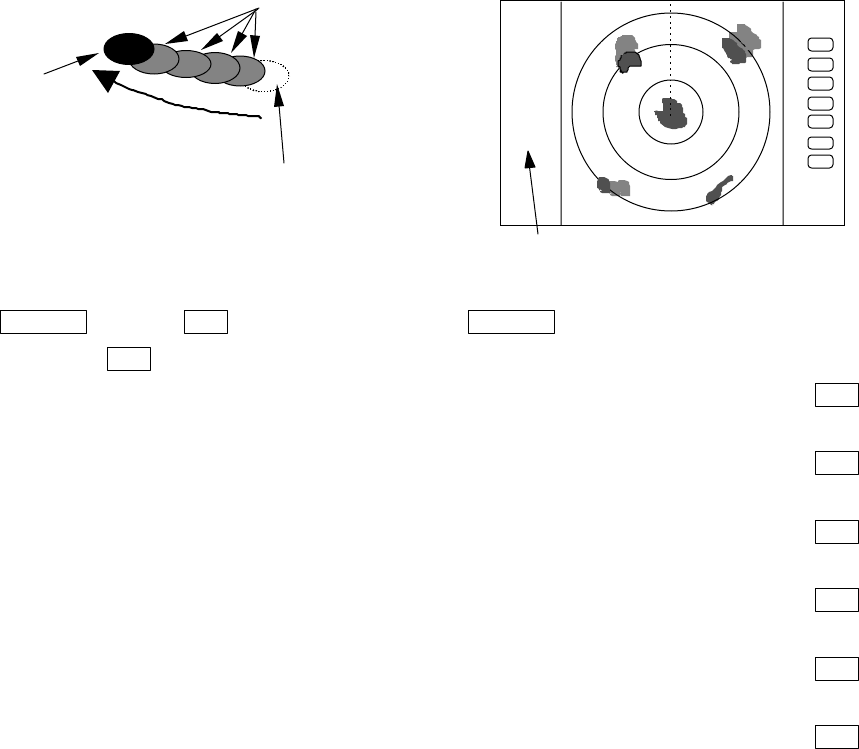
59
Note: When PPI+PPI or ALL PPI+PPI screen mode is used, TRACK function can be used
only on CONT mode.
up/down --> ENT --> up/down ........... ->••select OFF•
-> ENT TRACK OFF
|---->••select 15SEC• ......................... -> ENT
set 15sec. track
|---->••select 30SEC• ......................... -> ENT
set 30sec. track
|---->•select 1MIN• ........................... -> ENT
set 1 min. track
|---->•select 3MIN• ........................... -> ENT
set 3 min. track
|---->••select 6MIN• .......................... -> ENT
set 6 min. track
|---->••select CONT• .......................... -> ENT
set continue track
5.5.3.7 Enlarging selected areas (ZOOM)
The video image centering around the cross cursor is doubled as it is displayed on the
screen.
(1) Use the up-down cursor keys to select ZOOM from among the pull-down display items, and
press the "ENT" key.
(2) Select the ON using up-down cursor keys from the ON/OFF display beside the ZOOM item,
and press the "ENT" key.
(3) A small cross cursor for setting and "SET ZOOM POINT" are displayed at the screen center
and at the bottom respectively, and the magnification point is to be set. Use cursor keys to
move the cross cursor to the point to be magnified, press the "ENT" key and the setting is
completed. The area around the cross cursor is displayed in 2x magnification, with blinking
"ZOOM" displayed at the screen upper right, indicating that a ZOOM display is being
conducted.
To cancel the ZOOM function, either select OFF in (1) or begin operation of range.
disappear after selecting time
real echo
locus of target
moving direction
t
he length of the track
.
75
.25
HU
+
TK 15SEC
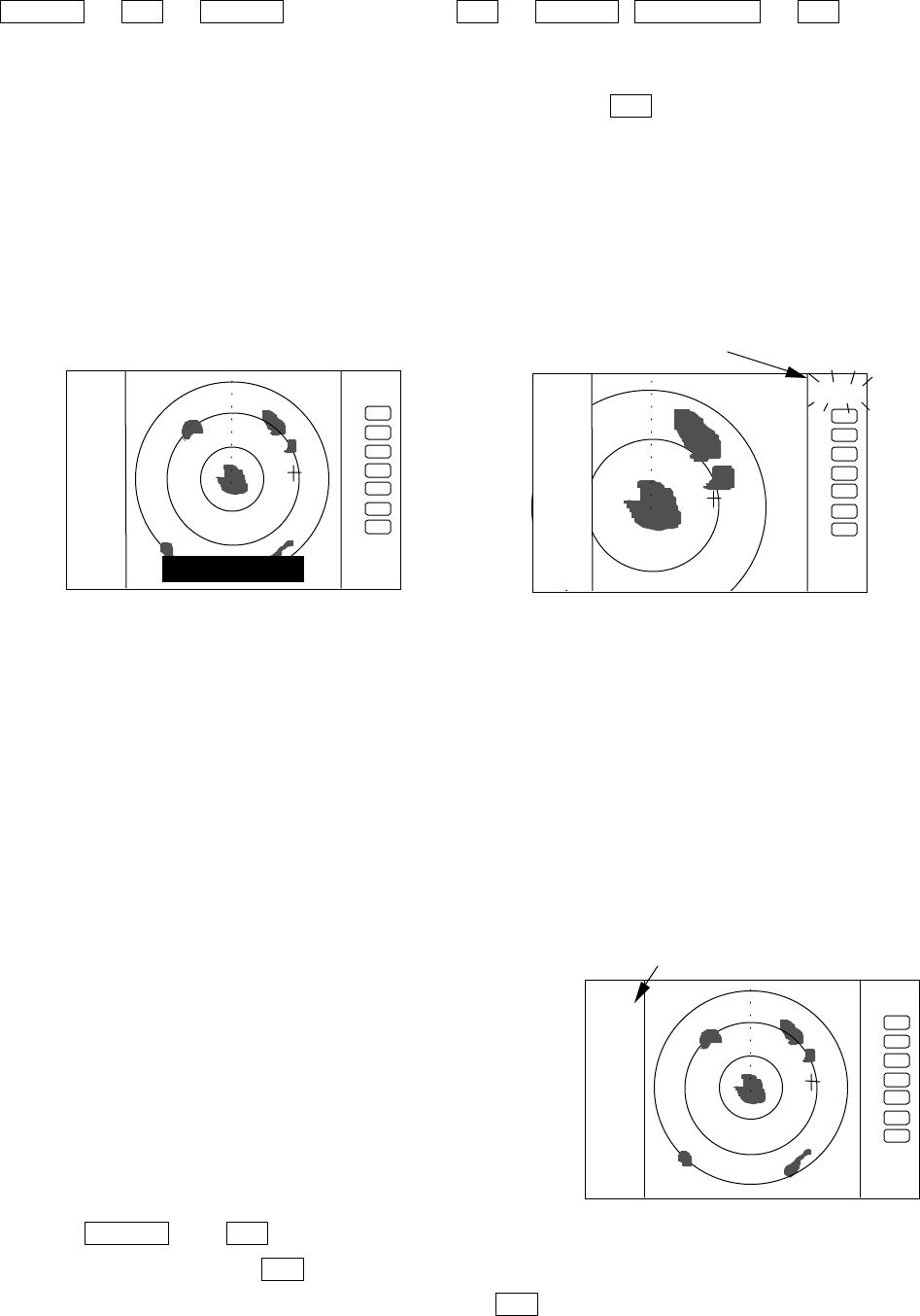
60
Up/Down --> ENT --> Up/Down (Select ON) --> ENT --> Up/Down & Left/Right --> ENT
ZOOM Setting
(Select ZOOM) | (Move cross cursor)
|--> (Select OFF) --> ENT ----------------
ZOOM canceled
Note 1) VRM2 and EBL2 do not follow the ZOOM function during a floating state.
Note 2) Normal screen returns when you change the range scale.
Note 3) ZOOM function is usable only in PPI screen.
Note 4) ZOOM function is unusable in OFF-C.
Note 5) Center of ZOOM can be set any desired position within the set range.
5.5.3.8 Increasing sensitivity (S/L)
The pulse width is automatically changed as you change the range. However, if you want
to increase sensitivity, you can choose sensitivity from two pulse widths. The short pulse
(SHORT) gives you sharp images with high distance resolution. The long pulse (LONG) provides
high sensitivity and shows targets in large size for easy identification although distance
resolution is reduced.
(1) Use the up-down cursor keys to select S/L from among the pull-down display items, and
press the "ENT" key.
(2) Select Pulse length(SHORT or LONG) using the up-
down cursor keys from the SHORT/LONG display
beside the S/L item
(3) The setting will be completed when the “ENT” key is
pressed after the selection.
Up/Down --> ENT -->(Select SHORT) -------------------- -->
ENT Set to short pulse
|-->(Select LONG)--> ENT -------------- Set to long pulse
.75
.25
HU
SET ZOOM POINT
.75
.25
HU S
.75
.25
HU
+
indicated S or
ZOOM
blinking "ZOOM"
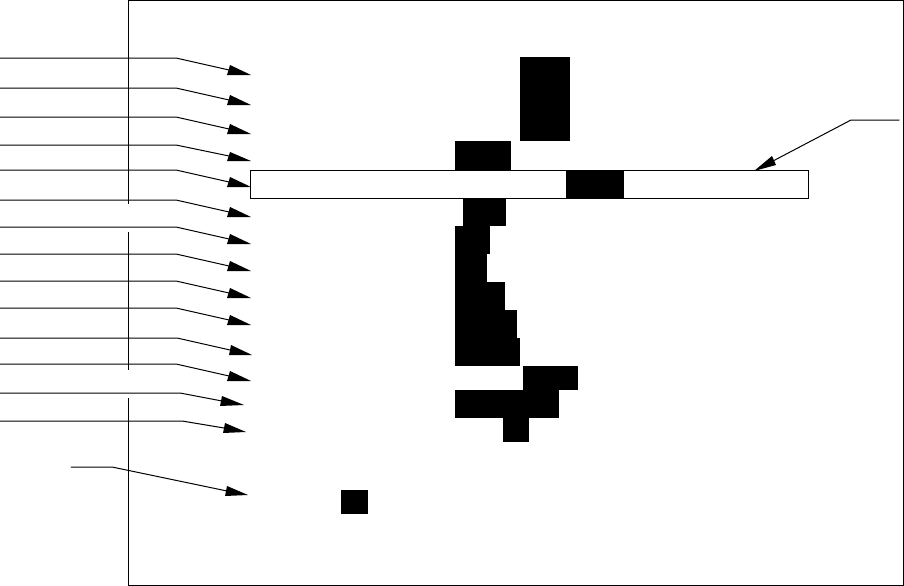
71
5.5.4.5.2 Changing the content of settings 1(PRESET1)
(1) When PRESET1 is selected from CUSTOM items and the "ENT" key is pressed, the
PRESET1 screen (See chart below) appears.
(2) Select items with up-down keys and contents with left-right keys.
The selected items will be enclosed by square frames and the contents will appear in
reversed display. (a)
Repeat this operation when multiple settings are to be made.
(3) After the setting is completed, exit from the PRESET1 screen with the "ENT" key.
Note) The contents will be displayed in (b) together with the numbers selected in P TABLE.
•• Heading Flash Each revolution of the antenna turns the heading marker
on
and off.
b) Stern Mark Display/non-display of the stern line
c) North Mark Display/non-display of the north mark
•• ST'BY screen Setting the screen display in stand-by
NAVI: Navigation Data screen
NOR: Normal screen
e) Buzzer Volume Setting the volume of the buzzer
a) Heading Flash
b) Stern Mark
c) North Mark
d) ST'BY screen
e) Buzzer Volume
f) VRM Unit
g) Water temperature
h) Depth Unit
i) EBL Mode
j) WayPoint Mode
k) Heading Input
l) Heading Type
m) Cursor position
n) TX Pulse
PRESET1
HM FLASH ON _OFF_
STERN M ON _OFF_
NORTH M ON _OFF_
ST’BY _NAVI_ NOR
BUZ VOL OFF LOW _HIGH_
RM UNIT _NM_ KM SM
TEMP °
°°
°C_ °
°°
°‚e
DEPTH _M_ FT FM
EBL BRG _REL_ TRUE MAG
WP BRG _TRUE_ MAG
HEAD INPUT _NMEA_ SIN/COS 12BIT 10BIT
HEAD TRUE _MAG_
+MK MODE _DIST / BRG_ LAT / LON
P TABLE 0 _1_ 2
.5 .75 1.5 3 6
P TABLE _1_ SHORT 0 0 0 1 1
LONG 0 1 1 2 2
(a)
(b)
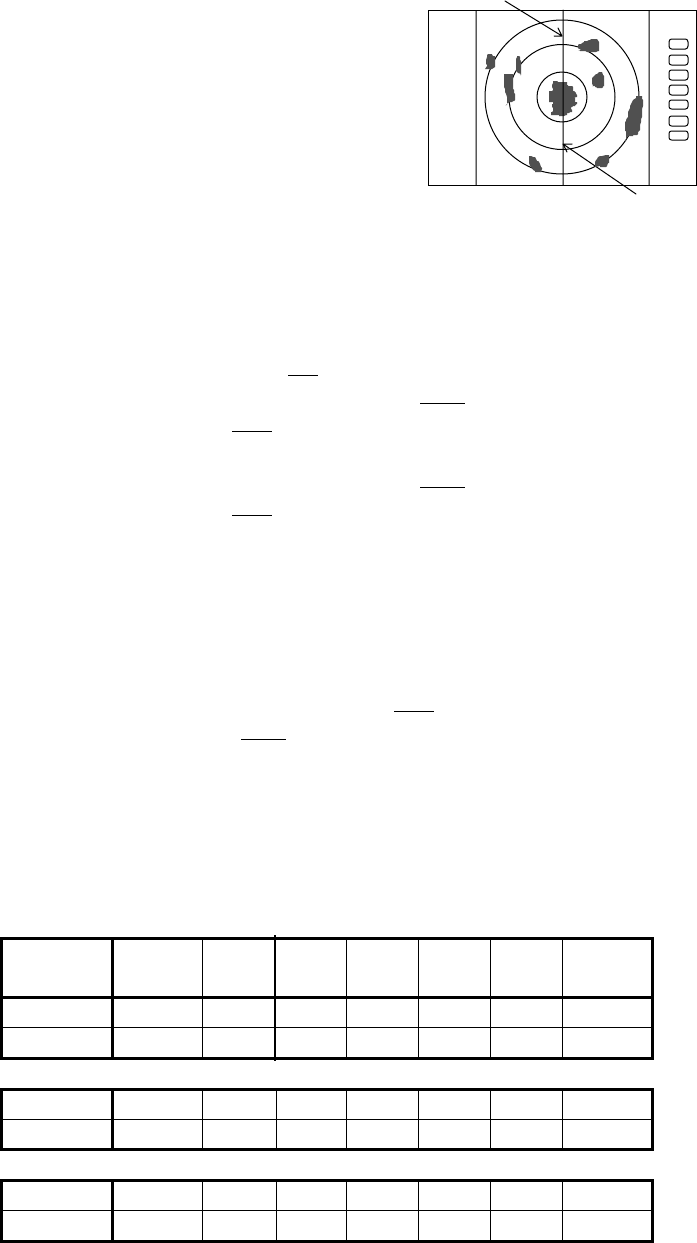
72
•• VRM Unit Setting VRM unit
••NM: Nautical mile
••KM: Kilometer
••SM: Statute mile
g) Water temperature Setting water temperature
unit
°C: Celsius
F: Fahrenheit
h) Depth Unit Setting Depth unit
M: Meter
FT: Feet
FM: Fathom
i) EBL Mode Setting Mode of EBL
REL: Relative bearing from HM
TRUE: True bearing
MAG: Magnetic bearing
j) WayPoint Mode Setting WayPoint bearing mode
TRUE: True bearing
MAG: Magnetic bearing
k) Heading Source Setting Heading source;
NMEA
SIN/COS: Compass Data with SIN/COS signal
12BIT: Compass Data with 12bits serial signal
10BIT: Compass Data with 10bits serial signal
l) Heading Type Heading Information Type setting
MAG: Magnetic bearing
TRUE: True bearing
m) Cross cursor position display Mode
DIST/BRG: Range and Bearing indication
LAT/LON: Latitude and Longitude indication
n) Transmitting pulse width Pulse setting for Range (Note: )
Note: P TABLE
PUSLE
TYPE
•0.25
NM
0.5 0.75
NM NM
1.5
NM
3
NM
6
NM
•12
NM
P TABLE 0 SHORT 0 0 0 0 0 1 2
LONG 0 0 0 1 1 2 2
P TABLE 1 SHORT 0 0 • 0 011 2
LONG 0 0 1122 2
P TABLE 2 SHORT 0 0 0 1 1 1 2
LONG 0 1 1222 2
Note• RA40C Pulse width 0 : 0.12 uS, 1 : 0.3 uS, 2 : 0.8 uS
ΡΑ41Χ/42Χ Πυλσε ωιδτη 0 : 0.08 uS, 1 : 0.25 uS, 2 : 0.8 uS
Heading Marker
S
tern Marker
.75
.25
HU
73
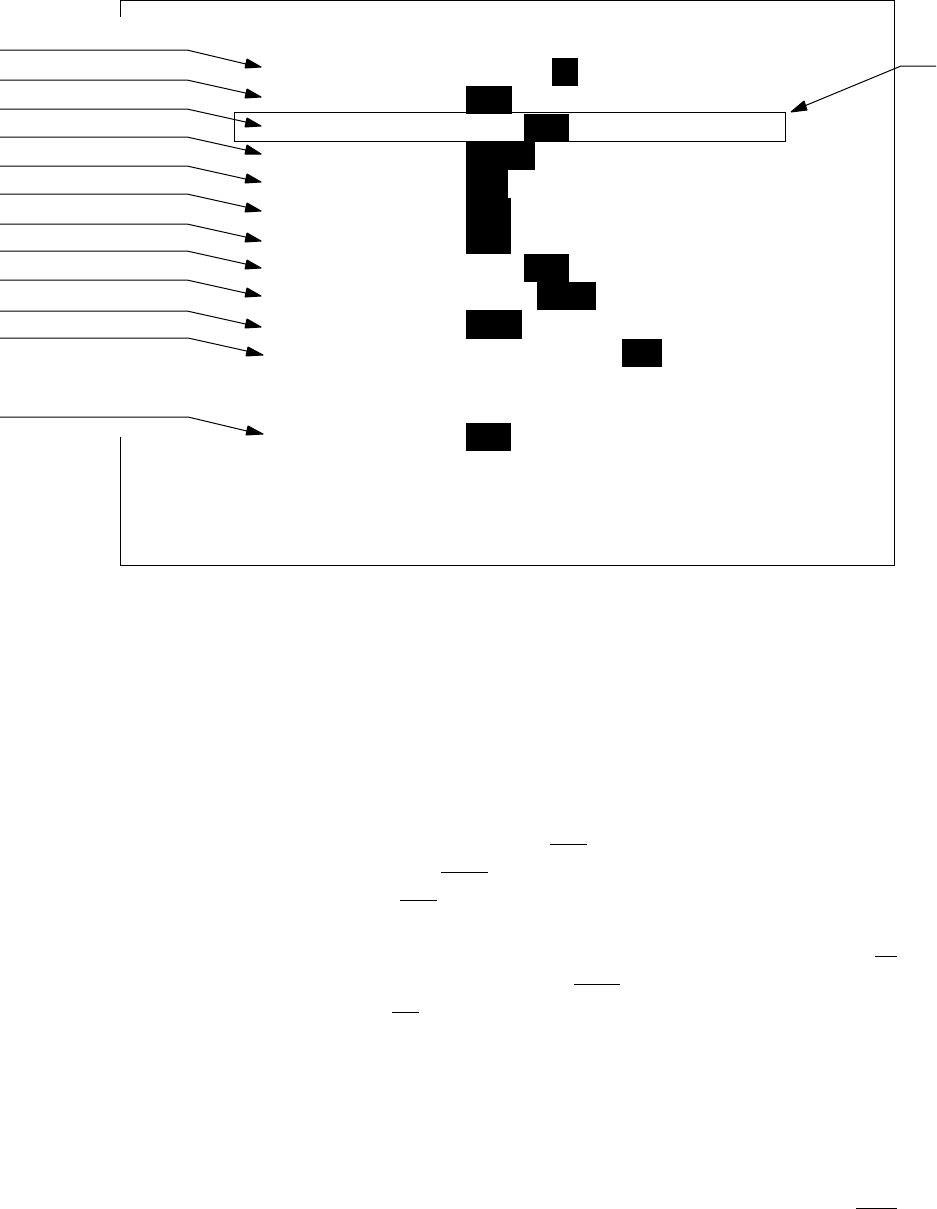
73
5.5.4.5.3 Changing the content of settings 2 (PRESET2)
Refer to the section, “Changing the content of setting 1(PRESET1)”.
a) Guard Zone Level Guard Zone Detection Level setting
1: High Sensitivity, .. 7: Big Target Only
b) Guard Zone Mode Guard Zone Detection Mode setting
IN: Detect Target in
OUT: Detect Target dissapear
c) Hold Hold the radar picture for 30 seconds after switch to ST'BY
The EBL and VRM can be used in HOLD state.(Note1: )
d) Display Unit Mode Display Unit Operation Mode setting
RDR: Radar mode(normal)
MONI: Monitor mode(for slave display use)
NAV: Navigation mode(for DATA indicator use)
e) External Buzzer External Buzzer control setting
OFF: Buzzer off
CONT: Continuous tone
INT: Intermittent tone
f) Bearing pulse/rot.(IN) Change the setting when connected to the other type of
radar
g) Bearing pulse/rot.(OUT) Change the setting when connected to the other type of
radar
h) Built-in simulator switch for Demonstration
i) Interference Rejection Reject the interference from the other radar
OFF: IR OFF
IR1: ON level 1
IR2: ON level 2
(a)
a
) Guard Zone Level
b) Guard Zone Mode
c
) Hold
d
) Display Unit Mode
e
) External Buzzer
‚†j
Bearing pulse/rot(IN)
g
) Bearing pulse/rot(OUT)
h) Built-in Simulator
i) Interference Rejection
j
) Ship's Speed
k) Indication Language
l) Scan speed
PRESET2
GZ LVL 1 2 3 4 5 6 7
GZ MODE I N OUT
HOLD ON OFF
DISPLAY RDR MONI NAVI
EXT BUZ OFF CONT INT
IN P /R 1080 1024 2048 4096 360
OUT P/R 1080 1024 2048 4096 360
DEMO ON OFF
IR OFF IR1 IR2
SPD SET NMEA MANU 0.0KT
LANGUAGE CHI DAN ENG FRE GER
GRE ITA JPN KOR NOR
POR RUS SPA SWE TUR
SCAN SPEED STD HIGH
PRESS ENTER KEY TO RETURN
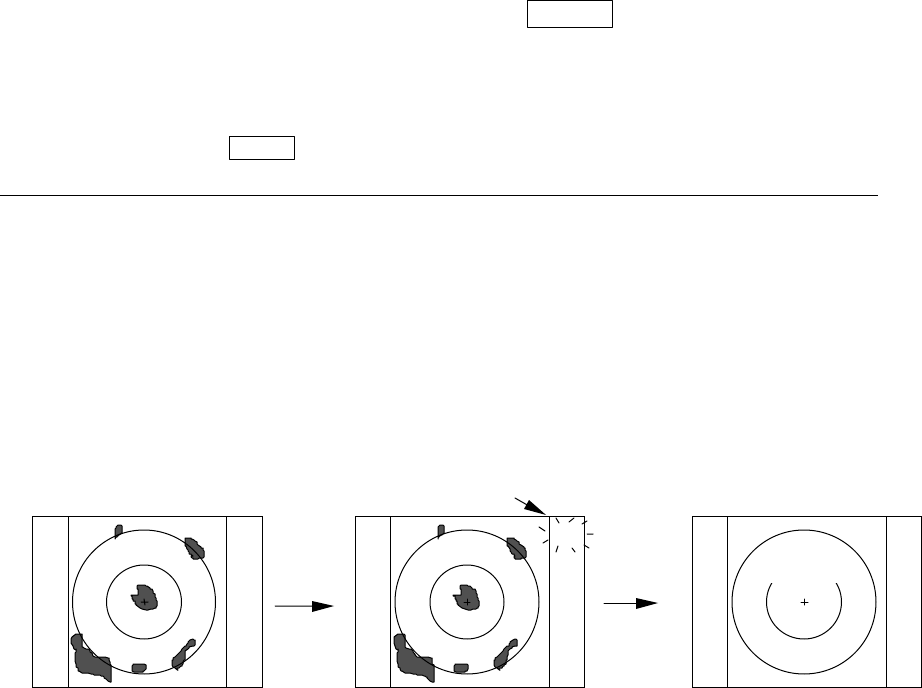
74
j) Ship's Speed Own ship's speed setting
NMEA: Data input from NMEA port
MANU: Set ship's speed with manual
Set the Speed with control knob.
k) Indication Language Select the language for MENU and SOFT KEY( Note2: )
l) Scan Speed Scanning speed setting
STD: Standard
HIGH: High speed
( The setting can be changed only on stand-by state.
)
Note1: HOLD function POWER • POWER key to press
HOLD is function which you want to hold the currently displayed radar screen conditions
while standby state. After finished operation such as EBL, VRM about 30 seconds, the screen
return to standby screen.
Setting HOLD POWER •Operation•
• •
•Under Tx• -----------------------------------•<-------Under HOLD
mode--->•<-----------ST’BY DISPLAY•••
Turn to transmission off
EBL,VRM operation:• seconds ••30seconds
•Time used•
NOTE) EBL and VRM function is usable in HOLD
state.
Note 2: 15 languages
CHI : Chinese KOR : Korean
DAN : Danish NOR : Norwegian
ENG : English POR : Portuguese
FRE : French RUS : Russian
GER : German SPA : Spanish
GRE : Greek SWE : Swedish
ITA : Italian TUR : Turkish
JPN : Japanese
ST’BY
HOLD
“HOLD” is displayed and blinks.
Tx OFF X•30sec.
Setting
HOLD
EBLs and VRMs can be used
for measuring target data.
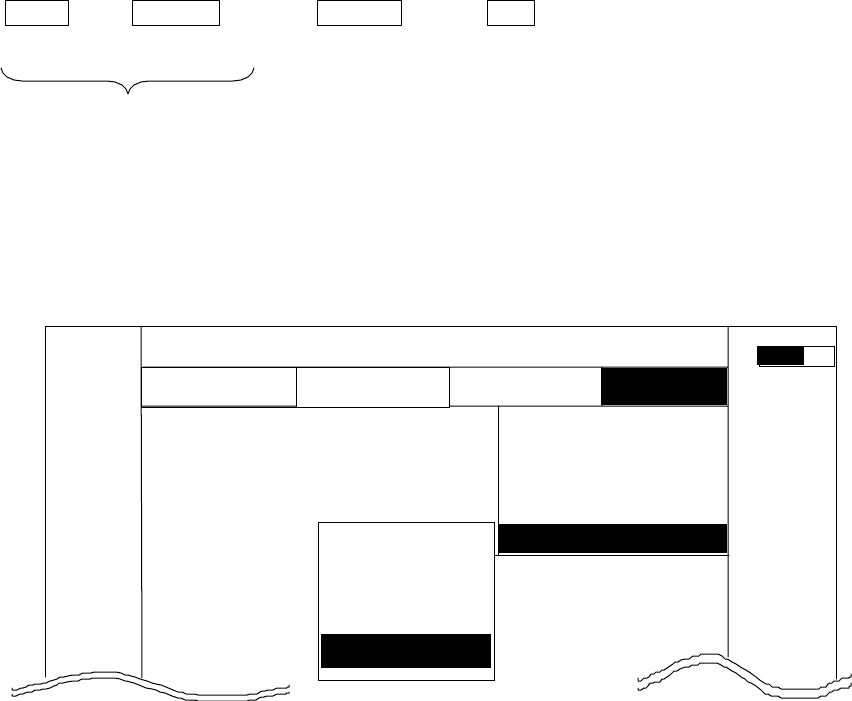
68
5.5.4.5 Changing the content of the setting (CUSTOM)
Note) Items in CUSTOM are for conducting settings and adjustments at the time of installation,
which need not be conducted normally.
-Common operations for CUSTOM
Use the up-down cursor keys to select CUSTOM after ”the common operations for the SETUP”
menu, and press either the "ENT" key.
MENU •→Left/Right →Up/Down →ENT
(Select SETUP) (Select CUSTOM)
Common operation for SETUP
When the above operations have been conducted, 4 items, namely "KEY ASSIGN", "PRESET1",
"PRESET2" and "ADJUST", are displayed beside the CUSTOM item.
Further explanation concerning the CUSTOM menu items will be done on the assumption that the
above "common operations for CUSTOM" have already been conducted.
CUSTOM >
SETUP WINDOW >
SEL WIN >
PICTURE >
SYSTEM CHECK
.75
.25
HU S
k
NAV ECHO SETUP
SETUP
>>>
0.23NM
A
T
KEY ASSIGN
PRESET1
PRESET2
NMEA PRESET
ADJUST >
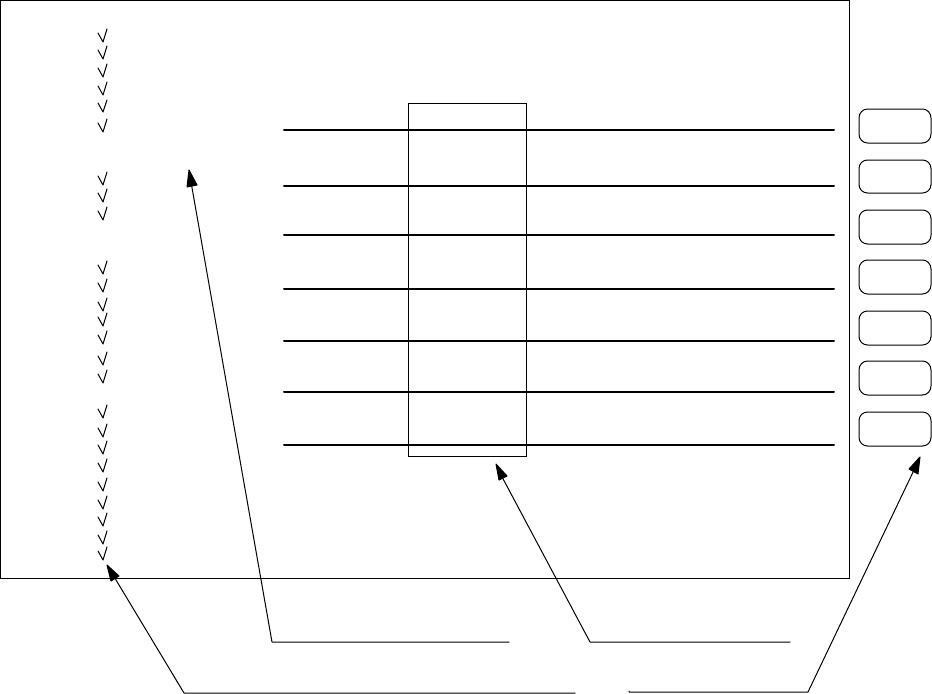
69
5.5.4.5.1 Changing the settings of soft keys (KEY ASSIGN)
Conducting alterations and new settings for the functions of keys with number displays of 1-7.
(1) Screen display for the setting
When KEY ASSIGN has been selected with the up-down cursor keys from among the CUSTOM
items and the "ENT" key is pressed, the setting screen is displayed. (See chart below)
(2) Selecting functions
Reverse the items to be set using the up-down cursor keys. (The items become reverse in
accordance with the moving cursor.)
(3) Key settings
(3)-1 Making new settings (Example 1)
For allocating the selected item to a soft key, press the key to be allocated. The selected
item will be displayed beside the key, which indicates that the setting has been conducted.
(3)-2 Changing the function of a key with an preset function (Example 2)
When the allocated key is pressed, its function will be altered to the one selected in (1)
above and the previous function will be canceled.
The current settings for SET1-4 will be displayed below NEXT. In order to switch the
settings SET1-4, use the right-left cursor keys. (Double settings (setting 1 item for more
1
5
6
7
4
3
2
KEY ASSIGNMENT
EBL1 EBL2 RINGS PPI
VRM1 VRM2 TUNE PPI/3D
VAR RNG FL EBL2 ST PPI/PPI
TRACK FL VRM2 ZOOM PPI/NAV
TARGET GZ SLEEP ALL PPI
SEL WIN OFF-C PICTURE ALL PPI2
NEXT NEXT NEXT NEXT
SET1 SET2 SET3 SET4
MARK @
EBL1
@
VRM1
@
EBL2
@
VRM2
@
FL EBL2
@
FL VRM2
@
HDG OFF
@
///CSR
@
RINGS
@
VAR RNG
@
TARGET
@
+MK LINE
NAV @
MODE
@
GZ
@
OFF-C
@
SLEEP
ECHO @
TUNE
@
ST
@
TRACK
@
ZOOM
@
S^
L
SETUP @
SEL WIN
@
PICTURE
@
PPI
@
PPI/3D
@
PPI/PPI
@
PPI/NAV
@
ALL PPI
@
ALL PPI2
@
NEXT
Key Groups
Move with up-down cursor Move with right-left cursor
Mark is displayed when the function is set to a key. Operation panel Keys 1 - 7
Soft Key Setting Screen
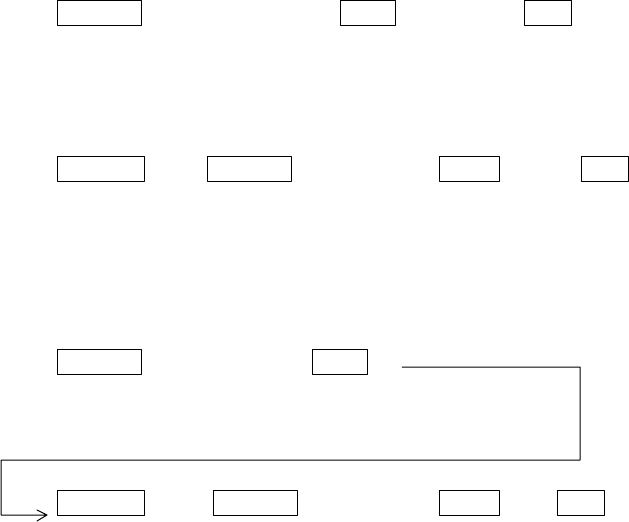
70
than 1 key) are possible.)
When settings are to be conducted for more than 1 key, repeat the operations (3)-1 to (3)-2.
(Example 3)
(4) Completing the setting
After the setting has been finished, press the ENT key to exit from KEY ASSIGNMENT.
Example of an operation
(The process up to the selection of KEY ASSIGNMENT from the SETUP menu is omitted. Only
the process after the above chart will be described.)
Example 1) Altering OFF-C allocated to key 6 in setting 2 to HDG OFF.
Up/Down → 6 →ENT ----------------------------Key 6 altered from
Select HDG OFF The display beside key 6 Exit from OFF-C to HDG OFF
changes to HDG OFF KEY ASSIGNMENT
Example 2) Re-allocate SEL WIN to key 1 in setting 2.
Left/Right → Up/Down → 1 →ENT -------------------Key 1 in setting 2
select SEL WIN SEL WIN is displayed Exit from is altered to SEL WIN
From SET1 beside key 1. KEY ASSIGNMENT
to SET2
Example 3) Alter key 1 in setting 1 from ST to HDG OFF and then reset key 1 in setting 2 as SEL WIN.
Up/Down → 6 -------------- Key 6 altered from
Select HDG OFF The display beside key 6 ST to HDG OFF
changes to HDG OFF
Left/Right →Up/Down → 1 →ENT ----------------------------Key
Select SEL WIN SEL WIN is displayed Exit from is altered to SEL WIN
From SET1 beside key 1. KEY ASSIGNMENT
to SET2
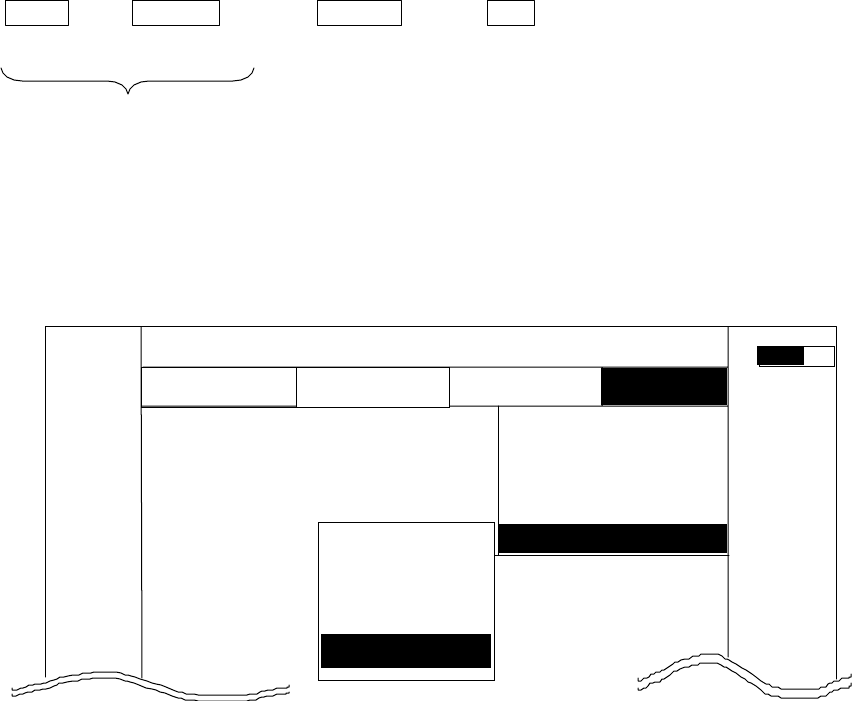
68
5.5.4.5 Changing the content of the setting (CUSTOM)
Note) Items in CUSTOM are for conducting settings and adjustments at the time of installation,
which need not be conducted normally.
-Common operations for CUSTOM
Use the up-down cursor keys to select CUSTOM after ”the common operations for the SETUP”
menu, and press either the "ENT" key.
MENU •→Left/Right →Up/Down →ENT
(Select SETUP) (Select CUSTOM)
Common operation for SETUP
When the above operations have been conducted, 4 items, namely "KEY ASSIGN", "PRESET1",
"PRESET2" and "ADJUST", are displayed beside the CUSTOM item.
Further explanation concerning the CUSTOM menu items will be done on the assumption that the
above "common operations for CUSTOM" have already been conducted.
CUSTOM >
SETUP WINDOW >
SEL WIN >
PICTURE >
SYSTEM CHECK
.75
.25
HU S
k
NAV ECHO SETUP
SETUP
>>>
0.23NM
A
T
KEY ASSIGN
PRESET1
PRESET2
NMEA PRESET
ADJUST >
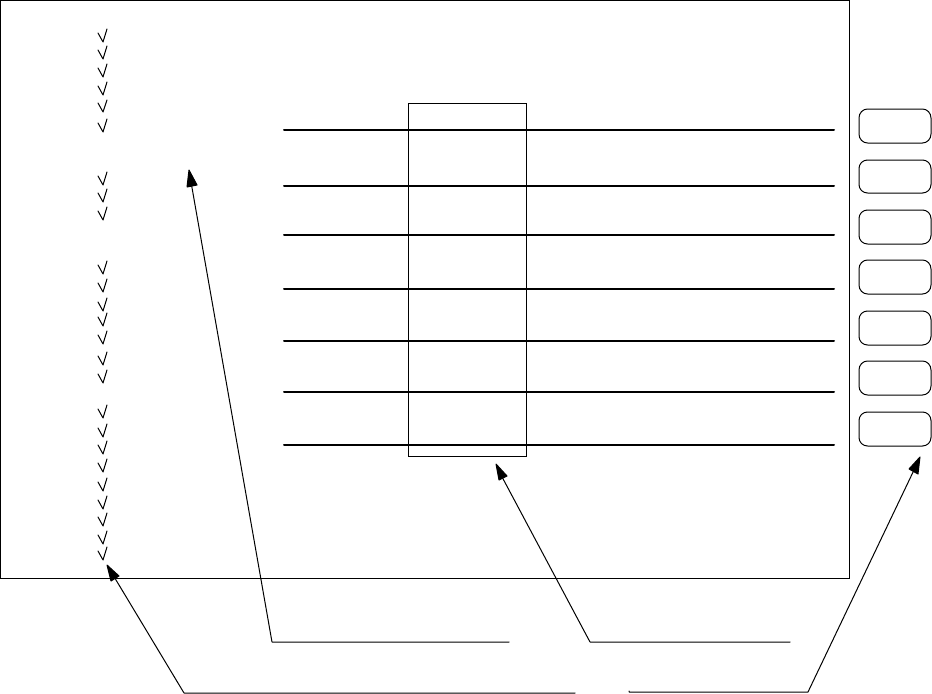
69
5.5.4.5.1 Changing the settings of soft keys (KEY ASSIGN)
Conducting alterations and new settings for the functions of keys with number displays of 1-7.
(1) Screen display for the setting
When KEY ASSIGN has been selected with the up-down cursor keys from among the CUSTOM
items and the "ENT" key is pressed, the setting screen is displayed. (See chart below)
(2) Selecting functions
Reverse the items to be set using the up-down cursor keys. (The items become reverse in
accordance with the moving cursor.)
(3) Key settings
(3)-1 Making new settings (Example 1)
For allocating the selected item to a soft key, press the key to be allocated. The selected
item will be displayed beside the key, which indicates that the setting has been conducted.
(3)-2 Changing the function of a key with an preset function (Example 2)
When the allocated key is pressed, its function will be altered to the one selected in (1)
above and the previous function will be canceled.
The current settings for SET1-4 will be displayed below NEXT. In order to switch the
settings SET1-4, use the right-left cursor keys. (Double settings (setting 1 item for more
1
5
6
7
4
3
2
KEY ASSIGNMENT
EBL1 EBL2 RINGS PPI
VRM1 VRM2 TUNE PPI/3D
VAR RNG FL EBL2 ST PPI/PPI
TRACK FL VRM2 ZOOM PPI/NAV
TARGET GZ SLEEP ALL PPI
SEL WIN OFF-C PICTURE ALL PPI2
NEXT NEXT NEXT NEXT
SET1 SET2 SET3 SET4
MARK @
EBL1
@
VRM1
@
EBL2
@
VRM2
@
FL EBL2
@
FL VRM2
@
HDG OFF
@
///CSR
@
RINGS
@
VAR RNG
@
TARGET
@
+MK LINE
NAV @
MODE
@
GZ
@
OFF-C
@
SLEEP
ECHO @
TUNE
@
ST
@
TRACK
@
ZOOM
@
S^
L
SETUP @
SEL WIN
@
PICTURE
@
PPI
@
PPI/3D
@
PPI/PPI
@
PPI/NAV
@
ALL PPI
@
ALL PPI2
@
NEXT
Key Groups
Move with up-down cursor Move with right-left cursor
Mark is displayed when the function is set to a key. Operation panel Keys 1 - 7
Soft Key Setting Screen
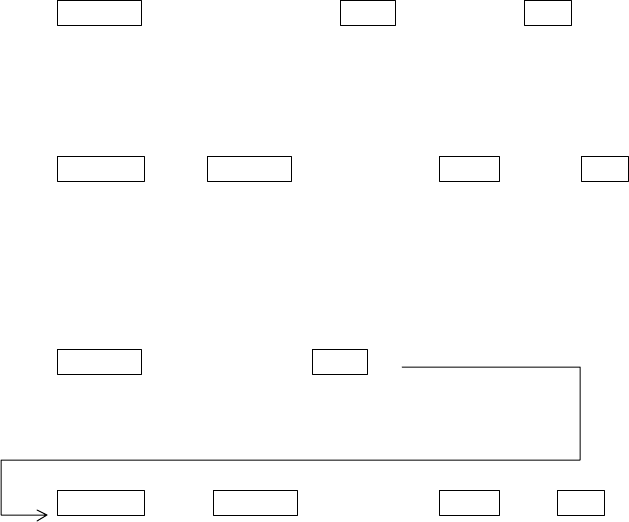
70
than 1 key) are possible.)
When settings are to be conducted for more than 1 key, repeat the operations (3)-1 to (3)-2.
(Example 3)
(4) Completing the setting
After the setting has been finished, press the ENT key to exit from KEY ASSIGNMENT.
Example of an operation
(The process up to the selection of KEY ASSIGNMENT from the SETUP menu is omitted. Only
the process after the above chart will be described.)
Example 1) Altering OFF-C allocated to key 6 in setting 2 to HDG OFF.
Up/Down → 6 →ENT ----------------------------Key 6 altered from
Select HDG OFF The display beside key 6 Exit from OFF-C to HDG OFF
changes to HDG OFF KEY ASSIGNMENT
Example 2) Re-allocate SEL WIN to key 1 in setting 2.
Left/Right → Up/Down → 1 →ENT -------------------Key 1 in setting 2
select SEL WIN SEL WIN is displayed Exit from is altered to SEL WIN
From SET1 beside key 1. KEY ASSIGNMENT
to SET2
Example 3) Alter key 1 in setting 1 from ST to HDG OFF and then reset key 1 in setting 2 as SEL WIN.
Up/Down → 6 -------------- Key 6 altered from
Select HDG OFF The display beside key 6 ST to HDG OFF
changes to HDG OFF
Left/Right →Up/Down → 1 →ENT ----------------------------Key
Select SEL WIN SEL WIN is displayed Exit from is altered to SEL WIN
From SET1 beside key 1. KEY ASSIGNMENT
to SET2
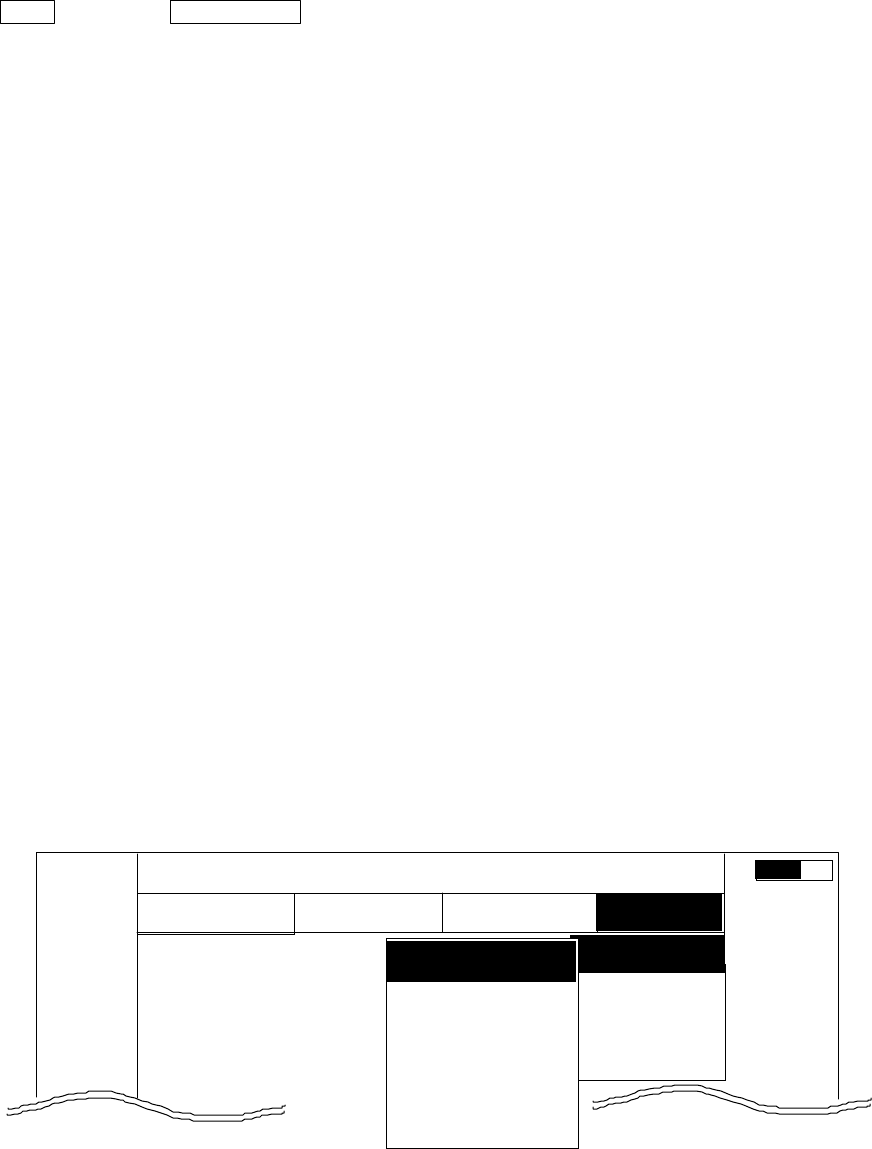
61
5.5.4 SETUP Menu
To be used for various settings and switching of the screen
•Common operations for the SETUP menu (Up to the point when "SETUP" menu is selected
from the main menu)
Press the "MENU" key and select "SETUP" from the displayed 4 main menus using the left-
right cursor. (The contents of the selected MENU will appear on a pull-down display in
accordance with the movement of the left-right cursor.)
MENU •••→• Left/Right
(Select SETUP)
When the above-mentioned operations have been conducted, the items of the SETUP menu
are vertically displayed. Further explanation about the SETUP menu will be conducted on the
assumption that this "common operation for the SETUP menu" has already been completed.
5.5.4.1 Initiating the screen display (WINDOW)
A function to switch the display method of the screen. A selection can be made from
among the 7 patterns of screen arrangements, from the ordinary PPI display to the 2-screen
PPI display, etc.
a) PPI screen
b) PPI screen & SEMI3D screen
c) PPI screen & PPI screen (Range can be operate in each screen.)
d) PPI screen & Navigation screen
e) All PPI screen (PPI, all the screen display.)
f) All PPI screen & All PPI screen(PPI & PPI, all the screen display.)
g) MOB screen
(1) Use the up-down cursor keys to select WINDOW from among the pull-down display items,
and press the "ENT" key.
(2) Select a screen to be displayed with the up-down cursor keys from among the above 7
items that are displayed beside the WINDOW item.
(3) The setting will be completed when the "ENT" key is pressed after the selection.
MARK
WINDOW >
SEL WIN >
PICTURE >
SYSTEM CHECK
CUSTOM >
. 75
.25
HU NAV ECHO SETUP
SEMI3D / PPI
PPI / PPI
PPI / NAV
ALL PPI
ALL PPI/PPI
MOB
•••••
SETUP
•
>>>>
•0.23NM
A

62
Up/Down →ENT →Up/Down →(Select PPI• →ENT •a•
•select WINDOW• →(Select PPI+SEMI3D•
→ENT •b•
→(Select PPI+PPI• →ENT •c•
→(Select PPI+NAV• →ENT •d•
→(Select ALL PPI• →ENT •e•
→(Select ALL PPI+PPI• →ENT
•f•
→(Select MOB• →ENT •g•
-Limitation of screen operation
SCREEN
ITEM
••• PPI/SEMI3D
PPI/NAV
PPI•PPI ALL PPI ALL PPI PPI MOB
RANGE •••••×
VRM1•EBL1 •••×××
VRM2•EBL2 •••×××
FL VRM2•EBL2 •×ו×××
RINGS ON/OFF •••••×
ZOOM•OFF CENT •×××××
///CSR •••••×
HDG OFF •••×•×
STERN M •••••×
NORTH M •••••×
GAIN•STC•FTC •••×××
TUNE •••×××
ST •••×××
GZ •••×××
SEL WIN ×וו×
TXON/OFF •••••×
• • Independent control at time as two screen.•Switching the screen is necessary (SEL WIN)•
• • It becomes simultaneous control at the time as two screen.
• • It can be used only at the time of PPI screen.
× • It can’t be used.
- Screen modes and Operations
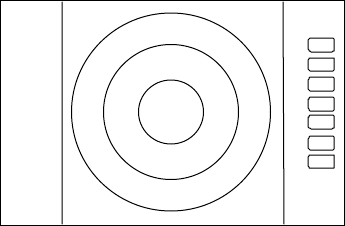
63
(a) PPI Screen
All functions can be used on this screen.
D‚V‚T
D‚Q‚T
‚g‚t
{
PPI S creen
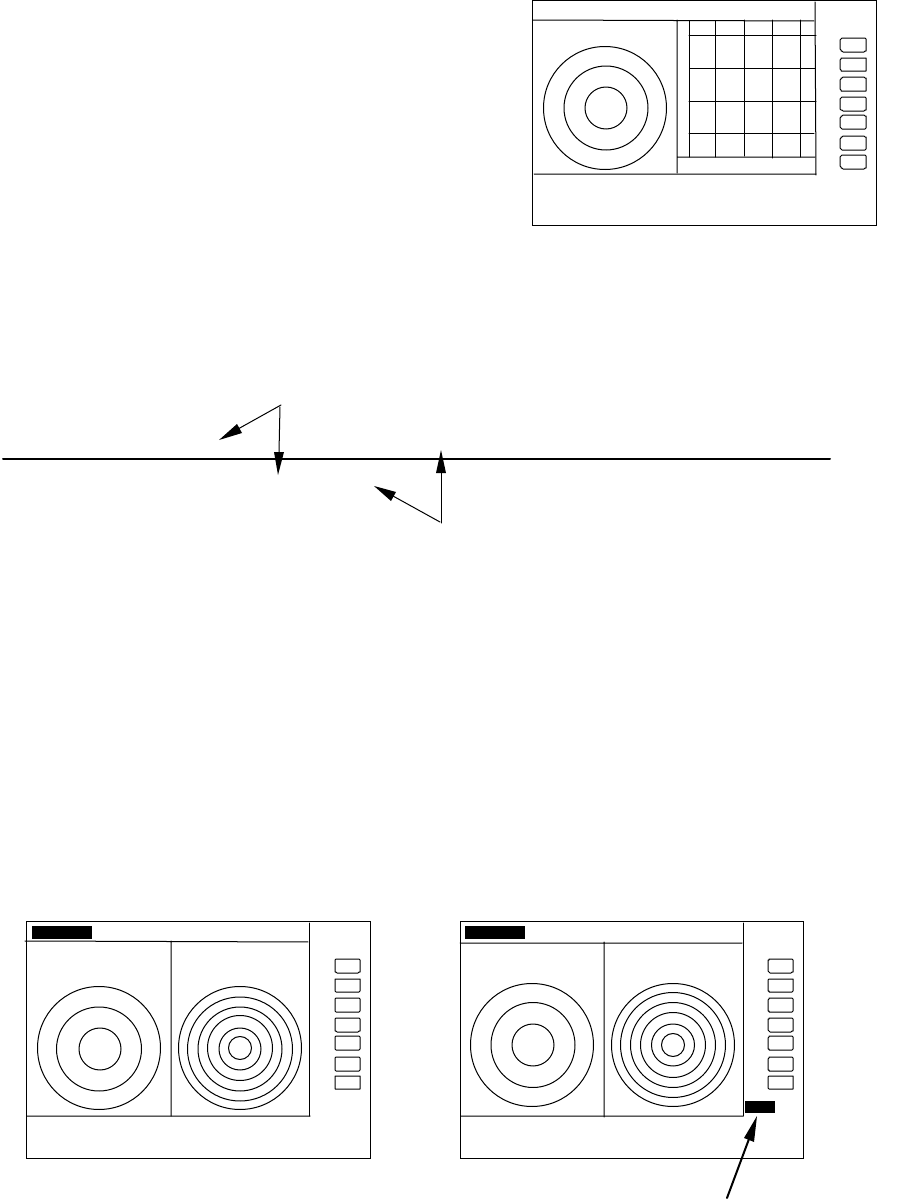
64
(b) PPI/SEMI3D Screen
It becomes simultaneous control at the time as
two screen.
Note: All controls, such as EBLs, VRMs effects both
screen.
The ZOOM, OFF-C, FL EBL2, and FL VRM2 could
not be used on this mode. The "SEMI3D" screen
displays the center as ship's heading always.
(c) PPI/PPI Screen
The radar picture is refreshed two antenna scanning for each PPI screen. Un-
refreshed screen picture is holded during the time.
Note: The radar picture is refreshed with two scanning interval for each screen. Right
screen picture is holded during refreshing left screen, left screen holded during
refreshing right screen. When your ship navigates in high speed, use PPI screen to
get fast refreshing picture.
Note: Functions ZOOM, OFF-C, FL-EBL2, and FL-VRM2 can not be used on this screen.
Note: The function RANGE, GAIN, STC, FTC, and GZ can be used for each screen
independently. The screen selected in "SEL WIN" that the range indicator displayed in
reverse can be controlled.
Note: The cross cursor displayed only on selected screen.
-Operation
a) Changing RANGE of LEFT screen
1) When the RIGHT range indicator displayed in reverse, change to LEFT screen with
"SEL WIN" function.
2) Press ”RANGE UP” or ”RANGE DOWN” key to change the LEFT screen RANGE.
D‚V‚T
D‚Q‚T ‚g‚t ‚r
{
280 320 000 040 080
PPI/SEM I3D Screen
LEFT screen /--------/*******/--------/******/--------/****** t→
→→
→
RIGHT screen ******* /--------/******/--------/******/--------/
picture drawing(refreshed)
displayed previous picture ( hold)
.75 .
25 HU S 24 6
{
G 55/35
S 35/AT
F 35/AT
LEFT screen selected
.75 .
25 HU S 24 6
{
G 55/35
S 35/AT
F 35/AT
GAIN adjustm ent for LEFT screen
L e ft GAIN indicates in reverse
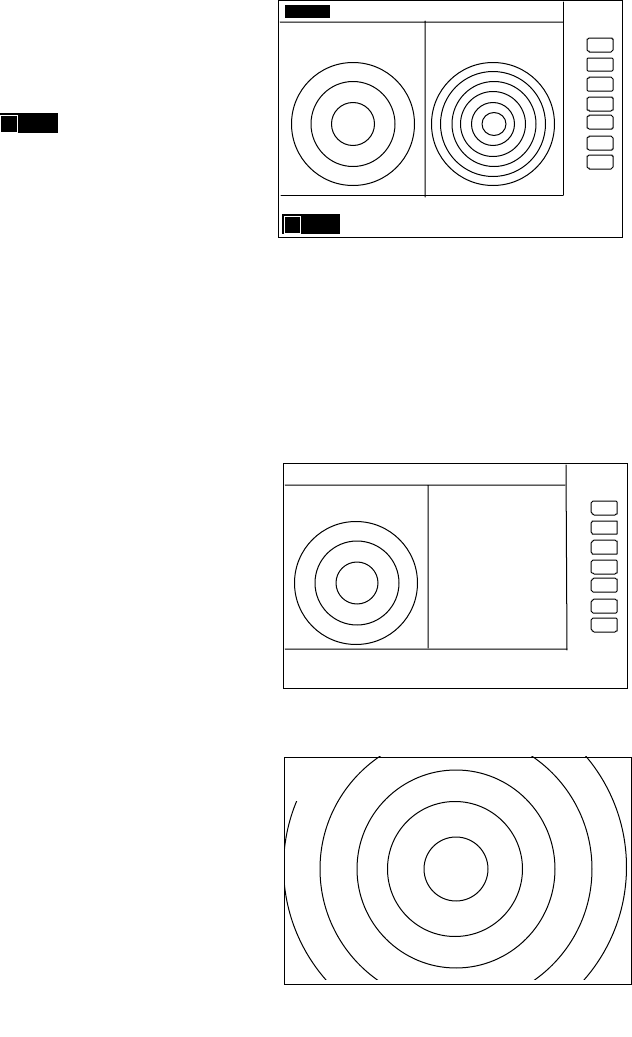
65
b) Adjusting GAIN of LEFT screen.
1) When the RIGHT range indicator displayed in reverse, change to LEFT screen with
"SEL WIN" function.
2) Press the "GAIN" key, "G50" will displayed in reverse and ready for adjusting GAIN.
3) Adjust GAIN with the control knob.
Adjust STC and FTC in a same manner as GAIN.
Note: During adjustment of GAIN, STC, or FTC, radar picture refreshing is fixed to the
adjusting screen. Approximately 5 seconds errapsed after adjustment, radar picture
refreshing is return to normal.
c) Determining the distance with VRM1 on LEFT
screen.
1) When the RIGHT range indicator is displayed in
reverse, change to LEFT screen with "SEL WIN"
function.
2) Press the "VRM1" key, " " will be displayed in
reverse and ready for adjusting VRM1.
3) Determining the distance with the control knob.
Note: If operate the VRM1 on the RIGHT screen, VRM1
will move to the RIGHT screen.
Operate VRM2, EBL1, or EBL2 in a same manner as VRM1.
(d) PPI/NAV Screen
Note: The ZOOM, OFF-C, FL EBL2, and FL VRM2
can not be used on this screen.
(e) ALL PPI Screen
Note1: The RANGE, RINGS interval, and Display mode are
displayed on the upper-left of the screen.
Note2: When press the key except "MENU", "RANGE
UP/DOWN", "BRILL", and "POWER", return to PPI
screen.
G 55/35
S 35/AT
F 35/AT
1 0.00N M
Determining the distance with VRM1
on LEFT screen
.75 .25 HU S 6 1
{
D‚V‚T
D‚Q‚T ‚g‚t ‚r
{
NAV DISPLAY
WAY P 123.4 ‹
6.8 ‚m‚l
COURSE 2.38NM
XT E <<<
HDG 267.3 ‹
T
SPD 12.8KT
TEMP 20.8 ‹
C
DEPTH 58.3M
LAT/LON
34 ‹
08 D
22N
138 ‹
02 D
53E
PPI/NAV screen
{
. 75
. 25
HU S
ALL PPI screen
1 0.00NM
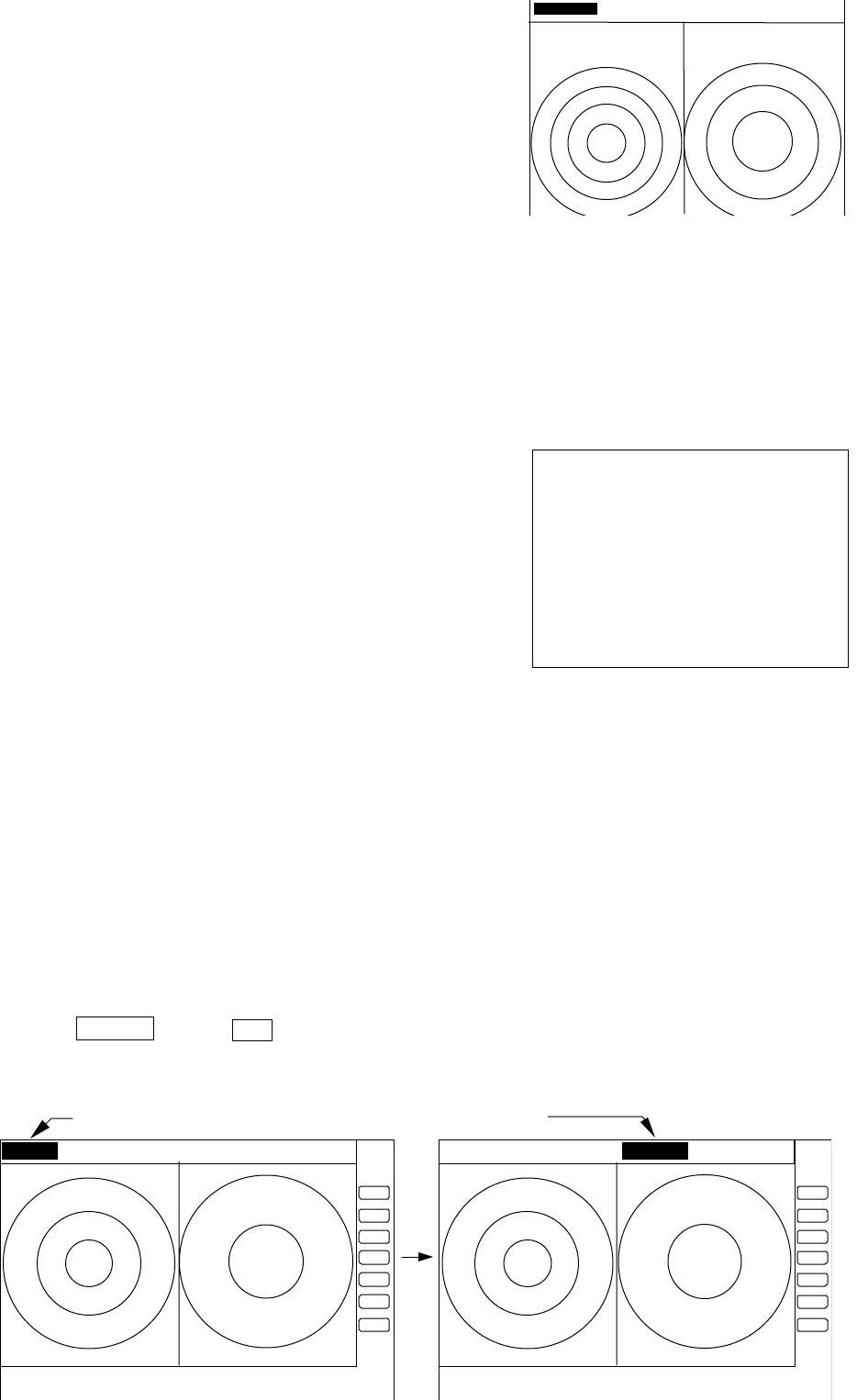
66
(f) ALL PPI/PPI Screen
Note1: The RANGE, RINGS interval, and Display mode
are displayed on the top of the screen.
Note2: When press the key except "MENU", "RANGE
UP/DOWN", "BRILL", and "POWER", return to
PPI/PPI screen.
Note3: The radar picture is refreshed with two
scanning interval for each screen. Right screen
picture is holded during refreshing left screen, left
screen holded during refreshing right screen. When
your ship navigates in high speed, use PPI screen to
get fast refreshing picture.
(g) MOB Screen
The MOB key has been pressed, the MOB position and
ship's position are displayed. If not, MOB position will be
displayed with bars( --.- )
Press MOB key to clear the MOB position and return
to previous screen. Press ENT key to return previous
screen with keeping the MOB position data.
5.5.4.2 Switching screens on PPI/PPI screen ( SEL WIN )
Switching to the desired screen for activation on a PPI/PPI screen display.
The "SEL WIN" function is switches the activated screen to effect the operation such as,
RANGE, GAIN, STC, FTC, VRM1/2, EBL1/2, and guard zone. The range indicator of activated
screen is displayed in reverse.
When "SEL WIN" is selected with the up-down cursor keys from among the pull- down
display items and the "ENT" key is pressed, activated screen will be changed to the opposite
screen.
Up/Down →••• ......................................................the opposite screen activated
•select SEL WIN•
D‚V‚T
D‚Q‚T ‚g‚t ‚r D‚Q‚T
D‚P‚Q‚T
{
ALL PPI PPI screen
MAN OVERBOARD
MOB POS
35 ‹
08 D
42N
139 ‹
03 D
33E
SHIP’S POS
37 ‹
12 D
42N
142 ‹
04 D
33E
PRESS MOB KEY TO DATA CLEAR
PRESS ENTER KEY TO RETURN
Range display on the active screen become a reverse display
.75 .25 S .5 .25 .75 .25 HU S .5 .25 .
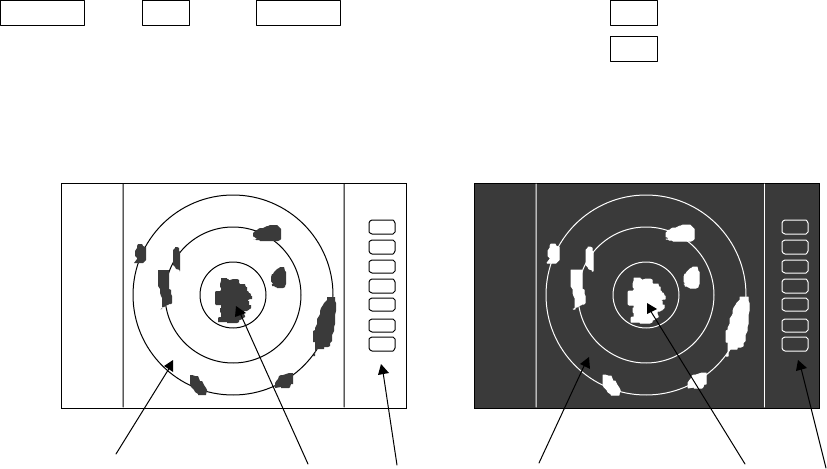
67
5.5.4.3 Changing the color of screen (PICTURE)
Changing the color of screen depending on weather and day / night environment
conditions will be effective for easy viewing .
When "PICTURE" is selected with the up-down cursor keys from among the pull- down
display items, select "DAY" and press "ENT" key to set to day display. Night display appears if
"NIGHT"
is selected
Up/Down →ENT →Up/Down →(select DAY•→ENT → day display
•select PICTURE•→(select NIGHT•→ENT → night display
βλυε ψελλοω ωηιτε βλαχκ γρεεν ρεδ
5.5.4.4 Fault Diagnosis by Self Check •SYSTEM CHECK)
Verifying the problem point by SYSTEM CHECK when, for example, some abnormality has
occurred.
(1) Select SYSTEM CHECK from the pull-down display items using up-down cursor key, and
press the “ENT” key.
(2) The system check screen will appear.
While watching the screen , check the following:
i) Whether all items are marked “OK”. (If any item is marked “NG”, the indicated location
may be faulty.)
ii) Press a front-panel key and see if the corresponding display on the screen is
highlighted.
iii) Turn the control knob and see if the lower-right indicator move to right or left.
(3) Press the POWER key to return to the previous screen
DAY display NIGHT display
75
. 25
HU
. 75
. 25
HU
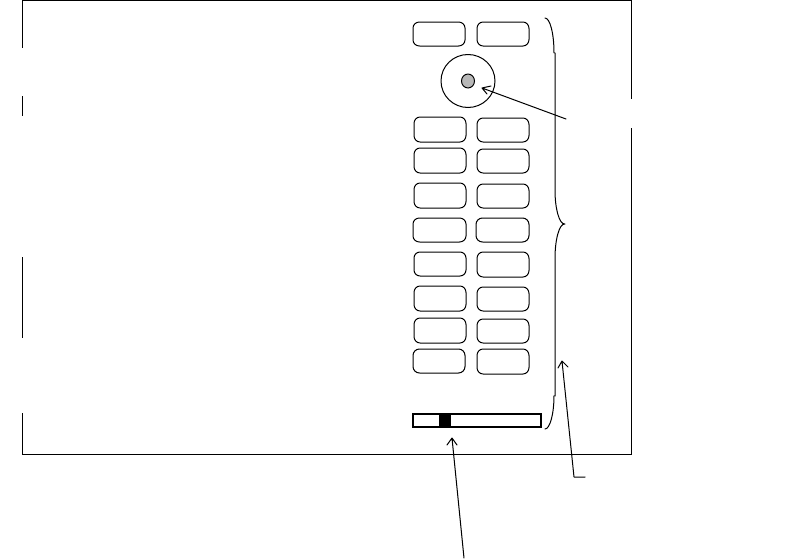
68
a) ROM----------------------------- Indicates the ROM status.
b) RAM -------------------------------- Indicates the RAM status.
•• Backup memory-------------- Indicates the backup memory status.
•• Transmit trigger ------------- Indicates the signal line status for the trigger signal sent from the scanner
unit.
e• Bearing pulse------------------ Indicates the signal line status for the bearing signal sent fron the scanner
unit.
f) Heading pulse------------------- Indicates the signal line status for the bow signal sent from the scanner unit.
g) +5V voltage---------------------- Indicates the reference voltage status of the video circuit and its voltage
value.
(at video circuit) (normally about 5 V)
h) High voltage(at SU)---------- Indicates the status of th high voltage supplied from the display unit to the
scanner unit and its voltag value (normally about 250 V) at scanner unit.
i) High voltage(at DU) ---------- Indicates the status of th high voltage supplied from the display unit to the
scanner unit and its voltag value (normally about 250 V) at display unit.
j) Magnetron current----------Indicates the status of the anode current flowing in the magnetron and its
current value.
k) Tuning voltage -------------- Indicates the status of the voltage used for tunning and its voltage value.
l) Cumulative usage time ---- Indicates the cumulative time your radar is used.
OPERATE : Duration of time during which the power supply is turned on.
TRANSMIT : Duration of time transmitting.
m) ROM version ---------------- Indicates the ROM software version.
n) Front-panel keys------------ As you press any front-panel key when the SYSTEM CHECK screen is on,
the corresponding key is highlighted on the screen by displaying it in reverse
video.
RNG U
RNG D
BRILL
AUTO
GAIN
STC
FTC
1
2
3
4
5
6
7
MOB
POWER
n)Indicates the operation
s
tatus of front-
p
anel ke
y
SYSTEM CHECK screen
ENTMENU
Indicates the control knob status.
Indicates the cursor status.
CONTROL KNOB
SYSTEM CHECK
MEMORY CHECK
a) ROM --------------------------------------- > ROM OK
b) RAM---------------------------------------- > RAM OK
c) Backup memory----------------------- > BACKUP OK
SIGNAL CHECK
d) Transmit trigger ----------------------- > (1) TRIGGER OK
e) Bearing pulse -------------------------- > (2) AZIMUTH OK
f) Heading pulse -------------------------- > (3) HM OK
g) +5Vvoltage(at video circuit)------> (4) +5V OK 5.2V
h) High voltage(at scanner) ---------- > (5) H.T. AT SU OK 253.2V
i) High voltage(at display)------------- > (6) H.T. AT DU OK 253.2V
j) Magnetron current--------------------- > (7) MAG. CUR. OK 2.1
k) Tuning voltage------------------------- > (8) TUNE OK
l) Cumulative usage time-----------> HOURMETER
Operation time --------------------- > OPERATE 12.0H
Transmit time ---------------------- > TRANSMIT 10.3H
m) ROM version -----------------------> ROM VERSION V1.00
PRESS POWER KEY TO RETURN
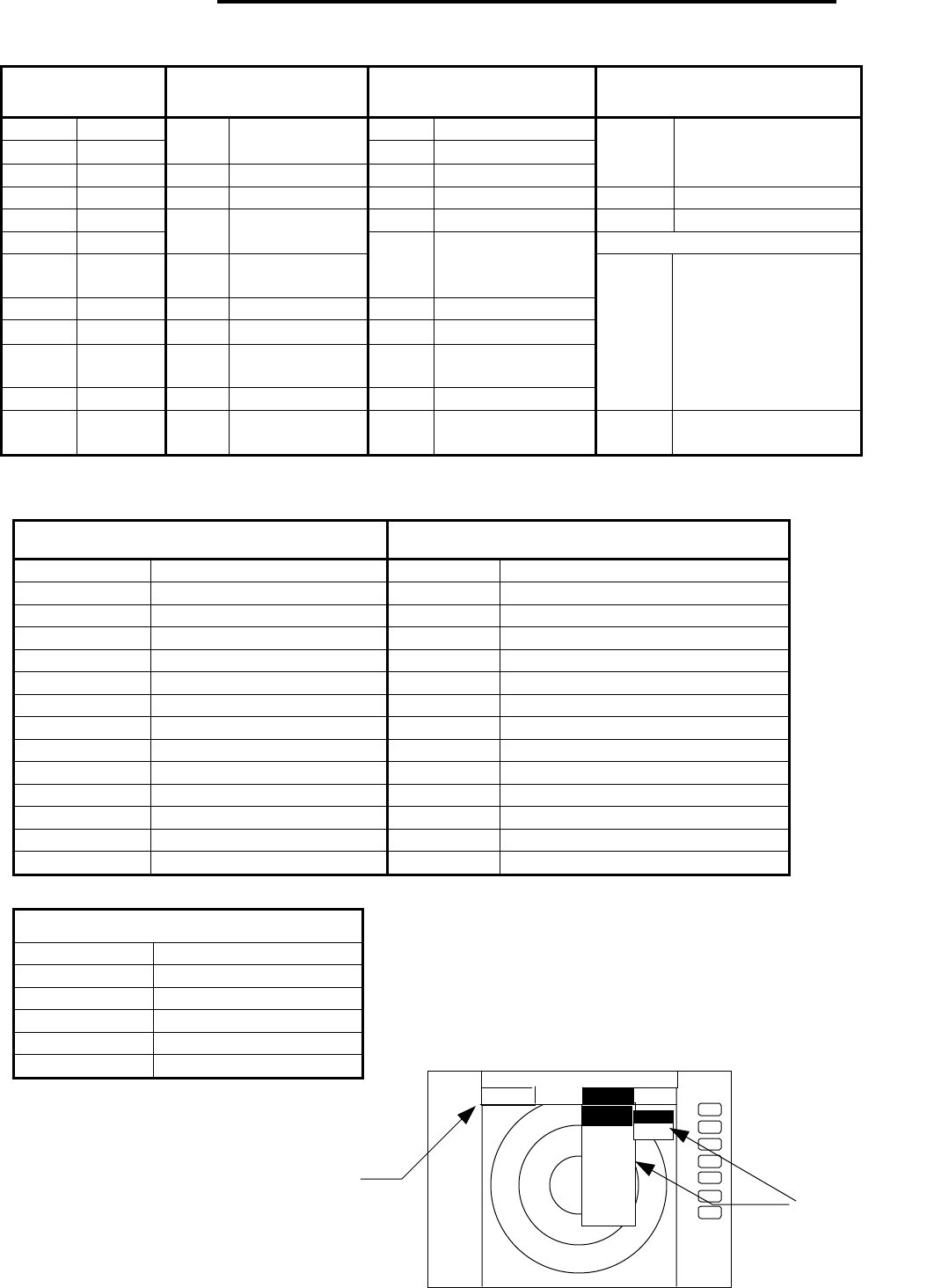
45
5.5 MENU Operation
List of MENU
List of Main Menu
MARK
(MAIN-MENU) NAV
(MAIN-MENU) ECHO
(MAIN-MENU) SETUP
(MAIN-MENU)
EBL1 ON/OFF GAIN AUTO/MAN
VRM1 ON/OFF
MODE HU/HS/NU/CU/TM
•MANU/NMEA•STC AUTO/MAN/HARBOR
EBL2 ON/OFF GZ ON/OFF FTC AUTO/MAN
WINDOW PPI/SEMI3D+PPI/
PPI+PPI/PPI+NAV/
ALLPPI/ALL PPI+PPI/MOB
VRM2 ON/OFF OFF-C ON/OFF TUNE AUTO/MAN SEL WIN
FL EBL2 ON/OFF ST OFF/ST1/ST2 PICTURE DAY/NIGHT
FL VRM2 ON/OFF
SLEEP OFF/5min/10min/
15min SYSTEM CHECK
HDG
OFF
OFF
TRACK OFF/15SEC/30SEC/
1MIN/3MIN/6MIN/
CONT
///CSR ON/OFF ZOOM ON/OFF
RINGS ON/OFF SL SHORT/LONG
VAR
RNG
ON/OFF
TARGE T
CUSTO
M
KEY ASSIGNMENT
PRESET1 (SUB-MENU)
PRESET2 (SUB-MENU)
ADJUST (SUB-MENU)
+MK
LINE
ON/OFF
List of Custom Menu
PRESET1 (SUB-MENU) PRESET2 (SUB-MENU)
HM FLSH ON/OFF GZ LEVEL 1-7
STERN M ON/OFF GZ MODE IN/OUT
NORTH M ON/OFF HOLD ON/OFF
ST’BY NAVI/NOR DISPLAY RDR/MONI/NAV
BUZ VOL OFF/LOW/HIGH EXT BUZ OFF / CONT / INT
RM UNIT NM / KM / SM IN P/R 1080/1024/2048/4096/360
DEPTH M / FT / FM OUT P/R 1080/1024/2048/4096/360
TEMP °C / F DEMO ON / OFF
EBL BRG REL / TRUE / MAG IR OFF / IR1 / IR2
WP BRG TRUE / MAG SPD SET NMEA / MANU 0.0 KT
HEAD INPUT NMEA / SIN•COS /12BIT / 10BIT LANGUAGE 15 countries
HEAD TRUE / MAG SCAN SPEED STD / HIGH
+MK MODE DIST/BRG•/•LAT/LON
P TABLE 0 - 2
ADJUST (SUB-MENU)
TIMING ADJ
HEAD ADJ
TUNING CAL.
ANTENNA 1-9
GAIN 1-30
STC 1-16
+
ST’BY
.75
. 25
HU
STC >
FTC >
TUNE >
ST >
TRA CK
ZOOM
S/L
MARK NAV ECHO SETUP
ECHO
GAIN > MAN
AUTO
MAIN-MENU
SUB-MENU
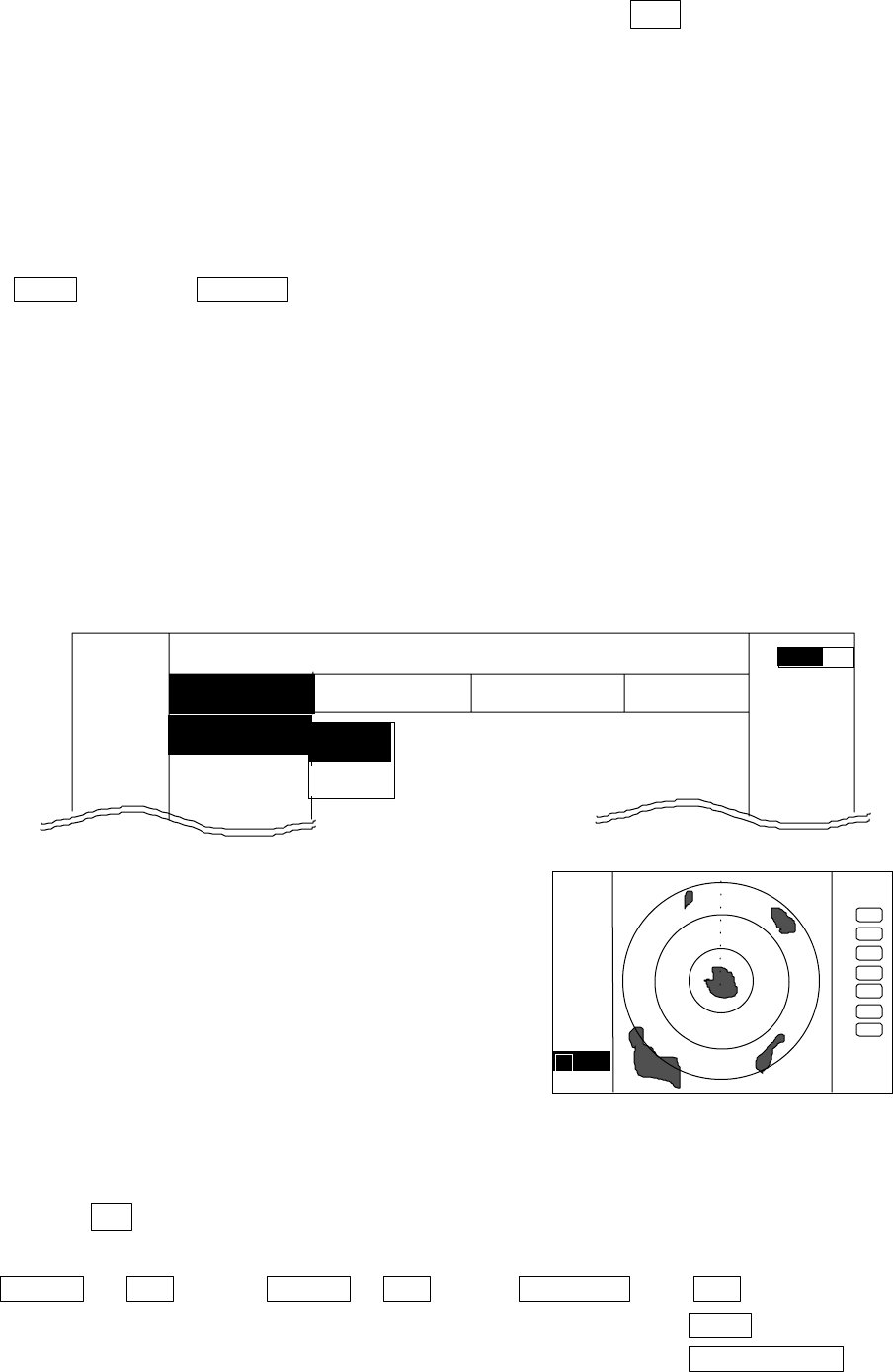
46
5.5.1 Mark Menu xxx •keys to press
Setting for markers and cursors
•Common operations for the MARK menu
(Up to the point when "MARK" menu is selected from the main menu)
Press the "MENU" key and select "MARK" from the displayed 4 main menus using the left-
right cursor. (The contents of the selected MENU will appear on a pull-down display in
accordance with the movement of the left-right cursor.)
MENU →Left/Right
(Select MARK)
Further explanation about the MARK menu will be conducted on the assumption that this
"common operation for the MARK menu" has already been completed.
5.5.1.1 Bearing measurement (EBL1)
(1) Select EBL1 from the pull-down display items using the up-down cursor key, and press the
"ENT" key.
(2) When the ON/OFF sign is displayed beside the EBL1 item, select ON with the up-down cursor
keys and press the "ENT" key.
(3) When the "ENT" key is pressed, electric bearing line
(EBL1) appears and the angle from the direction of
the ship’s head which is set at 0 degree will appear
in a reverse display at the lower left of the screen.
(4) Place the marker on the center of the target with the
control knob and read the bearing. Then, the
display setting for EBL1 will be completed either
(a)with the EBL1 display still on the screen if the
"ENT" key is pressed, or (b)without the EBL1
display if the "MENU" key is pressed. (c)Pressing
another function key will lead to the function of
that key with the EBL1 display still on the screen.
Note:• 1 xxx•xφindicates EBL1.
Up/Down → ENT →Up/Down → ENT →Control knob → ENT (a)
(Select EBL1) (Select ON) (EBL1 operation) µ>MENU (b)
µ> Other function key (c)
Note: The displayed EBL angle is relative to heading or true to north, depends on the setting
of "EBL BRG" in the "SETUP" menu.
MARK
EBL1
>
VRM1 >
EBL1 >
.75
.25
HU NAV ECHO SETUP
MARK
>>>
0.23NM
A
. 75
.25
HU
+
1 0.0°
OFF
ON
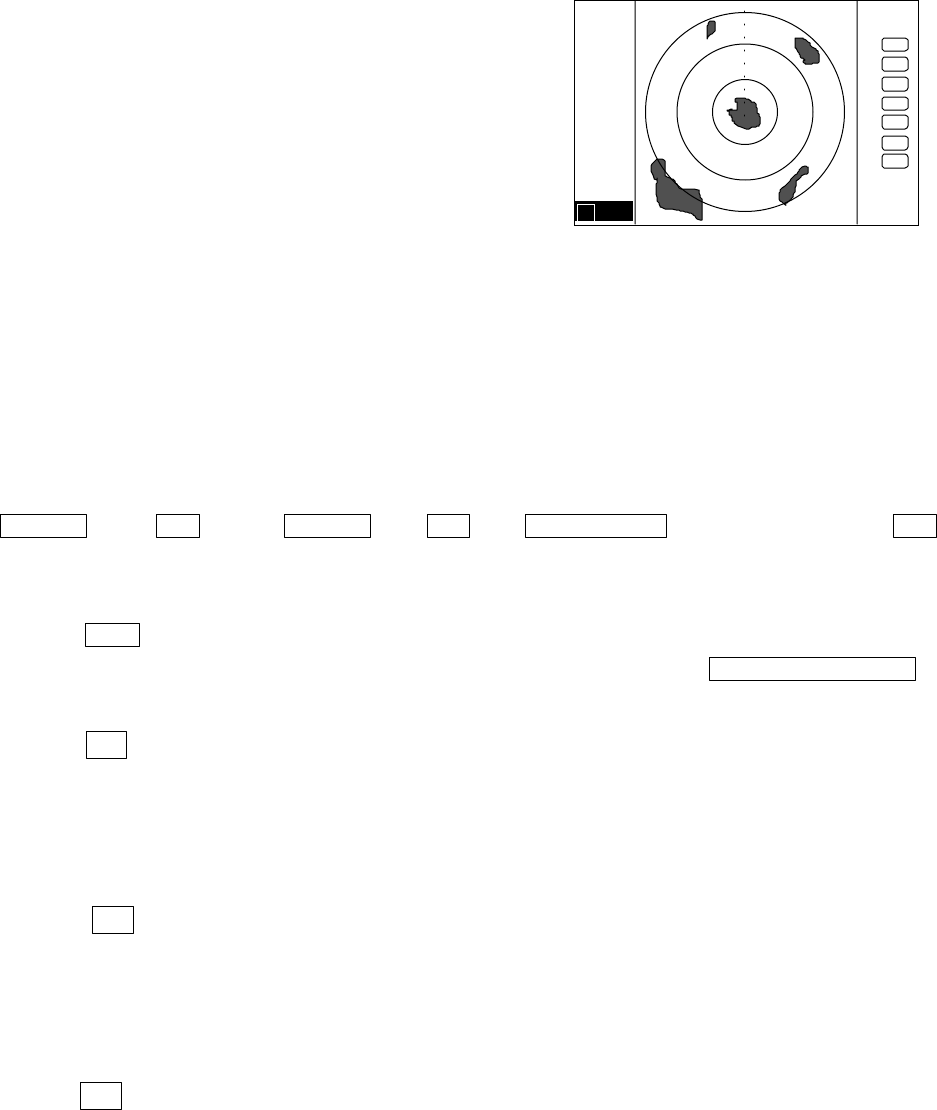
47
5.5.1.2 Determining the distance (VRM1)
(1) Select VRM1 from the pull-down display items using
the up-down cursor key, and press either the "ENT"
key.
(2) When the ON/OFF sign is displayed beside the
VRM1 item, select ON with the up-down cursor
keys and press the "ENT" key.
(3) When the "ENT" key is pressed, the variable range
marker1 (VRM1) and the distance in a reverse
display appears at the lower left of the screen (See
Note), and the display is set for VRM1.
(4) Place the marker on the front edge of the target with
the control knob and read the distance. Then, the
display setting for VRM1 will be completed either
(a)with the VRM1 display still on the screen if the
"ENT" key is pressed, or (b)without the VRM1
display if the "MENU" key is pressed. (c)Pressing
another function key will lead to the function of
that key with the VRM1 display still on the screen.
Up/Down →ENT →Up/Down →• ENT •→Control knob → ENT
(a)
(Select VRM1) (Select ON) (VRM1 operation) µ>
MENU (b)
µ>Other function key
(c)
Note: 1 xx.xx NM indicates VRM1.
5.5.1.3 Bearing measurement (EBL2)
Refer to the section “Bearing measurement (EBL1)”.
The "EBL2" will appear in a reverse display at the lower right of the screen.
Note:• 2 xxx.xφindicates EBL2.
5.5.1.4 Determining the distance (VRM2)
Refer to the section “Determining the distance (VRM1)”.
The "VRM2" will appear in a reverse display at the lower right of the screen.
Note: 2 xx.xx NM indicates VRM2.
5.5.1.5 Measuring the distance or angle between two points ( FL EBL2, FL VRM2 )
Determining the distance (VRM2)
(a) Preparation for the measurement
(1) Use the up-down cursor keys to select FL VRM2 from among the pull-down display items,
and press the "ENT" key.
(2) Use the up-down cursor keys to select ON from the ON/OFF display beside the FL VRM2
items, and press the "ENT" key. “SET START POINT” is displayed and a small cross mark
.75
.25
HU
+
1 0.00NM
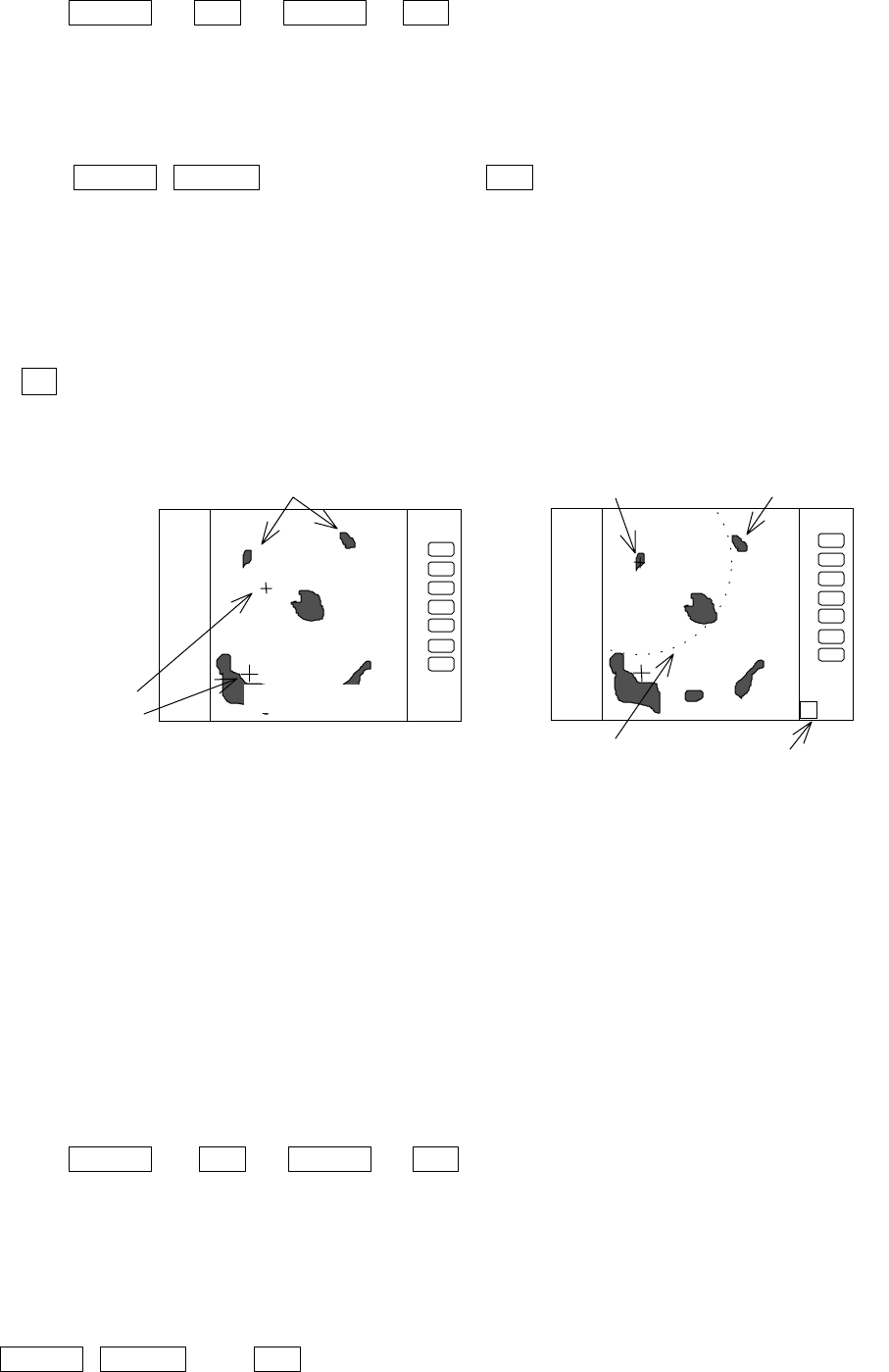
48
appears. (Once this is set, the "ON" state continues unless changes are made.)
Up/Down → ENT → Up/Down → ENT --------------------------------FL VRM2 is turned ON and
(Select FL VRM2) (Select ON) the small cross mark appears.
(b) Setting a reference point for measurement of the distance
Use the left-right and up-down cursor keys to place the small cross mark on one of the two
echoes whose distance will be measured, and press the "ENT" key.
Up/Down & Left/Right →--------------------------- ENT Criterion of the reference point is set.
(Place the cross cursor on an echo)
(c) Measuring
Perform the operations in the above mentioned "Common operation for the MARK menu"
and "measuring the distance(VRM2)", and place the VRM2 on another echo.
VRM2 is displayed on the screen around the placed fixed cross cursor.
" 2 xx. xNM" which is displayed at the lower right will be the distance between the two
points.
Note: EBL2 and VRM2 are not follow to "ZOOM" and "OFF-C" function.
5.5.1.6 Measuring the angle between two points (FL EBL2)
(a) Preparation for the measurement
(1) Use the up-down cursor keys to select FL EBL2 from among the pull-down display items,
and press the "ENT" key.
(2) Use the up-down cursor keys to select ON from the ON/OFF display beside the FL EBL2
items, and press the "ENT" key. “SET START POINT” is displayed and a small cross mark
appears. (Once this is set, the "ON" state continues unless changes are made.)
Up/Down → ENT → Up/Down → ENT --------------------------------FL EBL2 is turned ON and
(Select FL EBL2) (Select ON) the small cross mark appears.
(b) Setting a reference point for measurement of the angle.
Use the left-right and up-down cursor keys to place the small cross mark on one of the two
echoes whose angle will be measured, and press the "ENT" key.
Up/Down & Left/Right → ENT --- Criterion of the reference point is set.
(Place the cross cursor on an echo)
.75
.25
HU
2•0.72NM
place the VRM2
on another
ec
h
o
SET START POINT
.75
.25
HU
measure the
distance between
two targets
small cross
mark
FL VRM2 indication
of VRM2
center of
VRM2
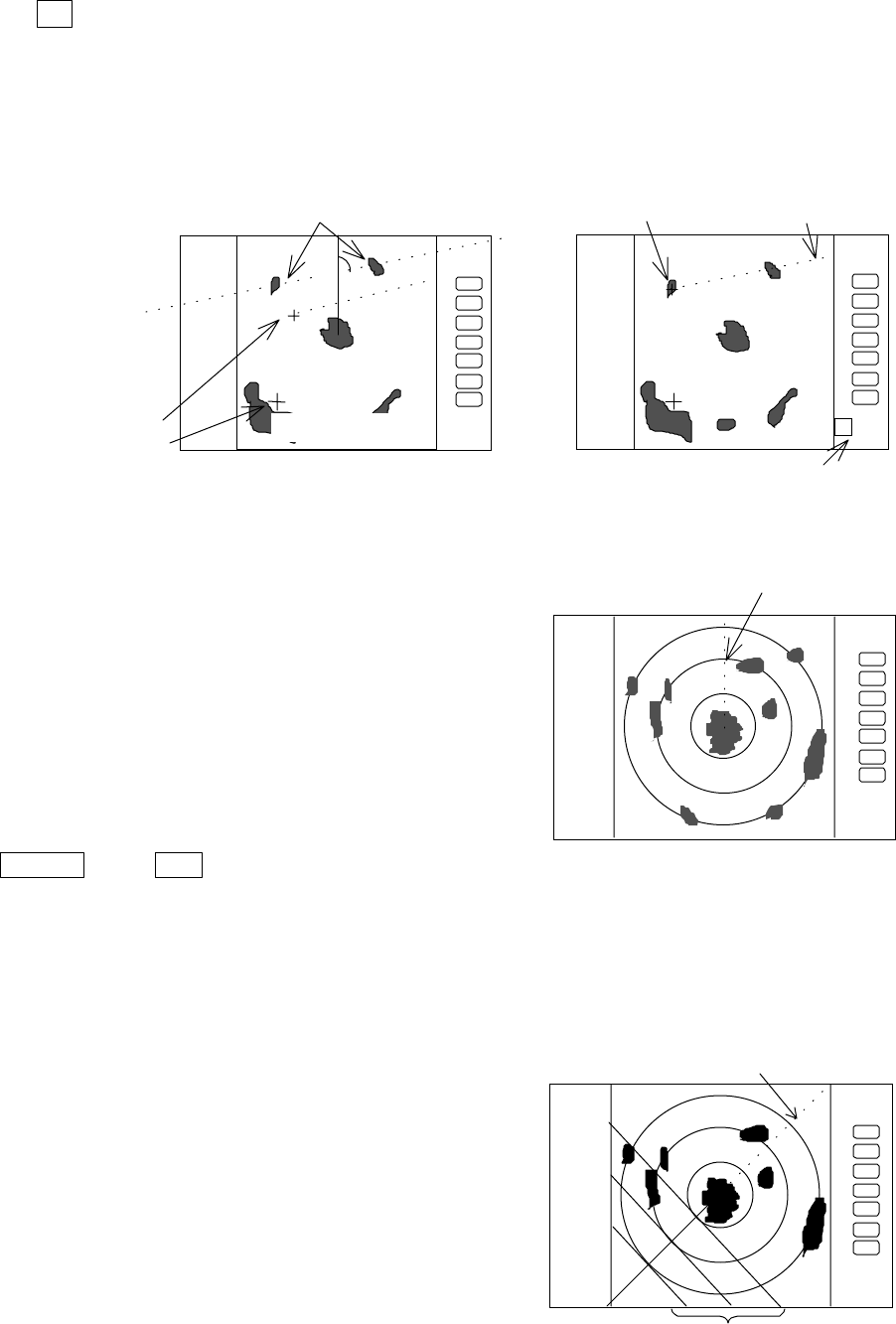
49
(c) Measuring
Perform the operations in the above mentioned "Common operation for the MARK menu"
and "measuring the distance(EBL2)", and place the EBL2 on another echo.
EBL2 is displayed on the screen based on the placed fixed cross cursor.
" 2 xx. xxφ" which is displayed at the lower right will be the angle between the two
points.
Note: The displayed EBL angle is relative to heading or true to north, depends on the setting
of "EBL BRG" in the "SETUP" menu.
5.5.1.7 Erasing heading marker temporarily (HDG OFF)
(1) Use the up-down cursor key to select HDG OFF
from among the pulled down and displayed items.
(2) Press the “ENT” key. The heading marker is not
displayed as long as you hold it down.
Up/Down → ENT ------------ The heading marker is not displayed as long as you hold “ENT” key down.
(Select HDG OFF)
5.5.1.8 Using parallel cursors (///CSR)
Normally EBL is used to measure the exact bearing from the position of your ship to a
target. However, you can also use parallel cursors.
(1) Use the up-down cursor key to select ///CSR from
among the pull-down and display items, and press the
“ENT” key.(ON/OFF display beside the ///CSR item)
(2) Use the up-down cursor key to select ON .
(3) Press the “ENT” key. Parallel cursors will appear on
the screen. As you move EBL, the parallel cursors also
move.
To cancel the ///CSR function, either select OFF in (2).
.75
.25
HU
.75
.25
HU
Not displayed while ENT
key
ihldd
2•20.•°
FL EBL2
SET START POINT
.75
.25
HU
Origin of
EBL2
measure the angle between
two points
indication
of EBL2
small cross mark
cross mark
.75
.25
HU
EBL1
Parallel•c
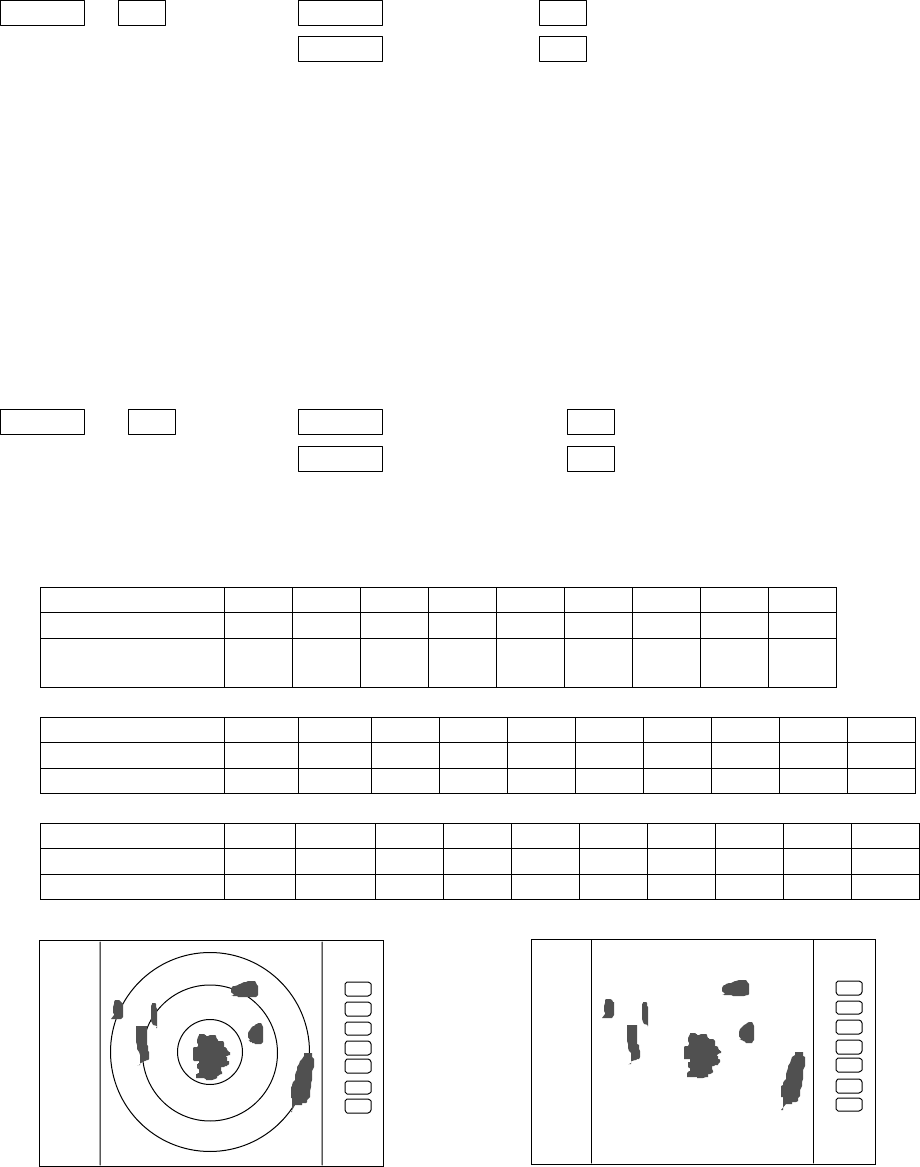
50
Up/Down → ENT →Up/Down (Select ON) →ENT -----------------------Parallel cursor appears
(Select ///CSR) µ>Up/Down (Select OFF) →ENT -----------------Parallel cursor non-appears
Note: Interval of ///CSR same as fixed range marker.
///CSR moves with EBL1.
5.5.1.9 Establishment of the indication of the RANGE RINGS (RINGS)
(1) Use the up-down cursor key to select RINGS from among the pull-down and display items, and
press the “ENT” key.(ON/OFF displayed beside the RINGS item)
(2) Use the up-down key to select ON or OFF and press the “ENT” key
Select ON Range Rings ON
Select OFF Range rings OFF
Up/Down → ENT --→Up/Down (Select ON) →ENT -----------------Range rings appears
(Select RINGS) µ>Up/Down (Select OFF) →ENT -----------Range rings non-appears
•Number of range rings and range interval
•Radome antenna (RA40C)
Range 0.125 •0.25 0.5 0.75 1.5 3 6 12 24
Number of Rings222366666
Interval 0.062
5
0.125 0.25 0.25 0.25 0.5 1 2 4
Radome antenna (RA41C)
Range 0.125 0.25 0.5 0.75 1.5 3 6 12 24 36
Number of Rings 2 2 23666668
Interval 0.0625 0.125 0.25 0.25 0.25 0.5 1244
Open antenna (RA42C)
Range 0.125 0.25 0.5 0.75 1.5 3 6 12 24 48
Number of Rings 2 2 23666668
Interval 0.0625 0.125 0.25 0.25 0.25 0.5 1246
5.5.1.10 Variable range function ( VAR RNG )
Usually the range changes in steps as 0.5--0.75--1.5--3.0--....., but using this function will
enable a consecutive change such as 0.5--0.6--0.7--0.8--..... .
(1) Use the up-down cursor keys to select VAR RNG from among the pulled down and displayed
.75
.25
HU
.75
.25
HU
Range rings Range rings OFF

51
items, and press the "ENT" key.
(2) When ON is selected with the up-down cursor key from the ON/OFF display beside the VAR
RNG item, and the "ENT" key is pressed, the VAR RNG function becomes valid and VAR will
be displayed at the upper left of the screen (beside MODE).
Setting procedure
Up/Down → ENT → Up/Down (Select ON) → ENT VAR RNG function is turned ON
(Select VAR RNG) µ> Up/Down (Select OFF) → ENT VAR RNG function is turned OFF
(3) The range changes continuously with pressing the up-down cursor while the VAR RNG
function is on, and it changes in steps with the "RANGE UP" or "RANGE DOWN" keys.
Method of use
Up/Down ------------------------------------------- Range changes continuously
RANGE UP & RANGE DOWN -------------- Range changes in step
(4) To cancel the vari-range function, press a key except "RANGE UP" and "RANGE DOWN" key.
When use the function, follow from (1) again.
5.5.1.11 Output the position data of Cursor ( TARGET )
Place the cross cursor to the position that is to output position data with up-down and left-
right key.
Use the up-down cursor keys to select TARGET from among the pull-down display items, and
press the "ENT" key. The L/L data of the position will be output to NMEA port with TLL format.
Up/Down →••• •............................................ output the L/L position of the cursor
(Select TARGET)
Note: When activate this function, nothing happens on the screen.
5.5.1.12 Follow the Distance and Bearing marker on the cursor (+MK LINE)
(1) Use the up-down cursor keys to select +MK LINE from among the pulled down and displayed
items, and press the "ENT" key.
(2) When ON is selected with the up-down cursor key from the ON/OFF display beside the +MK
LINE item, and the "ENT" key is pressed, the +MK LINE function becomes valid, and
distance/bearing marker will be displayed at the cross cursor.
Setting procedure
Up/Down → ENT → Up/Down (Select ON) → ENT +MK LINE function is turned ON
(Select +MK LINE) µ> Up/Down (Select OFF) → ENT +MK LINE function is turned OFF
(3) The distance/bearing marker follows to the cross cursor until +MK LINE function is turned
OFF.
.75
.25
HU
.75
.25
HU
52
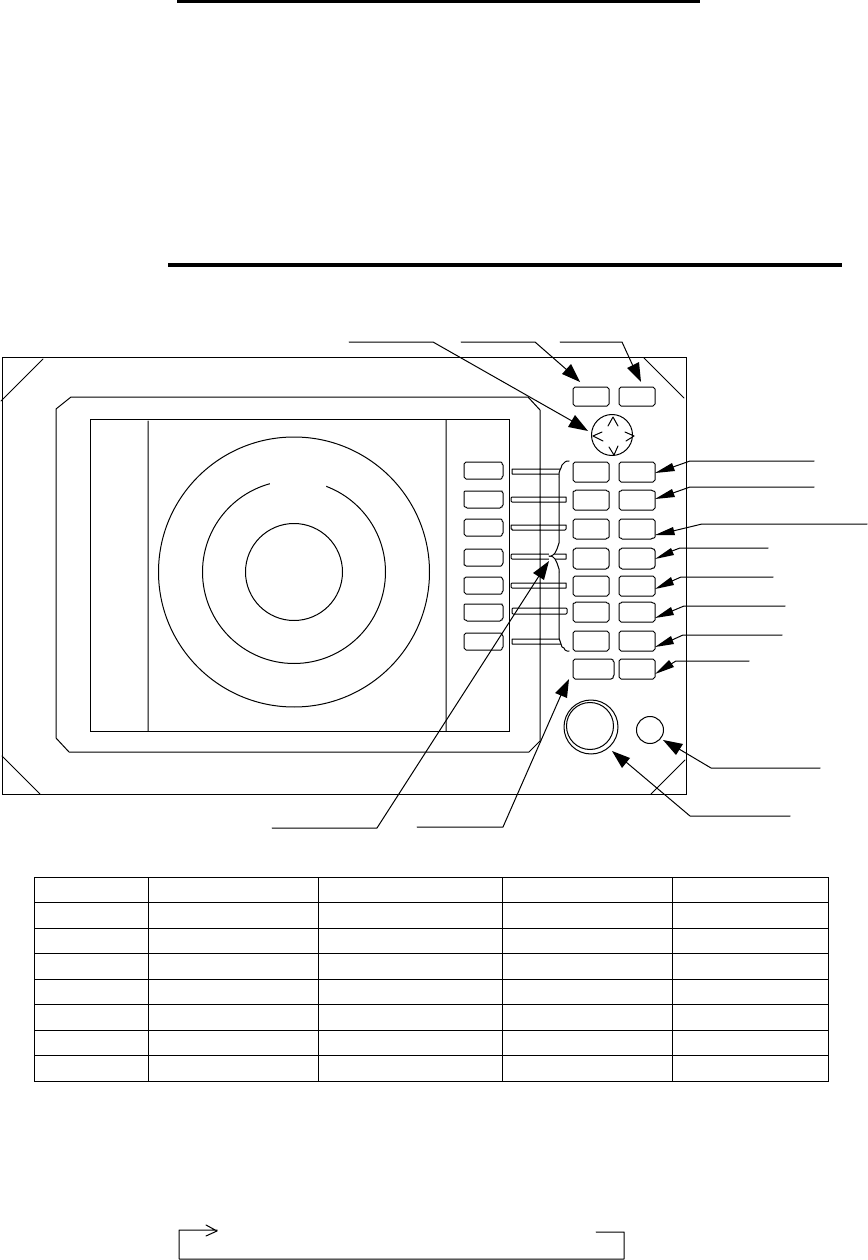
25
CHAPTER 4. FUNCTIONS AND NAMES
Function and name of each part
The RA40C/41C/42C radar consists of a display unit to display video images on a
screen and a scanner unit configured with an antenna to radiate radio waves and other
components. The display unit has on its front panel eighteen(18) push-switch keys and
one cursor key that lets you move a cursor in any desired direction. A combination of
these keys allows you to utilize all functions of your radar, providing a comfortable, easy
way to operate.
4.1 Key layout
Key No. SET1 SET2 SET3 SET4
1 EBL1 EBL2 RINGS PPI
2 VRM1 VRM2 TUNE PPI/3D
3 VAR RNG FL EBL2 ST PPI/PPI
4 TRACK FL VRM2 ZOOM PPI/NAV
5 TARGET GZ SLEEP ALL PPI
6 SEL WIN OFF-C PICTURE ALL PPI2
7 NEXT NEXT NEXT NEXT
Tab. 5 Function of soft key (Factory setting)
*Every time Next key is pressed, soft key group switches as follows.
Cursor ke
y
MENU ke
y
ENT ke
y
3
1
HU s RANGE
UP
RANGE
DOWN
BRILL
AUTO
GAIN
STC
FTC
MOB
1
2
3
4
5
6
7
POWER
ENT
MENU
MOTOR
1:58
+
POWER key
Soft ke
y
s(* )
RADAR OFF
Scanner
Motor fuse
Control knob
RANGE Up key
RANGE Down key
BRILL key( Contrast
Brilliance, keys backlight)
AUTO key
GAIN key
STC key
FTC key
MOB key
SET1 → SET2
→ SET3
→ SET4
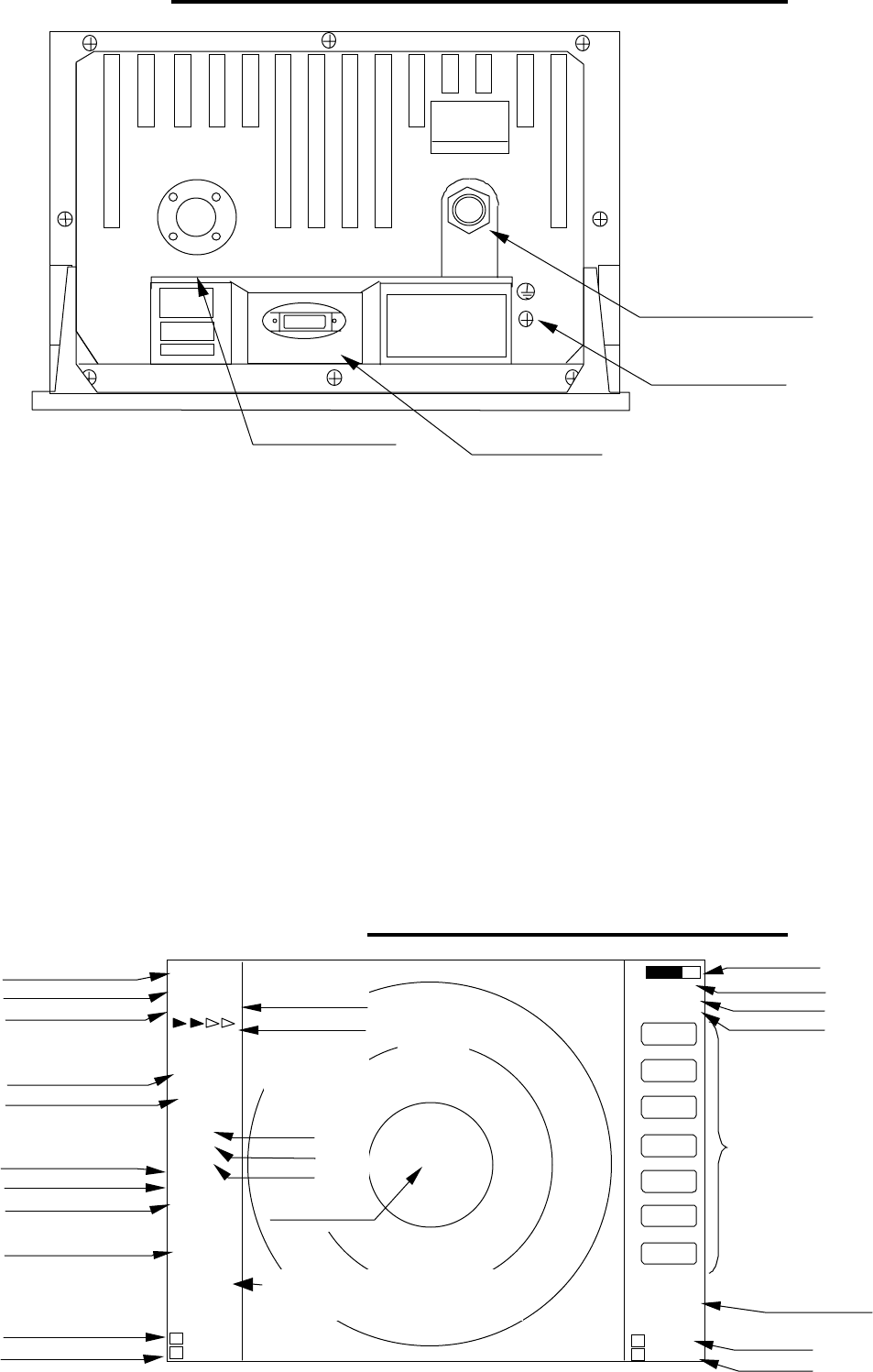
26
4.2 Rear panel
!
!!
! Power supply connector
Use this connector to plug in the power supply cable. Standard NMEA interface
terminal is included in this connector. Refer to Section 3.7 “ Connecting Cables “
and Section 3.9 “Connecting External Equipment to Display Unit “.
"
""
" Grounding terminal
Use this terminal to connect grounding wire. Refer to Section 3.7 (3) “Grounding
wire”.
#
##
# Option connector
Use this connector to connect NMEA, an external monitor, external buzzer and
GYRO I/F. A dedicated cable or dedicated module box is required to connect these
pieces of equipment. Refer to Section 3.9 “Connecting External Equipment to
Display Unit”.
$
$$
$ Scanner connector
Use this connector to plug in the inter-connecting cable to connect the scanner
unit.
Refer to 3.7 “Connecting cable “.
4.3 Radar screen•Single screen•
SCANNER POWER
OPTION
Ship’s position
EBL2
VRM2
Indicate soft key
3
1
HU L
1:58
+
RADAR OFF
EBL1
VRM1
EBL2
VRM2
FL EBL2
FL VRM2
NEXT
A
HOLD
ZOOM
OFF-C
LAT/LON
35°08 D
42N
139°02 D
53E
2 129 D
8°
212
D
34NM
0.23NM
HDG
129.0
°T
SPD
12.0 KT
G 59
S AT
F AT
ST1
GZ IN
TK 15 S
WP
134.4 °
12.5NM
+LAT/LON
35°08.42N
139°02.53E
1 129.8°
1 12.3NM
Tune meter
Picture hold
Zoom
Off-center
Range
Range ring interval
Display mode
Heading angle
Cruising speed
Enlarging echo
Guard zone
Track
Way point
EBL1
VRM1
Pulse width
Course error
Gain
STC
FTC
Cross cursor
Cross cursor position
(LAT/LON or Distance/Bearing j
!Power supply connector
"Grounding terminal
$Scanner connector #Option connector
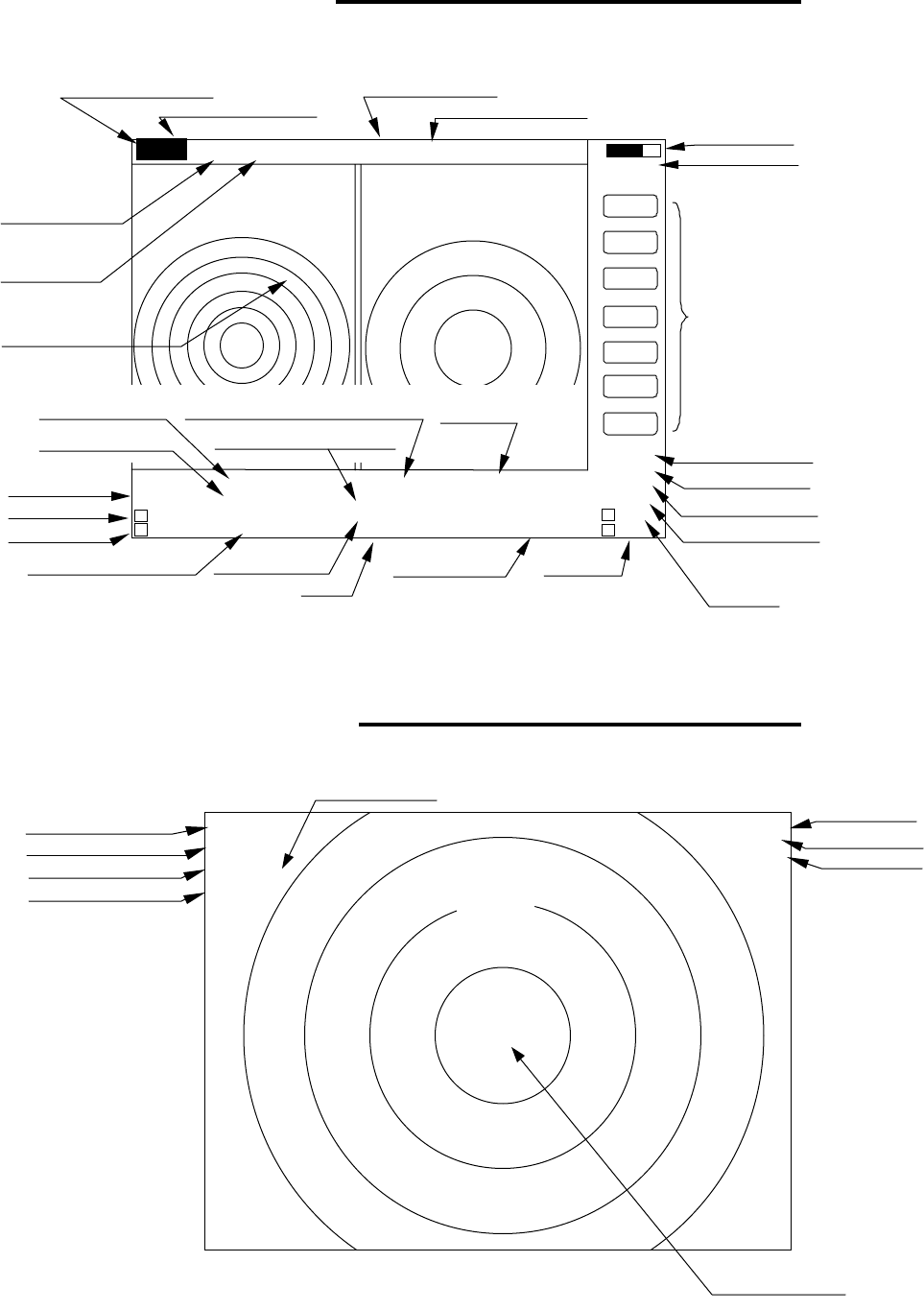
27
4.4 Radar screen (Dual screen)
ex) PPI/PPI screen
4.5 Radar screen (All PPI screen)
Tune meter
Picture hold
Indicate soft key
SPD 12.8KT GZ R IN WAY P 134.4°
HDG 129.2° GZ L IN 12.5NM
+MK 38.4° ST1 LAT 35°08.42N 2 129.8 ‹
5.28 TK 15S LON 139°02.53 ‚d
2 3.62NM
6 1.0_ HU L .75
.25
EBL1
VRM1
EBL2
VRM2
FL EBL2
FL VRM2
NEXT
A
HOLD
0.23
XTE >>>
1 129.8°
1 12.34NM
AT1
G 59 / AT
S AT / AT
F AT / AT
Range(Left screen) Range(Right screen)
Range ring interval Range ring interval
(Left screen) (Right screen)
Display mode
Pulse width
Cross cursor
Course error
EBL1
VRM1
+
Cruising speed Guard zone(Right screen) Way point
Heading angle Guard zone(Left screen)
Cross coursor position Enlarging echo Ship’s position VRM2
(LAT/LON or Distance/Bearing) Track EBL2
AUTO (Left/Right)
Gain (Left/Right)
STC (Left/Right)
FTC (Left/Right)
3
1
HU L
GZ IN 1:58
+
RADAR OFF
OFF-C
HOLD
ZOOM
Off-center
Picture hold
Zoom
Range
Range ring interval
Display mode
Guard Zone
Pulse width
Cross cursor
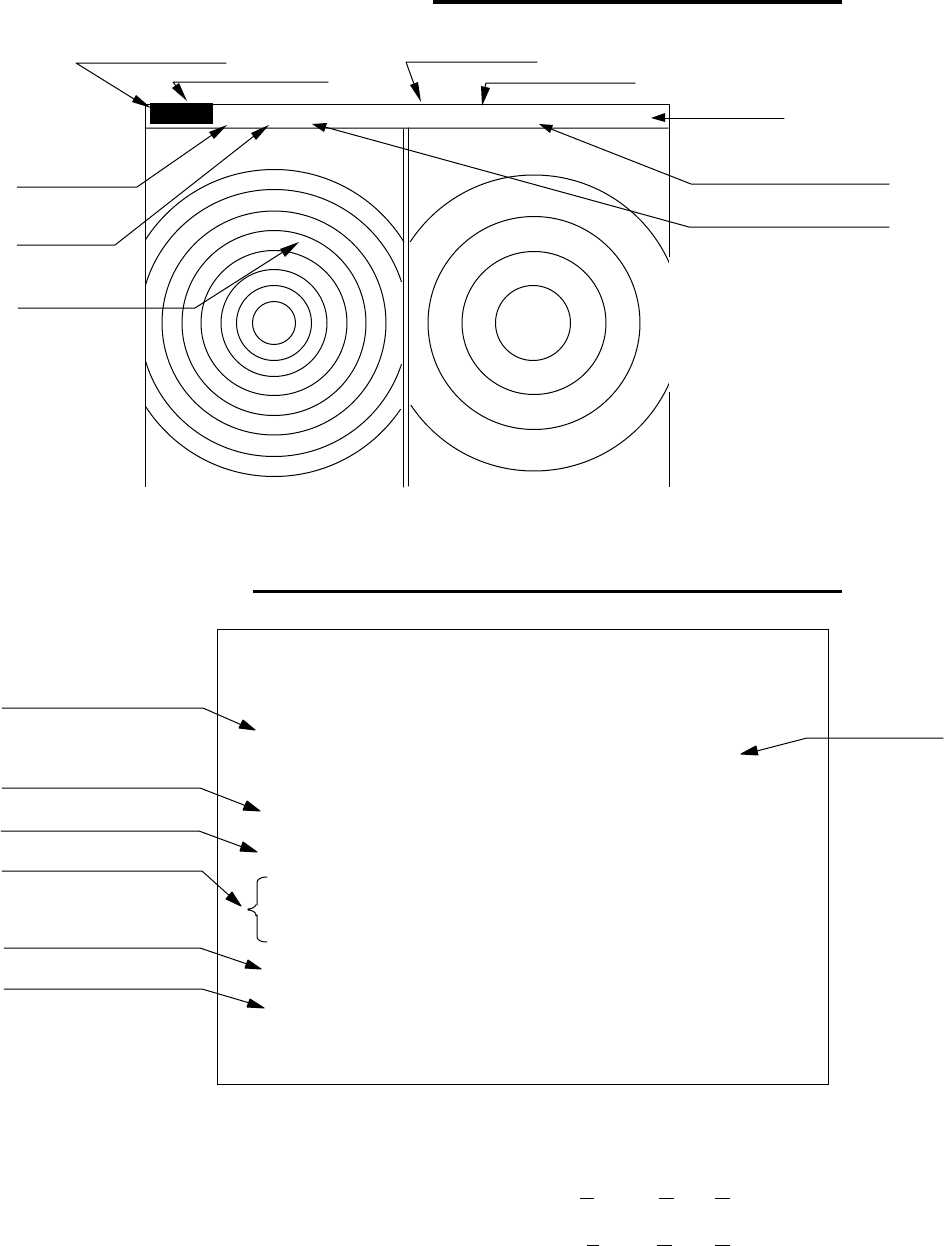
28
4.6 Radar screen (All PPI /PPI screen)
4.7 Navigation screen
It is necessary that navigation equipment such as a GPS is connected to your
radar, this screen displays the position and cruising speed of your ship, seawater
temperature, and other navigation information.
Note: Heading angle will be displayed "COG" when Course Over Ground data is
used.
Note: Cruising speed will be displayed "SOG" when Speed Over Ground data is
used.
Picture hold
Gurad zone(Right screen)
Guard zone(Left screen)
6 1.0_ HU L GZ IN .75
.25 GZ IN HOLD
Range(Left screen) Range(Right screen)
Range ring interval Range ring interval
(Left screen) (Right screen)
+
Display mode
Pulse width
Cross cursor
NAV DISPLAY
WP 134.4°
°°
°COURSE
12.5NM >>>
HDG 129.0°
°°
°0.23NM
SPD 12.8KT
LAT 35°
°°
°08.42N
LON 139.02.53E
TEMP 20.5°
°°
°C
DEPTH 93.2MST’BY
Way point
Heading angle
Cruising speed
Current position
Sea water temperature
Depth of water
Course error
@@
(XTE)

29
> Indicates starboarding the helm
(right)
< Indicates porting the helm (left)
Deviation from course Indication mark
0.00 -- ><
0.02 -- > or <
0.04 -- >> or <<
0.08 -- >>> or <<<
0.16 -- >>>> or <<<<
Tab.6 Indication of deviation from course
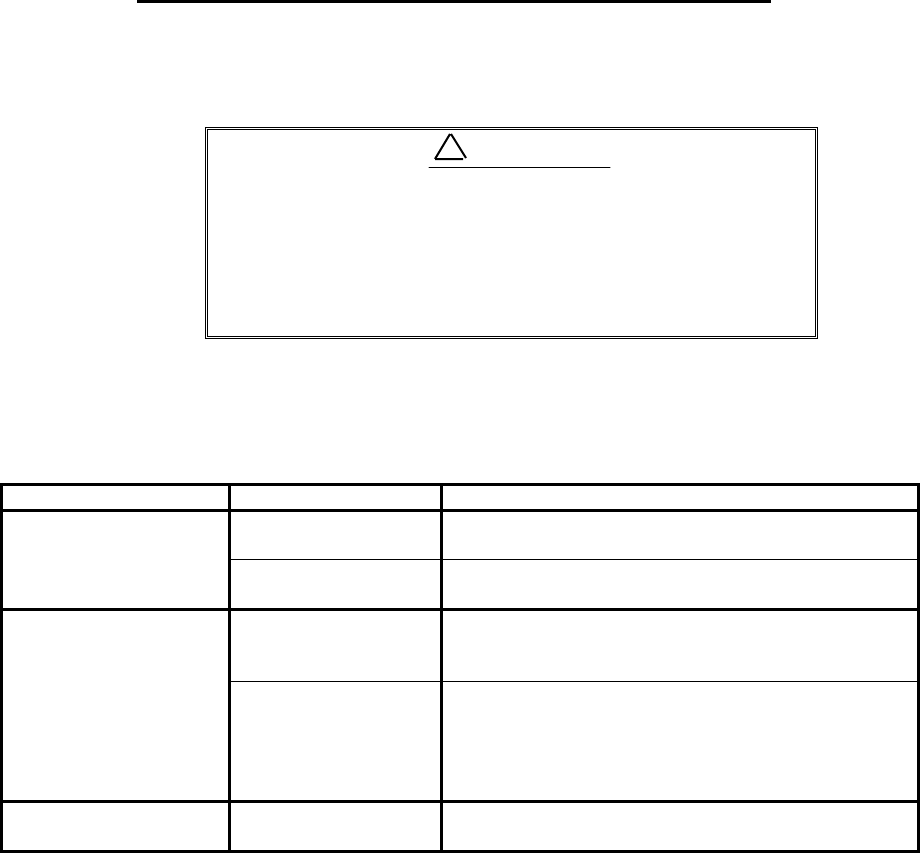
79
CHAPTER 6. MAINTENANCE AND INSPECTION
Most of maintenance of this radar should be referred to qualified personnel. If
radar has any problem, contact your dealer and tell us that problem.
There are high voltage circuits inside of this radar.
Do not attempt to open the rear cover of display
unit or disassemble internal parts. When you open
the radome, power must be off.
Even power switch is OFF, this radar is still sup-
plied power inside.
The following table shows the maintenance by user. Please check periodically.
Tab. 6-1 Maintenance
*: Use grease for plastics for RA40C/41C. If you use other type of grease(not for plastics),
it may break antenna
Concerning Consumable
The radar uses consumable as listed below that require periodic replacement.
(1) Magnetron
This part is mounted in the scanner unit. If distant echo images have
become less visible, the magnetron probably may have degraded. In such a
case, replace it. Consult your distributor for replacement of this part.
Period of the replacement : 3000hour(typ.) (500hour guarantee)
(2) LCD back-light
This part is mounted in the display unit. If the display screen is ex-
tremely dark and its illumination cannot be corrected by adjusting bright-
ness, the LCD back-light may be faulty or may have burnt out. In such a
case, replace it. Consult your distributor for replacement of this part.
Period of the replacement : 15000hour(typ.) (1000hour at 0•)
Inspection Interval Inspection Item Method of Inspection and Maintenance
3-6 months Rust and looseness
in scanner unit Check whether the scanner’s fitting bolts are
corroded or less.
Display screen of
LCD display Clean filter and LCD screen surfaces with a
soft and wet cloth.
6-12 months Grease* application
to antenna drive
gear
Apply an even coating of grease* to the entire
surface of the antenna drive gear with a spat-
ula or brush.
Check for contact
of connectors Check whether connectors are contacted
properly. If any connector is improperly con-
tacted or stained, correct it by using a contact
restoring chemical agent or by polishing or
replace with a new one if necessary.
Antenna motor
brush(RA42C) Check the length of brushes. If the length is
under 6mm, change them to new one.
!WARNING
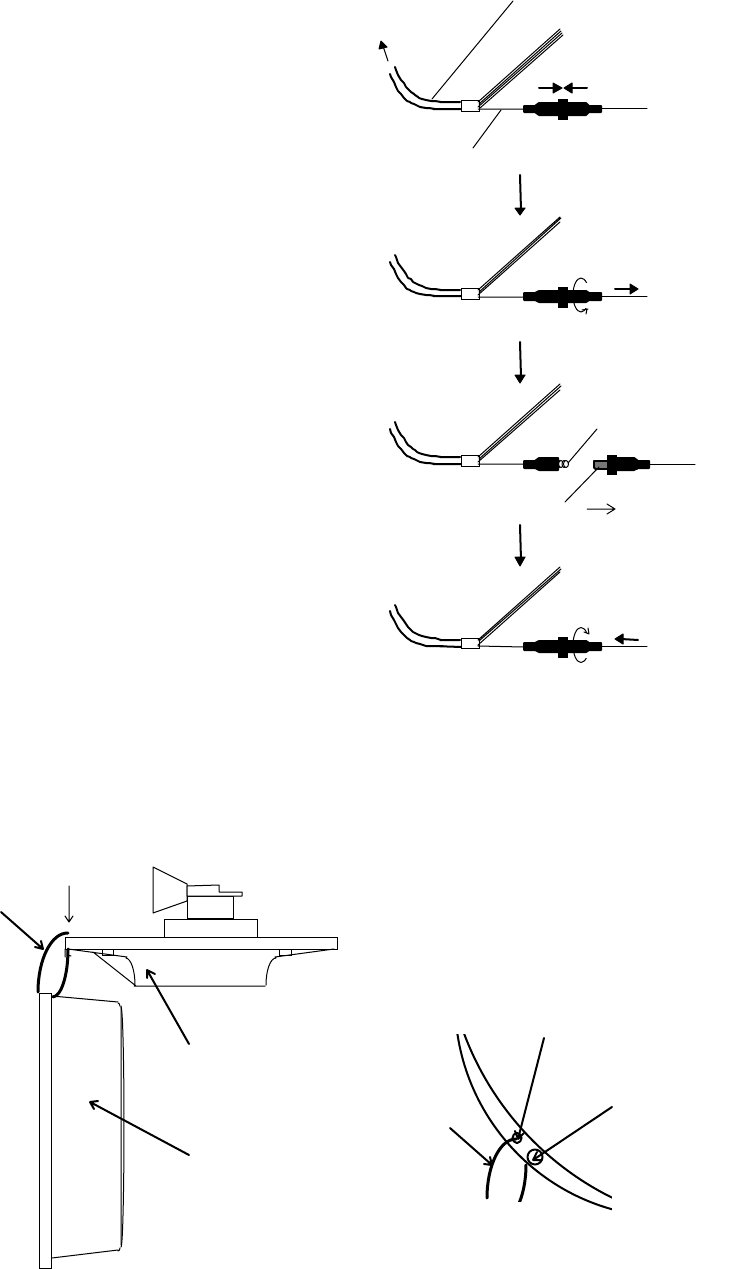
80
(3) Fuse The fuse is built in
the power supply cable.
If the fuse appears to be
blown, check the fuse. If
blown, replace it
following the procedure
shown in Fig.6-2.
Note: Before maintenance of scanner, you can hang a radome(upper) using cord
through hole as follows.
Fig. 6-3 Method for replacing fuse
Push
Power supply cable
Wire(White)
Turn counterclockwise
and pull
Fuse
Spring
Push and turn clockwise
Replace new fuse
To dis
p
la
y
unit
Fig. 6-2 Method for replacing fuse
Fixing screw
Hole
A: Top view
Cord
Cord
A
Radome(Upper)
Radome(bottom)
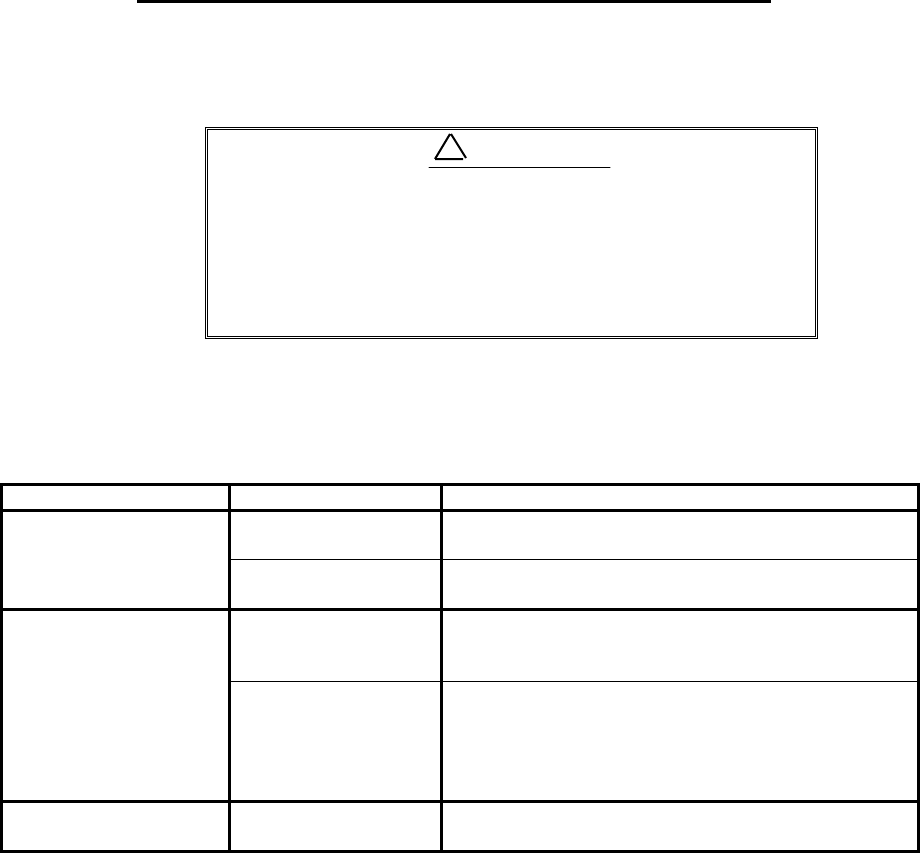
79
CHAPTER 6. MAINTENANCE AND INSPECTION
Most of maintenance of this radar should be referred to qualified personnel. If
radar has any problem, contact your dealer and tell us that problem.
There are high voltage circuits inside of this radar.
Do not attempt to open the rear cover of display
unit or disassemble internal parts. When you open
the radome, power must be off.
Even power switch is OFF, this radar is still sup-
plied power inside.
The following table shows the maintenance by user. Please check periodically.
Tab. 6-1 Maintenance
*: Use grease for plastics for RA40C/41C. If you use other type of grease(not for plastics),
it may break antenna
Concerning Consumable
The radar uses consumable as listed below that require periodic replacement.
(1) Magnetron
This part is mounted in the scanner unit. If distant echo images have
become less visible, the magnetron probably may have degraded. In such a
case, replace it. Consult your distributor for replacement of this part.
Period of the replacement : 3000hour(typ.) (500hour guarantee)
(2) LCD back-light
This part is mounted in the display unit. If the display screen is ex-
tremely dark and its illumination cannot be corrected by adjusting bright-
ness, the LCD back-light may be faulty or may have burnt out. In such a
case, replace it. Consult your distributor for replacement of this part.
Period of the replacement : 15000hour(typ.) (1000hour at 0•)
Inspection Interval Inspection Item Method of Inspection and Maintenance
3-6 months Rust and looseness
in scanner unit Check whether the scanner’s fitting bolts are
corroded or less.
Display screen of
LCD display Clean filter and LCD screen surfaces with a
soft and wet cloth.
6-12 months Grease* application
to antenna drive
gear
Apply an even coating of grease* to the entire
surface of the antenna drive gear with a spat-
ula or brush.
Check for contact
of connectors Check whether connectors are contacted
properly. If any connector is improperly con-
tacted or stained, correct it by using a contact
restoring chemical agent or by polishing or
replace with a new one if necessary.
Antenna motor
brush(RA42C) Check the length of brushes. If the length is
under 6mm, change them to new one.
!WARNING
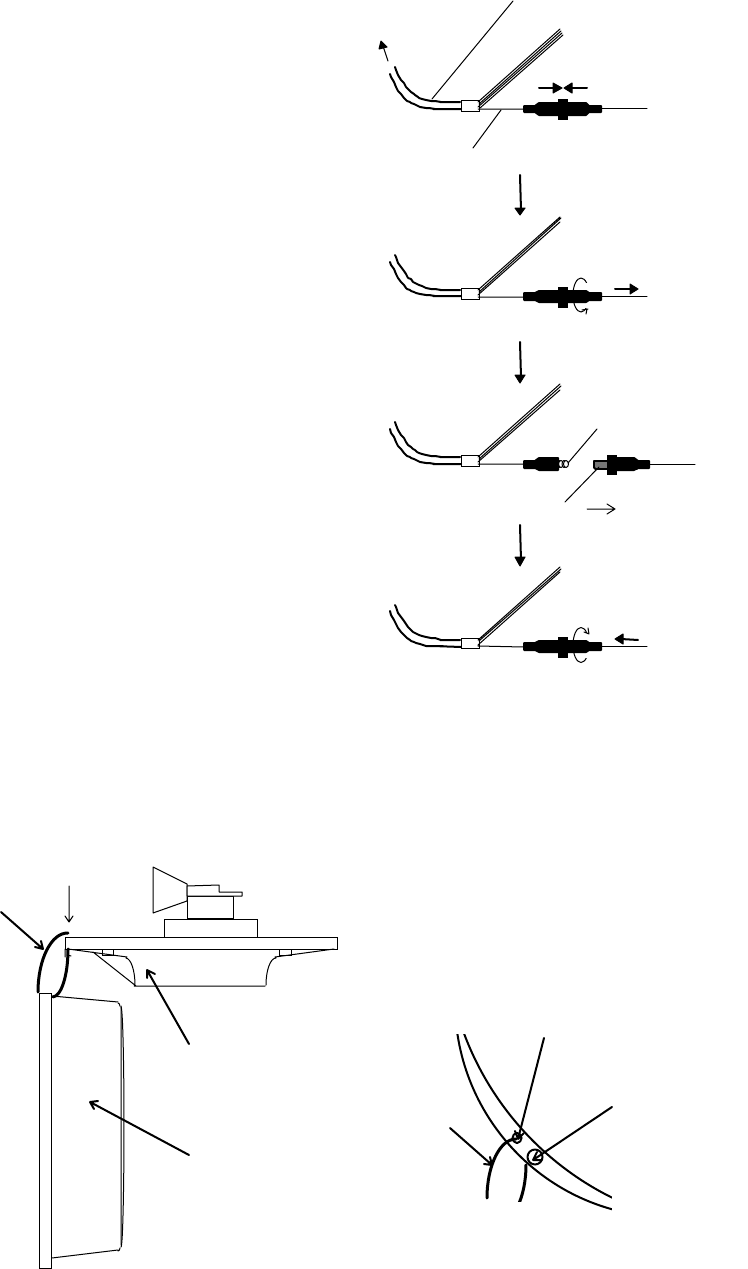
80
(3) Fuse The fuse is built in
the power supply cable.
If the fuse appears to be
blown, check the fuse. If
blown, replace it
following the procedure
shown in Fig.6-2.
Note: Before maintenance of scanner, you can hang a radome(upper) using cord
through hole as follows.
Fig. 6-3 Method for replacing fuse
Push
Power supply cable
Wire(White)
Turn counterclockwise
and pull
Fuse
Spring
Push and turn clockwise
Replace new fuse
To dis
p
la
y
unit
Fig. 6-2 Method for replacing fuse
Fixing screw
Hole
A: Top view
Cord
Cord
A
Radome(Upper)
Radome(bottom)

81
CHAPTER 7. TROUBLESHOOTING
This chapter explains how to identify trouble locations when the radar is found
faulty and how to request repair.
It happens any disorder, keep pressing POWER key for 3 sec. to power off. Then
wait over 10 sec., when you power on again.
If you find the radar is faulty, check it the following procedure described below.
If you find as a result of inspection that the fault cannot be repaired on board, con-
tact your distributor for repair.
For faster service, please let us know about followings when you request repair:
(1) Ship's name, place of anchorage, allowable repair period or time
(2) Radar type (This radar is RA40C, RA41C or RA42C.)
(3) Manufacturing number (indicated on the back of the display unit)
(4) Fault symptoms and inspection results
There are high voltage circuits inside of this radar.
Do not attempt to open the rear cover of display
unit or disassemble internal parts. When you open
the radome for installation, power must be off.
Even power switch is OFF, this radar is still sup-
plied power inside.
This chapter explains how to identify trouble locations when the radar is found
faulty and how to request repair.
7.1 Fault Diagnosis by Self-check
The radar incorporates a failure diagnostic function (called "self-check") to diag-
nose faults by the equipment itself.
Refer to "5.5.4.4 Fault Diagnosis by Self Check (SYSTEM CHECK)" and check
whether there is any fault in your radar.
7.2 Inspecting Each Part
!WARNING

82
When you have finished self-check, inspect each part of the radar according to
Tab.7-1.
Tab. 7-1 Troubleshooting
Symptom Cause Corrective action
(1) Radar cannot be powered
on. Power cable is disconnected. Connect power cable correctly.
Power supply voltage is off
specified value Use Specified power supply.
(See Section 3.2)
Fuse in power cable is blown. Replace fuse. (See Chapter 6)
(2) Nothing is displayed al-
though radar is powered on. Brightness or contrast are im-
properly adjustment. Use BRIL key to adjust. (See
Section 5.3.)
LCD is faulty. Contact your dealer.
(3) Screen is dark. Brightness is improperly ad-
justed. Use BRIL key to adjust. (See
Section 5.3.
Backlight is faulty. Contact your dealer.
(4) Video does not appear al-
though characters are displayed. Interconnecting cable is out of
place. Connect interconnecting cable
correctly.
(5) Echo image on screen differs
from actual image. Ship’s heading is incorrectly set. Set ship’s heading correctly.
(See Section 5.5.4.5.4)
Timing adjustment is incorrectly
set. Set timing adjustment correctly.
(See Section 5.5.4.5.4)
(6) Echo images are blurred. GAIN, STC, or FTC is improp-
erly set. Adjust. (See Section 5.3.6 to
5.3.8.)
Magnetron has degraded. Contact your dealer.
(7) Too much noise. Radar is not tuned correctly Adjust TUNE. (See Section
5.5.3.4)
Radar is not grounded to earth. Connect grounding wire. (See
Section 3.4 to 3.6.)
(8) Not responded when key is
pressed. Panel keys are not contacting. Contact your dealer.
Power supply circuit is faulty. Contact your dealer.

83
CHAPTER 8. PRODUCT SPECIFICATIONS
8.1 General
Type: RA40C, RA41C and RA42C
Power supply voltage and power consumption
••••Power supply voltage: 24Vdc (nominal)
(10.2 to 41.6 Vdc)
••••Power consumption: 55 W or less (RA40C/41C)
70 W or less (RA42C)
Distance range: 0.125 to 24 NM, 9 ranges
(RA40C)
0.125 to 36 NM, 10 ranges
(RA41C)
0.125 to 48 NM, 10 ranges
(RA42C)
(Continual variable range also
possible)
Distance resolution: Within 30 m (RA40C)
Within 25 m (RA41C/42C)
Distance accuracy: Better than 0.9% of
maximum range of the scale in use, or
8m, whichever is the greater
Minimum detecting distance: Within 30 m (RA40C)
Within 25 m (RA41C/42C)
Bearing resolution: Within 7.5°(RA40C)
Within 4.5° (RA41C)
Within 3.0° (RA42C)
Bearing accuracy: 1° or less
Warm-up time: 2 minutes
Environment conditions
•••Ambient temperature range (S/U): -25 to 55 °C
(D/U): 0 to 55 °C
Humidity: 93% RH at +40 °C
Vibration: (S/U): 3 mm( 300 to 500 rpm)
1.2 mm(500 to 1500 rpm)
0.3 mm(1500 to 3000 rpm)
14.7m/s2(1.5G) Resonance
test (D/U): 3 mm(300 to 500 rpm)
0.75 mm(500 to 1500
rpm) 0.2 mm(1500 to 3000
84
rpm)
Wind resistance: 100 knots (max.)
Waterproof standard: (D/U): IPX-5
(S/U): IPX-6
Interconnecting cable: 30 m in max. (RA40C)
100 m in max. (RA41C/42C)
Noise: (D/U): 65 dB or less
(S/U): 65 dB or less (RA40C/41C)
(S/U): 70 dB or less (RA42C)
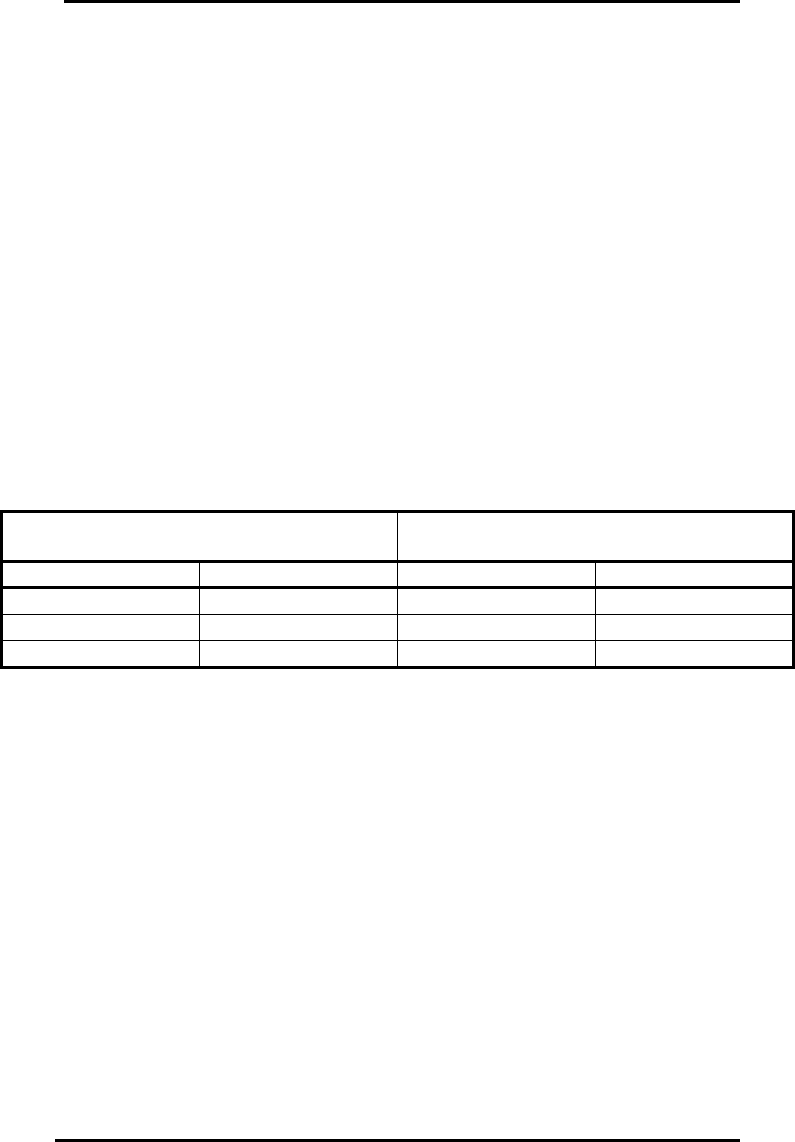
85
8.2 Scanner Unit
Type: RB714A (RA40C)
RB715A (RA41C)
RB716A (RA42C)
Antenna type: Parabolic (RA40C)
Slotted-array (RA41C/42C)
Antenna characteristics
Beam width (horizontal): 6.0° ± 1.0° (RA40C)
3.9°(RA41C)
2.5° ± 0.3°(RA42C with
3ft antenna)
1.8° ± 0.2° (RA42C with
4ft antenna)
Beam width (vertical): 25° (typ.) (RA40C/41C)
22° (typ.) (RA42C with
3/4ft antenna)
Pulse width and peak power output:•
RA40C RA41C/42C
Pulse width (µsec) Peak Power (kW) Pulse width (µsec) Peak Power (kW)
0.12 ± 0.02 1.5 (±50% ) 0.08 4 (-50% to +20%)
0.3 ± 0.05 2.0 (±50% ) 0.25 4 (-50% to +20%)
0.8 ± 0.1 2.0 (±50% ) 0.8 4 (-50% to +20%)
Radio wave type and frequency: P0N, 9445 ± 30 MHz (RA40C)
P0N, 9410 ± 30 MHz
(RA41C/42C)
Antenna revolution: 24 rpm ± 20%
Transmit/receive switching: Magic T and limiter type
(RA40C)
Circulator and limiter type
(RA41C/42C)
Intermediate frequency: 60 MHz
(logarithmic amplifier)
Noise figure: 6.5 dB or less
8.3 Display Unit
Type: RF719A
Indication system: PPI, PPI+semi-3D,
Split radar range
Indicator: 10-inch color LCD(TFT)
640 x 480 dots
Four(4 ) levels

86
Cursor Control: Analog cursor key
and rotary encoder
VRM: 2 lines (One line can be offset.)
Unit of distance can be
selected from NM, KM, and
SM.
EBL: 2 lines (One line can be offset.)
Display modes: HU, HS, NU, CU, and TM
Off-center: Can be 100% off-centered over
the full range.
Guard zone: Can be set at any desired
distance and angle in any
desired width. IN and OUT
modes are available.
Stretch: 2 modes
Echo track: 15, 30 sec, 1, 3, 6 min. and
continuous.
Other functions: Interference rejection, Zoom,
Sleep mode,
Hold mode, Course error
display,
Parallel cursors, Stern marker,
and Navigation data display
mode
Panel brightness: 4 levels
Language support: Chinese, Danish, English,
French, German, Greek,
Italian, Japanese, Korean,
Norwegian, Portuguese,
Russian, Spanish, Swedish,
and Turkish
8.4 External Interface
NMEA0183: 2 channels
(One standard channel;
Optional cable is required for
2nd-channel connections)
L / L GGA, GLL, RMA, RMC
Heading HDT, HDG, HDM, HSC,
VHW, VTG
Speed VHW, VTG, RMA, RMC
Way point RMB, BEC, BWC,
BWR, BER, BPI
Depth DBT, DPT
Course error RMB, XTE

87
Seawater temperature MTW
Others (using optional cable):
External buzzer control output, Auxiliary indicator connecting signal
output and input, Bow direction signal input(SIN/COS signals), and
compass interface (10/12 bits serial)
8.5 Standard set
Display unit 1
Scanner unit 1
Display cover 1
Fuse 1 set
Interconnecting cable 1 (10m)
Power supply cable 1 (2m)
M10 hexagonal bolt 4 sets (for RA40C/41C)
M12 hexagonal bolt 4 sets (for RA42C)
8.6 Options
Interconnecting cable (15, 20, and 30 m for RA40C)
Interconnecting cable (15, 20, and 25 m for RA41C/42C)
Flush-mount installation kit
Junction box for external connection (with cable 1.5m)
Option connector kit 249J153058
8.7 External dimensions and weight
See APPENDIX
8.8 External Connection and function
X1 Connector for Option
pin No. Name function
1 NMEA2-A NMEA ch2 data input(A)
19 NMEA2-B NMEA ch2 data input(B)
2GND
20 EXBUZ+ Output for External Buzzer
3 EXBUZ- Output for External Buzzer
controlled ship's power output
21 VIDEO_IN Video input for Monitor operation
0 to -1V negative video, Zi = 50ohm
4 VIDEO_OUT Video output for External Monitor
0 to -1V negative video, Zo = 50ohm
22 GND
5 TRIG_IN Trigger signal input for Monitor operation
0 to 5V positive pulse, rising edge
23 TRIG_OUT Trigger output for External Monitor
0 to 5V positive pulse, rising edge
6 SHF_IN Heading signal input for Monitor operation
0 to 5V negative pulse, falling edge
24 SHF_OUT Heading signal output for External Monitor
0 to 5V negative pulse, falling edge
7 AZI_IN Bearing Pulse input for Monitor operation
0 to 5V positive pulse, rising edge
25 AZI_OUT Bearing Pulse output for External Monitor
88
0 to 5V positive pulse, rising edge
8GND
26 GYRCK+ Gyro Interface clock(+) input
9 GYRCK- Gyro Interface clock(-) input
apply 5V pulse between (+) and (-), isolated
27 GYRDT+ Gyro Interface data(+) input
10 GYRDT- Gyro Interface data(-) input
apply 5V pulse between (+) and (-), isolated
28 GND
11 MARK_I External Marker signal input, ex) Radar Buoy
negative video, 0 to -1V Zi = 50ohm
29 +12V External interface power, 100mA max.
12 SIN Compass Interface for SIN/COS type
30 COS Compass Interface for SIN/COS type
13 REF Compass Interface for SIN/COS type
SIN/COS signal: SIN = REF+/-1V, COS = REF+/-1V
31 -- not used
14 GND
32 NMEA_OUT NMEA data output, ex) MOB data, TARGET data